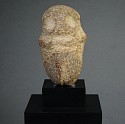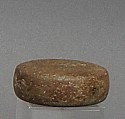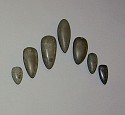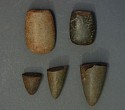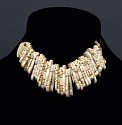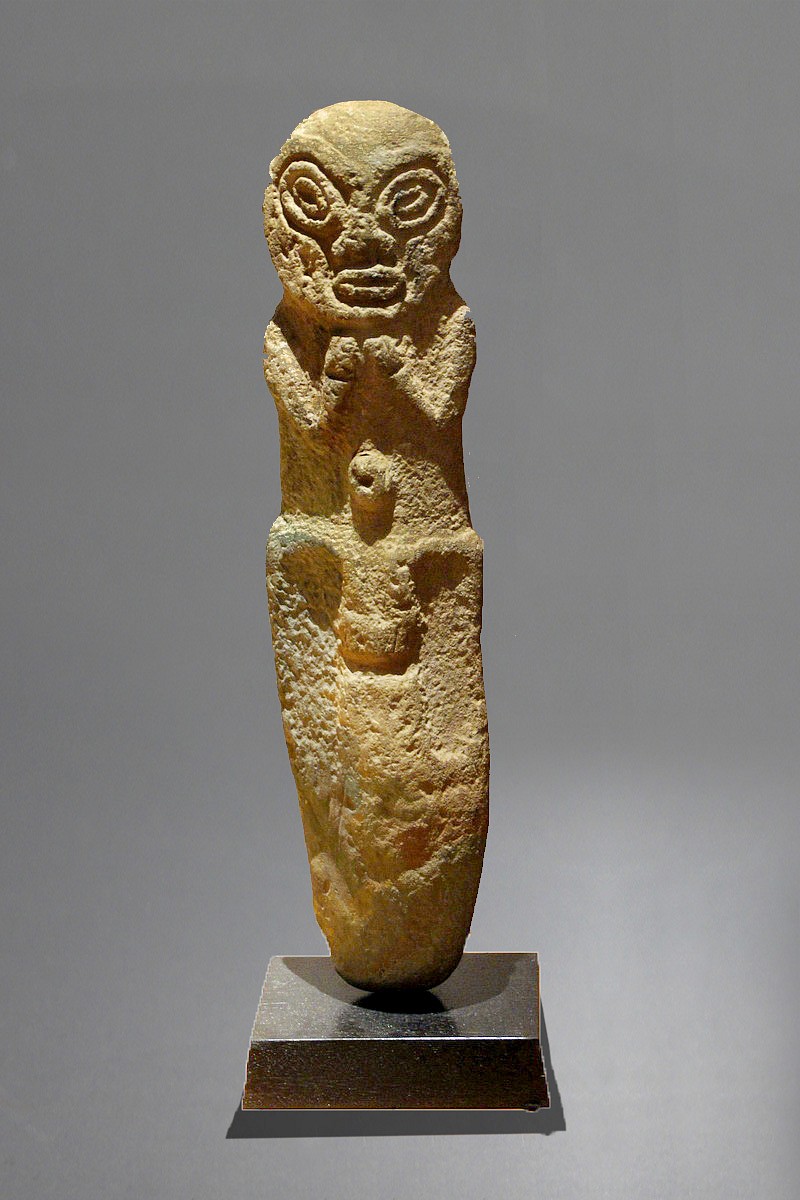



Dominican Republic, Large Taíno Carved Stone of a Deity
This deity has large, deeply carved, stylized eyes below an arched brow. His chin rests on arms held closely to his chest, and he sits on his haunches, with knees pointing forward and toes pointing downward. This classic contemplative pose appears in many early Taíno figurative sculptures, and is suggestive of the deity Baibrama, who symbolizes healing, renewal, and verdant crops. At the navel area is a protruding bellybutton, indicative of fertility. The prominent navel appears often as a theme in stone Pre-Taíno art. The bottom of the statue has been worn to a smooth taper for the purpose of setting the statue into the ground. Stone carvings taller than 15†are rare in Taíno art. The stones used by the Taíno to craft large figures were speleothems - rock formations found in caves, usually composed of limestone or dolomite. Most of these figures were used as perimeter markers that lined the ball courts of ancient Taíno centers in Puerto Rico and the Dominican Republic. Many of these figures are still in situ at archaeological sites with ball courts, such as Caguana (Puerto Rico) and the Corrado de los Indios (Dominican Republic). There are known carvings in caves in the region with similar facial features. The Metropolitan Museum of Art has a similar figure carved of sandstone.
Period: Dominican Republic, Taíno , c. AD 1000 - 1500
Media: Stone
Dimensions: Height: 23 5/8"
M7105
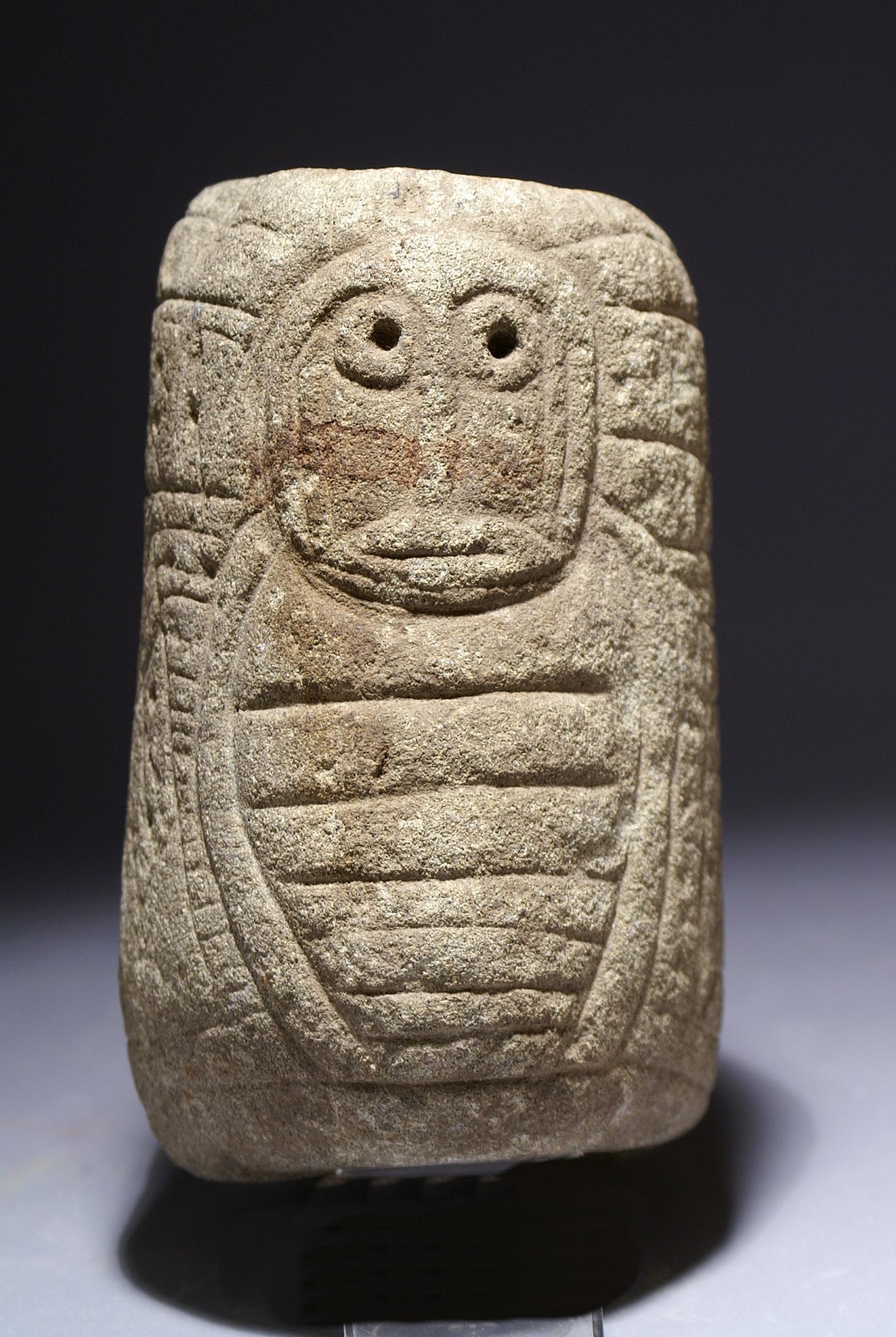




Dominican Republic, Taíno Stone Pillar Effigy with Incised Owls Front and Back
This stone effigy features abstracted owls carved on both the front and back. The owls have ribbed torsos and wings wrapped around the sides of the stone. Owls were considered spirits of the dead and were both feared and revered by the Taíno .
Period: Dominican Republic, Taíno , c. AD 1000 - 1500
Media: Stone
Dimensions: Height: 6 1/2" x Width: 5"
M3080

Dominican Republic, Taíno Stone Three-pointer of Yucahu, the Supreme Spirit
Known as triangulilitos, these three-pointed stones are unique to the Caribbean. Also known as zemis, they are symbolic of the spirit realm and the forces that imbue life with fertility. The large cone represents the primordial mountain rising from the ocean. This three-pointer portrays a zoomorphic figure with a crowned face and curled hind legs. The bat-like nose, which often occurs on three-pointers, has been identified as Yucahu, Lord of the Sky. Yucahu is the patron spirit of Yucca, the staple crop of Taíno agriculture. Large three-pointers belonged to elites and chiefs. The three-pointers were believed to bestow power, wisdom and a connection to the spiritual world on their owner, passed down from his ancestors. This three-pointer is carved of soft sandstone. The surface has been weathered by time. The tall cone and lack of detail indicate that this piece is from an earlier period prior to the Classic Taíno Period.
Period: Dominican Republic, Taíno , c. AD 1000 - 1500
Media: Stone
Dimensions: Length: 10" x Height: 9 1/2"
M3055
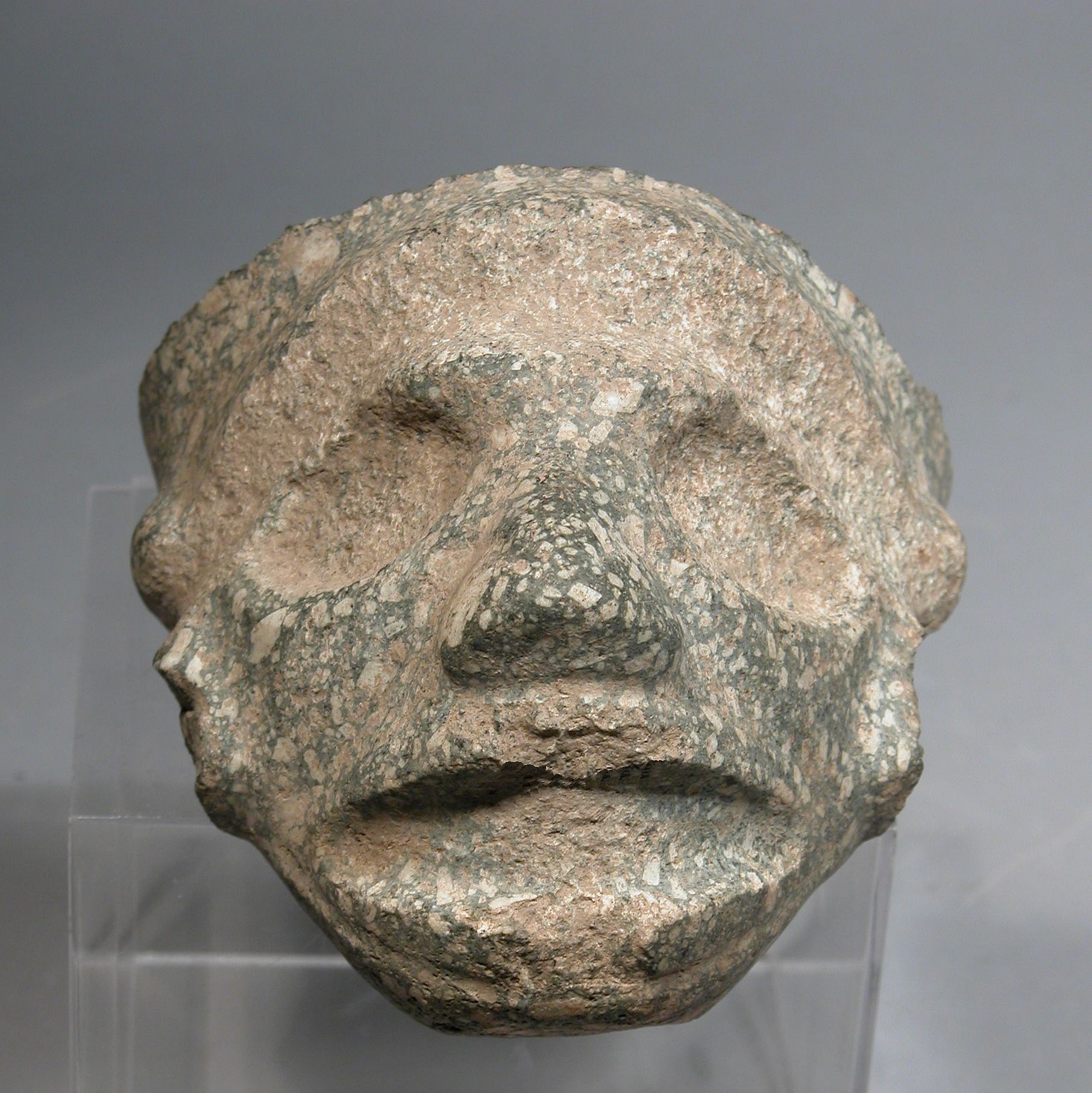



Dominican Republic, Taíno Stone Face to a Large Three-Pointer
This face is likely a fragment of a large three-pointer that was carved from speckled granite. The face is of the classic crowned style that most likely represents of the agricultural deity Yucahu, the supreme deity associated with the cassava harvest. The Taíno valued broken works, especially those believed to be endowed with a spiritual essence. A very similar fragment from Puerto Rico is in the Smithsonian Museum’s archives. This example is good for understanding how hard stone zemi were crafted, based on the view from the “killed” back.
Period: Dominican Republic, Taíno , c. AD 1000 - 1500
Media: Stone
Dimensions: Length from chin to forehead: 5 1/4"
Width from ear to ear: 6 1/2"
99208

Dominican Republic, Taíno Carved Stone Zemi Fragment of Type II
This incised three-pointer fragment falls into the Type 2 category of three-pointers which are typically anthropomorphic in their imagery. According to written Spanish accounts, these pieces were associated with fertility and were commonly stored in shrines associated with the cohoba ceremony, an ancient Taíno ritual in which participants consumed psychedelic snuff made from the Anadenanthera plant. This example is useful for authentication purposes, as it is well carved and reveals the inner carved structure..
Period: Dominican Republic, Taíno , c. AD 1000 - 1500
Media: Stone
Dimensions: Height: 2 1/2"
99256

Dominican Republic, Taíno "Problematic" Stone Representing a Manatee
This "problematic" stone was described b Fewkes in the Smithsonian's 34th Annual Report of the Bureau of Ethnography 1912-1913, p. 116-124. From the Dominican Republic, it represents a found object that was likely revered as a talisman of the volcano gods, which would explain why it was treasured by the Taíno. No two are alike.
Period: Dominican Republic, Taíno , c. AD 1000 - 1500
Media: Stone
Dimensions: Length: 7 1/2"
M2064






Dominican Republic, Taíno Stone Figure Fragment with Double Imagery
When standing upright, this fragment presents a figure of a crowned shaman in a trance with his arms to his chest. When viewed from the opposite side, the figure transforms into saurian creature with a pronounced spinal column, round deep-set eyes, and a wide, grimacing mouth. The figure is carved from a soft white stone and has been broken in half. This piece is a wonderful example of dualism in Taíno art.
Period: Dominican Republic, Taíno , c. AD 800 - 1000
Media: Stone
Dimensions: Length: 3 1/4"
M7163



Dominican Republic, Taíno Carved Stone Depicting a Large Eyed Abstract Figure
This deity figure has pecked ears, eye sockets, a simple mouth, and arms held to the sides with a vertical cut for the tapered legs. It may have been used as a personal talisman
Period: Dominican Republic, Taíno , Early Classic Period, c. AD 600 - 1000
Media: Stone
Dimensions: Height: 3" x Width: 1 1/4"
98237






Dominican Republic, Large Taíno Celt Carved with a Face
This ceremonial celt features a deity face, cone-shaped headdress, and hands held to stomach. Two similar celts are illustrated in Rene Herrera’s 1964 Estudio De Las Hachas Antillanas, p.140-144.
Period: Dominican Republic, Taíno , Early Classic Period, c. AD 600 - 1000
Media: Stone
Dimensions: Length 12" x 3" (30cm x 8cm)
N1042
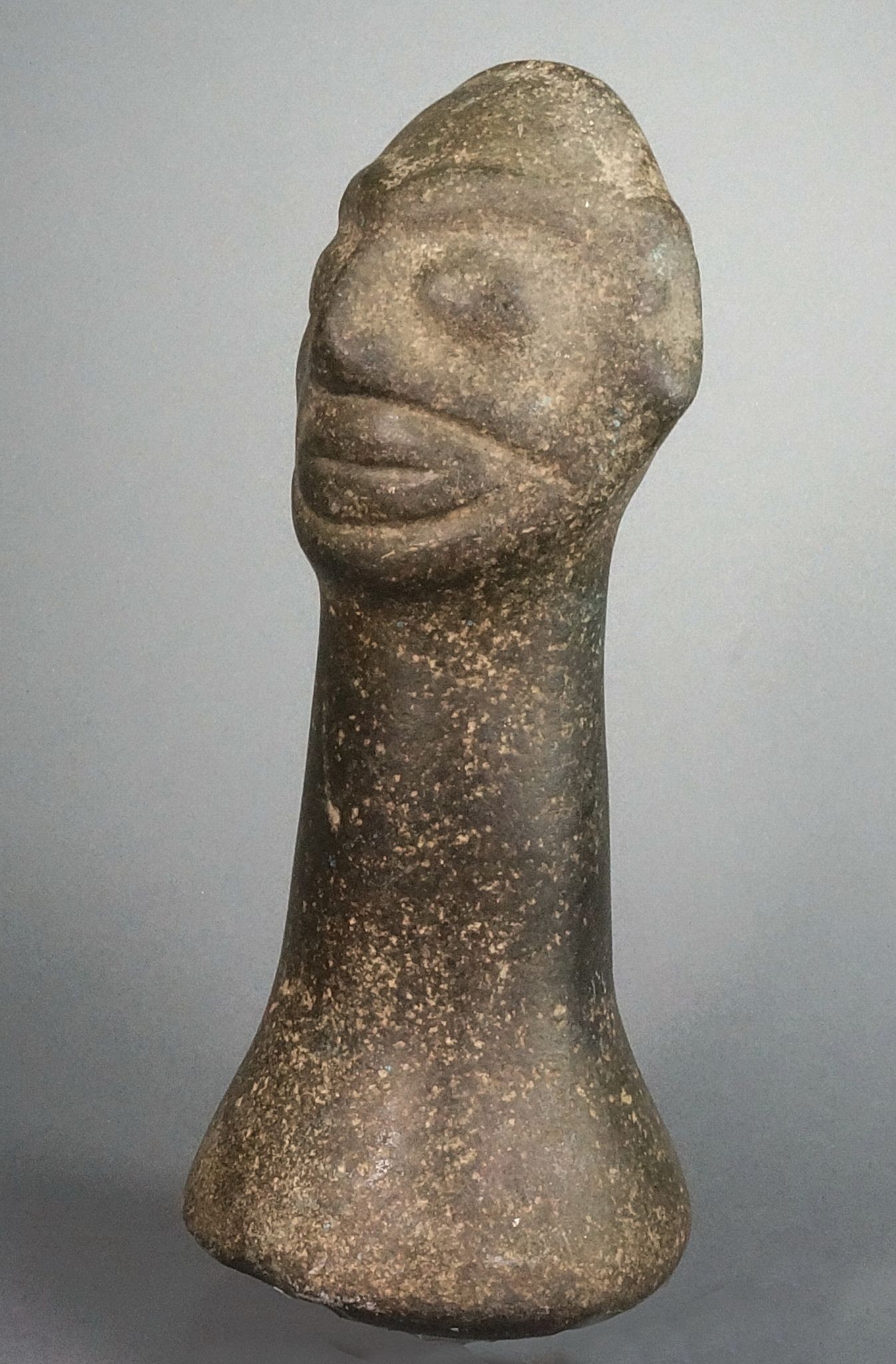
Dominican Republic, Taíno Stone Pestle with Carved Face
The face carved on this pestle appears to be in a trance, as if it is undergoing transformation from a shaman to a deity. This is a particularly rare large example with a high degree of artistry and a humanoid face.
Period: Dominican Republic, Taíno , c. AD 1000 - 1500
Media: Stone
Dimensions: Height 8"
88058c




Dominican Republic, Taíno Large Carved Stone Fragment of a Deity Head from a Pestle
This head would have once been the top of a very large pestle, and is most likely representative of a Taíno deity in human form.
Period: Dominican Republic, Taíno , Early Classic Period, c. AD 600 - 1000
Media: Stone
Dimensions: Height: 3 1/2" x Length: 3 3/4"
99188



Dominican Republic, Taíno Stone Carved Cylindrical Implement with Face
Its shape implies that it functioned as a tool, but the highly detailed creature’s’ face, coupled with the absence of wear and tear, suggests a more ceremonial purpose.
Period: Dominican Republic, Taíno , c. AD 1000 - 1500
Media: Stone
Dimensions: H: 8"
98124




Dominican Republic, Unusual Carved Brown Stone with a Face on Front and on Side
This is a unique object with unknown use. One possibility is that it was some a ritualistic amulet.
Period: Dominican Republic, Taíno , Early Classic Period, c. AD 600 - 1000
Media: Stone
Dimensions: Height" 2" x Length: 3"
89091
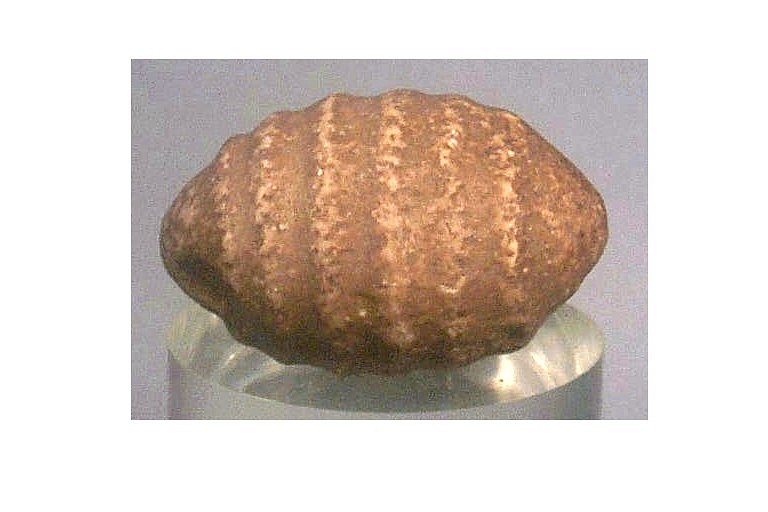
Dominican Republic, Taíno Neolithic Tan Egg-Shaped Grooved Stone Grinder
This oval stone grinder has five grooves that follow its circumference. Despite its primarily utilitarian function (it was probably employed for grinding foods and pigments), its rudimentary character is imbued with a charm brought on by its decorative ridge surface.
Period: Dominican Republic, Taíno , Neolithic, c. 1000 - 400 BC
Media: Stone
Dimensions: Length: 3"
MM056

Dominican Republic, Taíno Stone with Two Nipples
These stones have been found in Neolithic graves, and were used in a variety of ways: as weapons, grinders and abstract idols. Present day shamans use these ancient pieces to ward off bad sprits.
Period: Dominican Republic, Taíno , c. AD 1000 - 1500
Media: Stone
Dimensions: Length: 3 3/4" by Height: 2.5"
98204
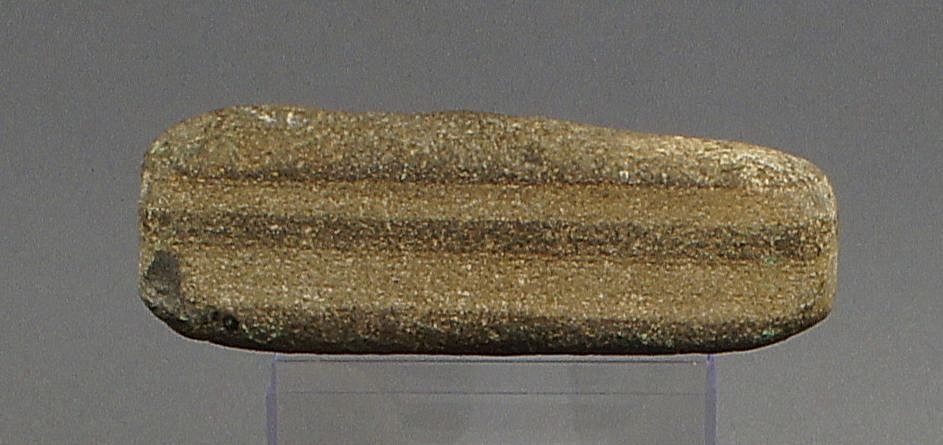
Dominican Republic, Taíno Rectangular Sharpening Stone with Two Channels on Each Side
Period: Dominican Republic, Casimiroid, c. 4000 BC - AD 4000
Media: Stone
Dimensions: Length: 5.5" x Width: 1.75" x Height: 1.5"
98236

Dominican Republic, Pre-Taíno Pyramidal Stone
This stone fits perfectly the palm of the hand and may have been used as a hammer. However, it does not show signs of wear, which also indicates that it may have been a ceremonial object.
Period: Dominican Republic, c. AD 1000 - 1500
Media: Stone
Dimensions: Height: 3 1/2"
96119A

Dominican Republic, Pre-Taíno Round Pounding Stone
This pounder is large enough to grasp and pound on the flat sides.
Period: Dominican Republic, Courian Subseries, c. 2000 BC - AD 250
Media: Stone
Dimensions: Length: 3 " x Width: 3.25" x Height: 1.5"
98162

Dominican Republic, Pre-Taíno Round Grey-Brown Pounding Stone
Completely round pounding stone, with flat top and bottom.
Period: Dominican Republic, Courian Subseries, c. 2000 BC - AD 250
Media: Stone
Dimensions: Diameter: 3.25" x Thickness: 1.75"
98165
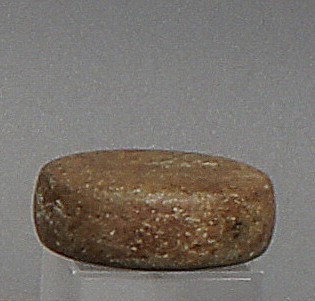
Dominican Republic, Pre-Taíno Circular Polishing Tool
This rounded stone is polished on all surfaces. One side has an incised "V"as if it were pointing to some place.
Period: Dominican Republic, Taíno , Neolithic, c. 1000 - 400 BC
Media: Stone
Dimensions: Diameter: 1 3/4" x Thickness: 1/2"
98198

Dominican Republic, Pre-Taíno Stone Conical Shaped Pounder
This conical shape is a rare form of pounder. The bottom face is smooth from use.
Period: Dominican Republic, Ostionoid, c. AD 200 - 900
Media: Stone
Dimensions: Height: 3" x Diameter: 2.5"
98183

Dominican Republic, 2 Taíno Spinning Tops
These are more than likely children's toys, similar to modern day tops. They are often found buried with children.
Period: Dominican Republic, Taíno , c. AD 1000 - 1500
Media: Stone
Dimensions: D: 2 1/4" & 1 1/4
98133
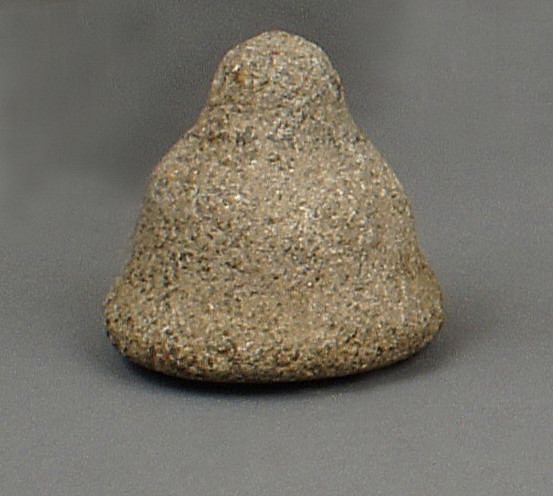
Dominican Republic, Pre-Taíno Stone Graduated Grinder
This particular form is one of the rarer types for pounders, and this pounder fits nicely into the hand. The bottom face is smooth from use.
Period: Dominican Republic, Ostionoid, c. AD 200 - 900
Media: Stone
Dimensions: Height: 2 1/4" x " x Diameter: 2.5"
98238
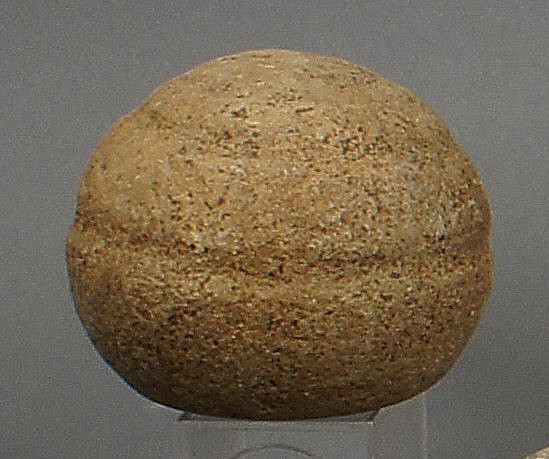
Dominican Republic, Pre-Taíno Medium Sized Spherical Shaped Pounder with Three Concentric Grooves
This tan colored stone pounder is just large enough to fit in the palm of the hand.
Period: Dominican Republic, Courian Subseries, c. 2000 BC - AD 250
Media: Stone
Dimensions: Diameter: 3.25" x Height: 2.5"
98163

Dominican Republic, Pre-Taíno Gray Stone Ball of Unknown Use
This stone ball shows no signs of wear and could have been for ceremonial use, or for use as a weapon.
Period: Dominican Republic, Saladoid Culture, Pre-Taíno , c. 400 BC - AD 600
Media: Stone
Dimensions: Diameter: 2"
98084
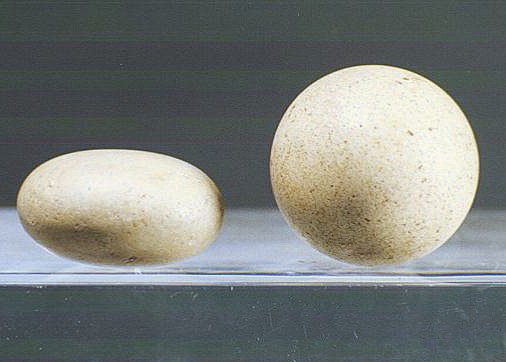
Dominican Republic, Pre-Taíno White Stone Ball and Disc
These white stone balls, or shperoliths, are more than likely some type of gaming pieces. They are commonly found in children's tombs as offerings and the size of the stone generally correlates to the age of the child.
Period: Dominican Republic, c. AD 1000 - 1300
Media: Stone
Dimensions: D: 1.5" & 1 1/4"
98119
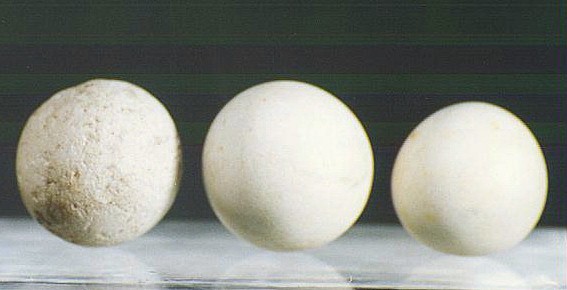
Dominican Republic, 3 Pre-Taíno White Stone Balls
Excavated examples of such perfectly round balls indicate that they were ceremonial, but their use remains enigmatic. Similar examples are illustrated in Dacal Moure and Rivero De La Calle, "Art and Archaeology of Pre-Columbian Cuba" (1996: pl. 1). It is possible that these stone balls were used as projectiles for slings.
Period: Dominican Republic, Courian Subseries, c. 2000 BC - AD 250
Media: Stone
Dimensions: Diameter:, 1", 7/8"", 3/4"
98120
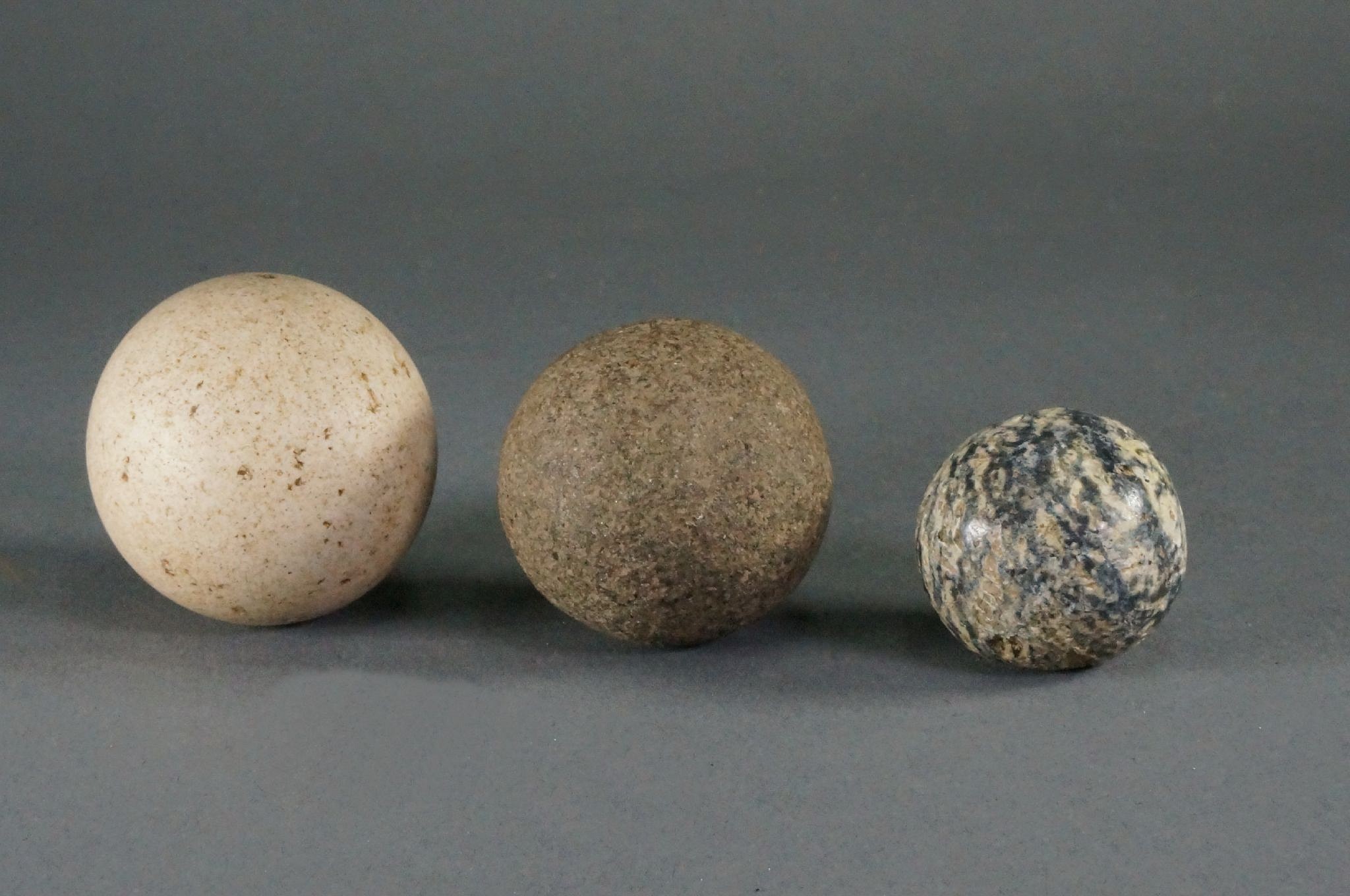
Dominican Republic, Three Small Taíno Stones Balls Different Stones
These stones are graduated in size, and of different colors: white, grey, brown, and marbleized. Special care was taken to make these stones perfectly round. These small stones have been found in tombs of small children, with the largest stones buried along with the older children. These stones may also have been used as projectiles for slings.
Period: Dominican Republic, Taíno , Early Classic Period, c. AD 600 - 1000
Media: Stone
Dimensions: Diameter: 9.5" & 1.3"
98500
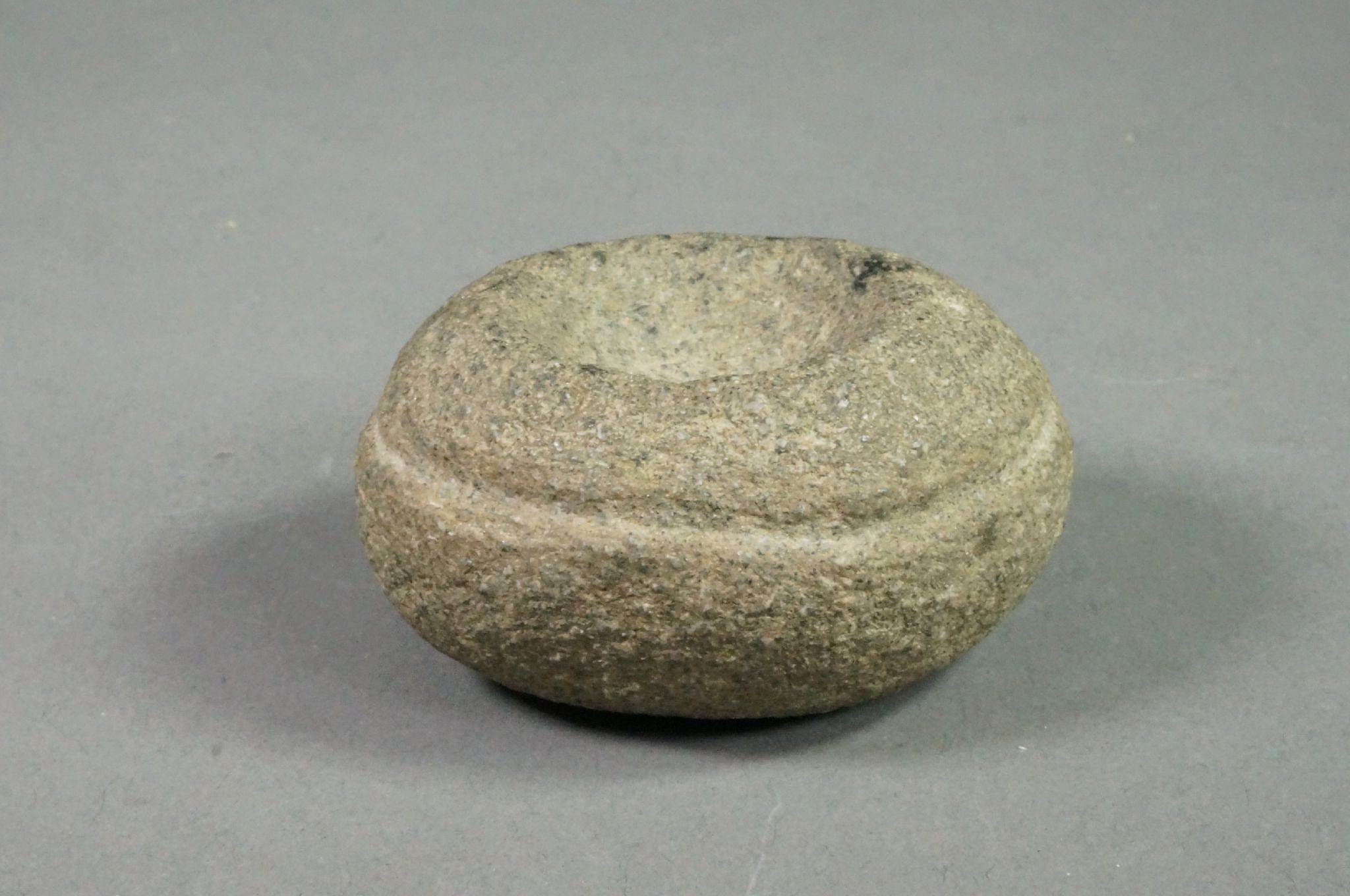


Dominican Republic, Pre-Taíno Miniature Circular Stone Mortar
This small mortar was probably used to crush small amounts of potent drugs. The incised circle around the outside may have been used to run a string to rotate the mortar with a push and pull.
Period: Dominican Republic, Courian Subseries, c. 2000 BC - AD 250
Media: Stone
Dimensions: Diameter: 1 7/8"
98164

Dominican Republic, Taíno Janus-head Pestle
Double-headed imagery is pervasive in Taíno art. This is a classic Taíno pestle, typically used for grinding hallucinogenic seeds. They may have also been used as personal idols in the home for worship.
Period: Dominican Republic, Taíno , c. AD 1000 - 1500
Media: Stone
Dimensions: Height: 6 1/4"
M4038

Dominican Republic, Neolithic "Nipple Cap" Style Axe-Head
These nipple-capped style axe heads are so called because their obscured petaloid forms are designed with a ridge at the hafting point. The grooves would have been for using string to secure the axe-head to a wooden axe handle. This type of axe is found predominantly in Hispaniola.
Period: Dominican Republic, Taíno , Neolithic, c. 1000 - 400 BC
Media: Stone
Dimensions: Height: 6"
94314

Dominican Republic, Taíno Stone Mortar and Bird Pestle
This mortar and pestle were found together and carved from the same stone, thus forming a complementary pair. The mortar is pleasantly spherical with a fairly deep concavity, while the top of the accompanying pestle was sculpted as a bird. A pestle and mortar set of this quality doubtless belonged to a wealthy chief or high-ranking lord.
Period: Dominican Republic, Taíno , c. AD 1000 - 1500
Media: Stone
Dimensions: Mortar Diameter: 7 1/2" x Pestle Height: 5 1/2"
98122

Dominican Republic, Pre-Taíno Sandstone Mortar and Matching Pestle
This is a classic example of a Casmirian pestle that was later reworked by the Saladoid. This pestle would have been used to grind hard objects like nuts and seeds.
Period: Dominican Republic, Saladoid Culture, Pre-Taíno , c. 400 BC - AD 600
Media: Stone
Dimensions: Pestle Height: 4" x Width: 2.5"
Mortar Height: 3 1/4" x Diameter 6"
98182



Dominican Republic, Pre-Taíno Carved Stone Mortar in the form of a Turtle
This is a classic Saladoid mortar. Very few mortars are published, and most are plain circles. This mortar is distinguished by the turtle shaped design around the edges. The shape of this stone indicates that it was used as a mortar for grinding food. The only other mortar in the shape of an abstract turtle is in the Berlin Volkerkunde Museum. It is from Dominican Republic and is illustrated in the 34th Annual Report of the Smithsonian, 1912 on plate 113.
Period: Dominican Republic, Courian Subseries, c. 2000 BC - AD 250
Media: Stone
Dimensions: Length: 11" x Width: 9"
M3076
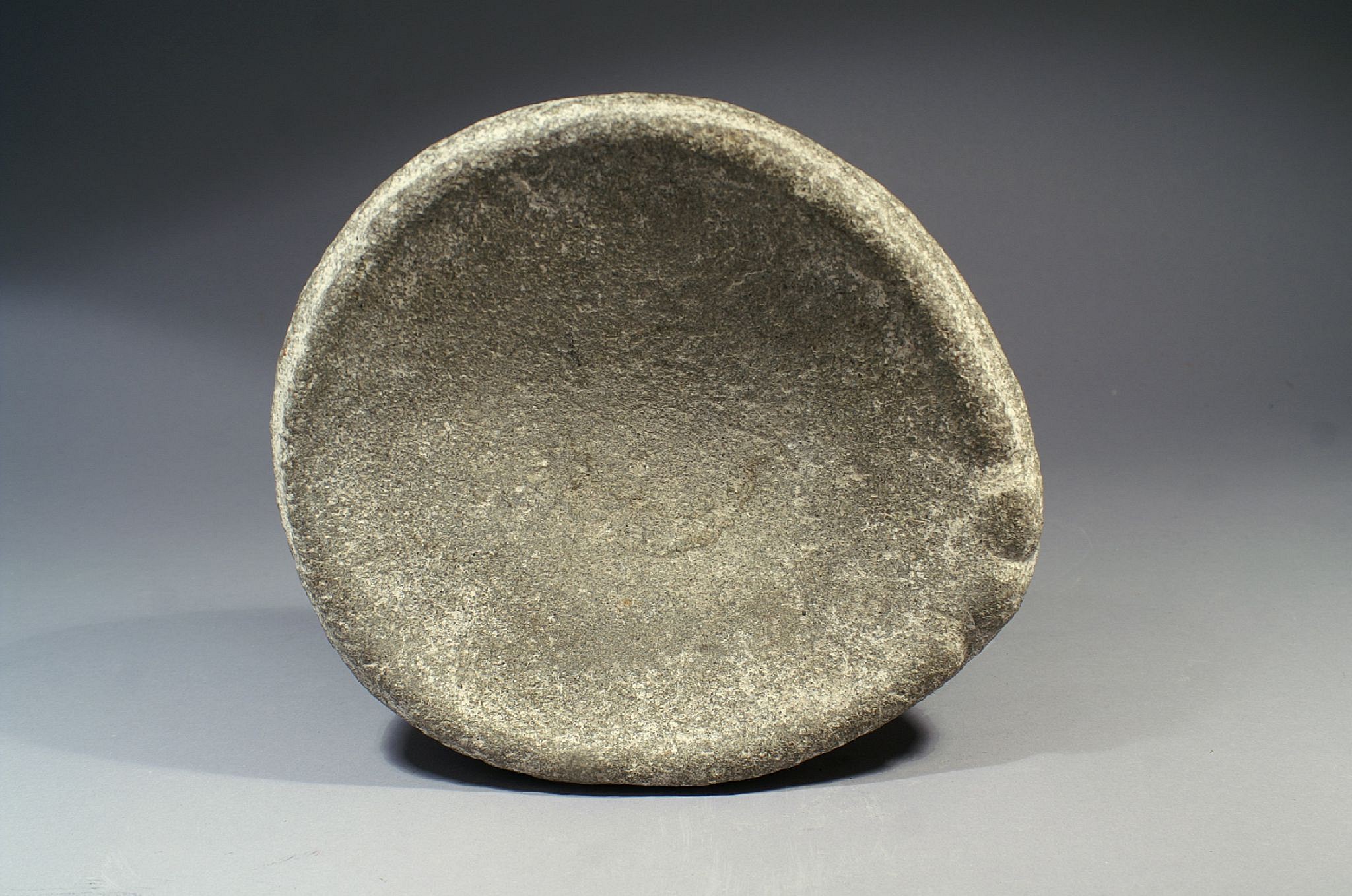



Dominican Republic, Taíno Stone Oval-shaped Mortar with Abstract Animal
This piece is unusual because of the embellishment of the rim design, perhaps representing a turtle, sacred to the ancient Taíno . It was likely used for ceremonial purposes; a more utilitarian object would have been plainer and exhibited more signs of wear.
Period: Dominican Republic, NeolithicTaíno , Casimiroid, Courian Subseries, c. 2660 BC - AD 240
Media: Stone
Dimensions: Diameter: 8.5" x Height: 3"
98121B




Dominican Republic, Taíno Large Graystone Ovoid-Shaped Mortar
Large mortars were probably used for the preparation of foodstuffs in community festivals, of which this one is certainly representative.
Period: Dominican Republic, Taíno , c. AD 1000 - 1500
Media: Stone
Dimensions: Length: 13 1/2" inches x Height: 4 3/4" inches.
M7109
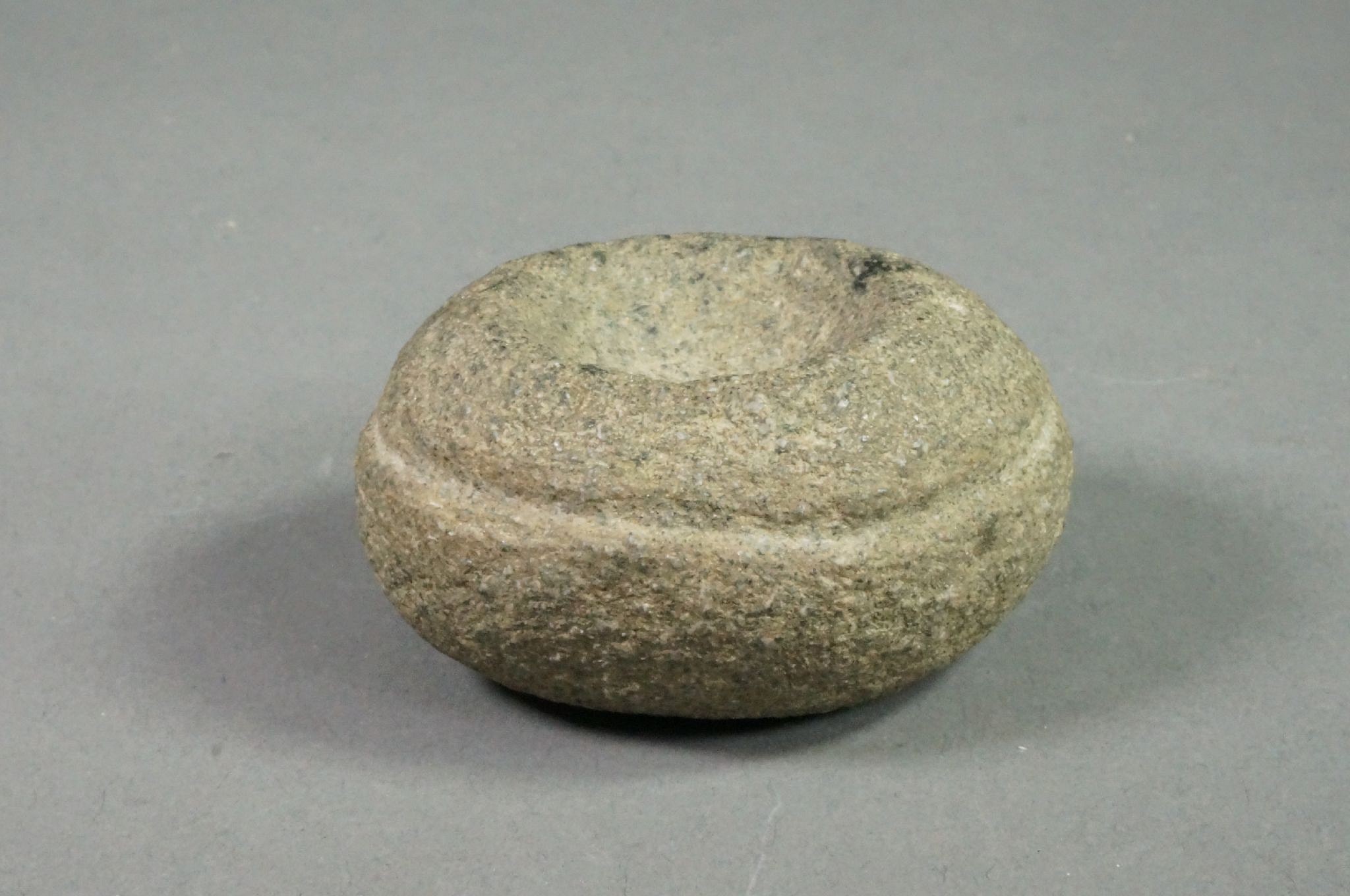


Dominican Republic, Taíno Miniature Grey Stone Mortar
It's possible this mortar was used to grind small seeds or other fine plant materials. Along the circumference is a groove.
Period: Dominican Republic, Casimiroid, c. 4000 BC - AD 400
Media: Stone
Dimensions: Diameter: 2"
n7010



Dominican Republic, Pre-Taíno Long Slender Tapered Pounder
This is Neolithic Saladoid stone pounder and roller. This roller implement is fashioned from a brownish gray stone into a tapered shape with the wide end highly polished.
Period: Dominican Republic, NeolithicTaíno , Casimiroid, Courian Subseries, c. 2660 BC - AD 240
Media: Stone
Dimensions: Length: 11 1/2" x 1 1/2" diameter at the widest end
MM044



Dominican Republic, Taíno Stone Slender Conical Pestle
Although a common form of pestle, this one is in good condition, considering its intended use for grinding foodstuffs and medicinal plants. The bottom surface is smooth and covered with a dark slip.
Period: Dominican Republic, Courian Subseries, c. 2000 BC - AD 250
Media: Stone
Dimensions: Height: 6 1/2"
98185
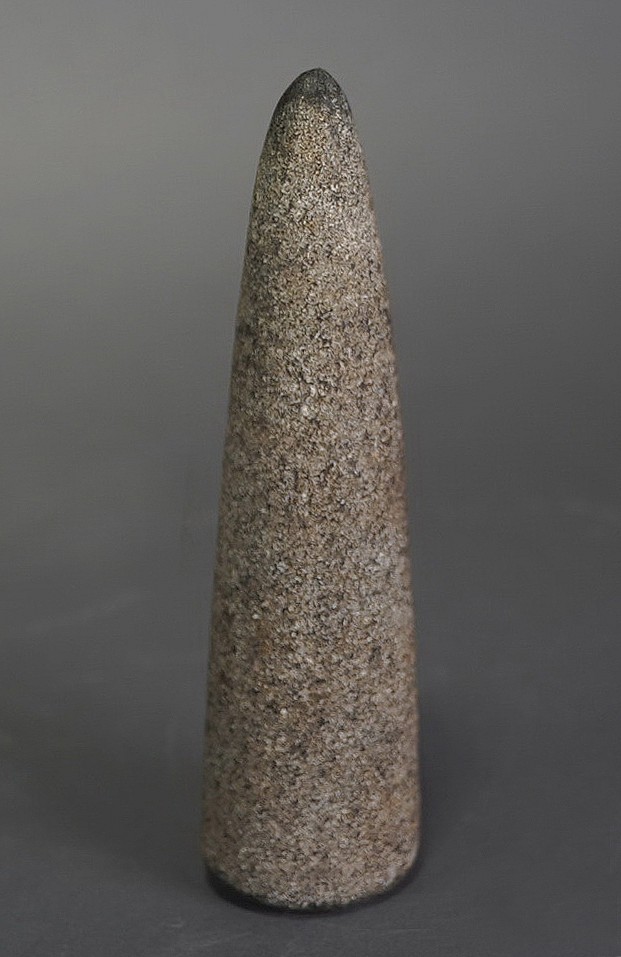
Dominican Republic, Taíno Conical Pestle of Speckled Stone
This is a classsic Taíno pestle design, and this pestle may have been used to prepare cassava, other plant foods, or psychoactive compounds. The bottom surface is smooth and covered with a dark slip.
Period: Dominican Republic, Courian Subseries, c. 2000 BC - AD 250
Media: Stone
Dimensions: Length: 5 1/4"
98131



Dominican Republic, Pre-Taíno Large Oblong Pounding Stone
This is a Saladoid stone tool. The flat ends were for used pounding plants and foodstuffs, and the curved sides for grinding.
Period: Dominican Republic, Courian Subseries, c. 2000 BC - AD 250
Media: Stone
Dimensions: Length: 4 1/2" x Height: 2"
n7006
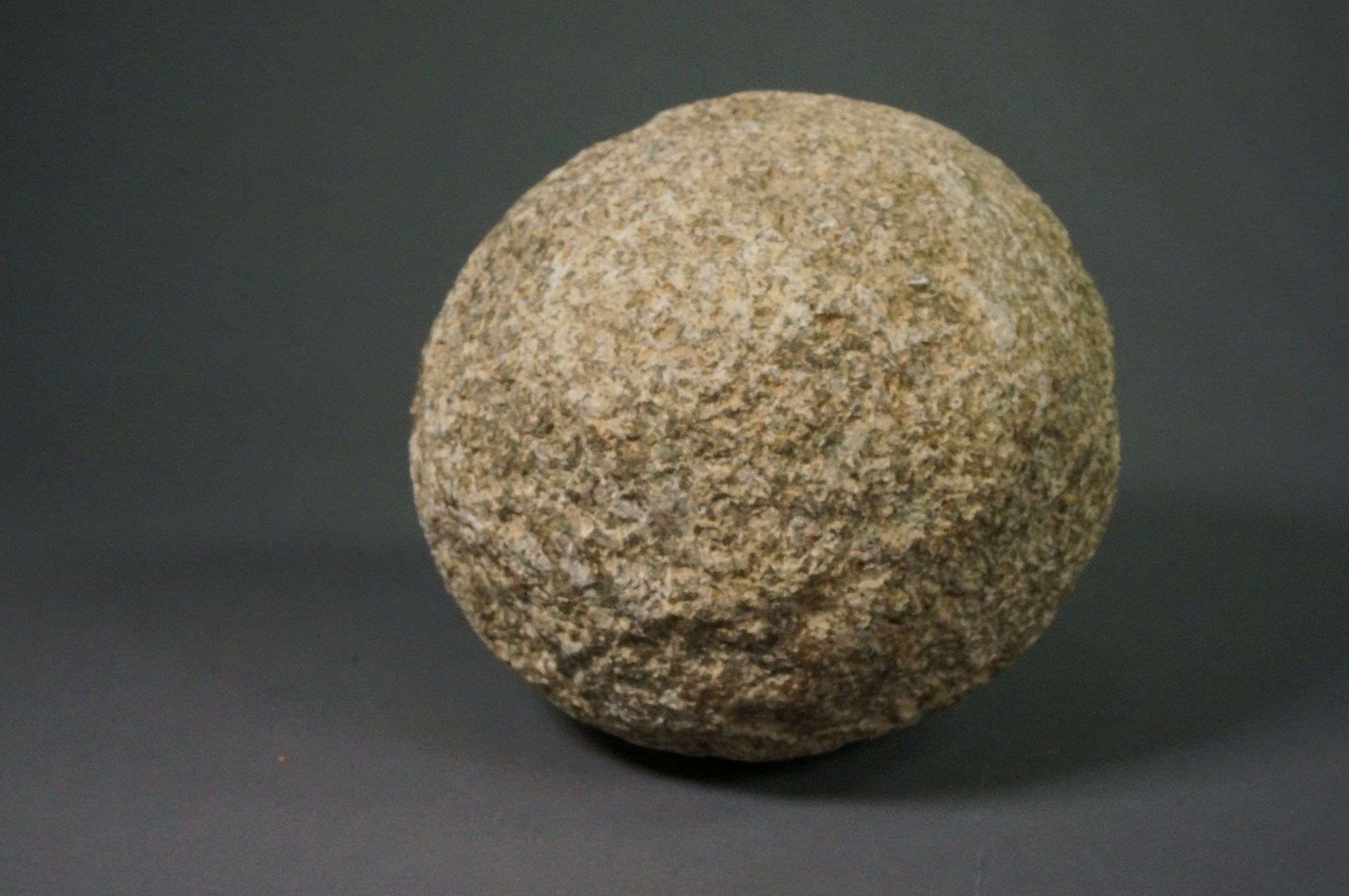
Dominican Republic, Pre--Taíno Large Spherical Pounder of Coral
This is a particularly large sphere for pounding and just fits into a hand. It is made of very hard coral.
Period: Dominican Republic, Courian Subseries, c. 2000 BC - AD 250
Media: Stone
Dimensions: Diameter: 4 1/4"
n7008
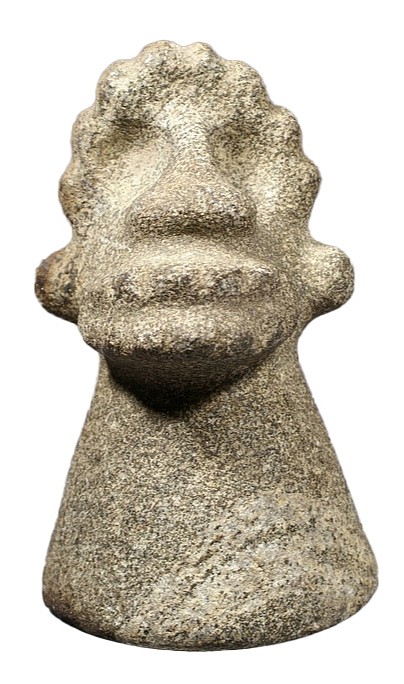


Dominican Republic, Taíno Gray Speckled Stone Pestle Depicting a Zoomorphic Being
This is a large and well-carved, good example of a pestle that is half-human, half-animal.
Period: Greater Antilles, Sub-Courian Period, c. 2000 - 100 BC
Media: Stone
Dimensions: Height: 5" x Diameter at base: 3 1/2"
M4001B


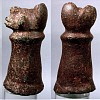
Dominican Republic, Large Taíno Painted Brown Stone Pestle With the Head of a Large Eared Animal Deity
A strange creature, perhaps part animal and part human carved from a natural brown stone. The defined mouth and nose suggest a humanoid, while the back appendages suggest bent hind legs. The lens shows significant wear, indicating that it was frequently used.
Period: Dominican Republic, Taíno , Early Classic Period, c. AD 600 - 1000
Media: Stone
Dimensions: Height: 5 1/2" x Diameter of the base: 2 1/2"
98207




Dominican Republic, Taíno Striated Stone Pestle a Depicting a Stylized Figure
This stone was surely selected for the beauty of its natural grey and white striations.
Period: Dominican Republic, Taíno , Early Classic Period, c. AD 600 - 1000
Media: Stone
Dimensions: Height: 4" x Width at base: 2 1/2"
98202
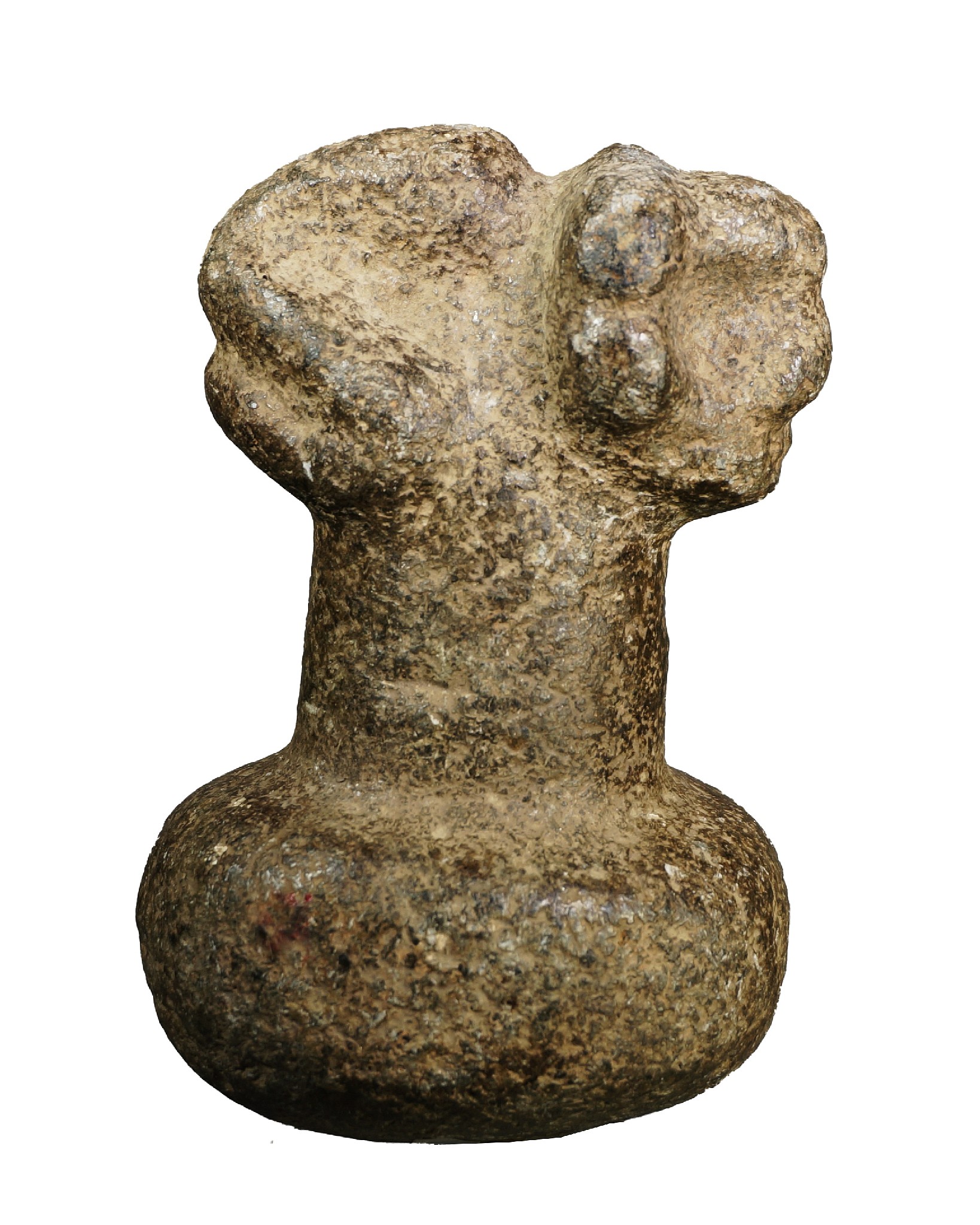




Dominican Republic, Taíno Carved Stone Gray Stone Pestle with Anthropomorphic Crouching Figure
The body of this figure, which is hunched on all fours, assumes a frog-like appearance as it perches horizontally across the base. A deeply incised cleft runs the length of the back and buttocks creating the illusion of a backbone, a Classic Taíno sculptural convention.
Period: Dominican Republic, Taíno , c. AD 1000 - 1500
Media: Stone
Dimensions: Height: 4 4/3""
MM054
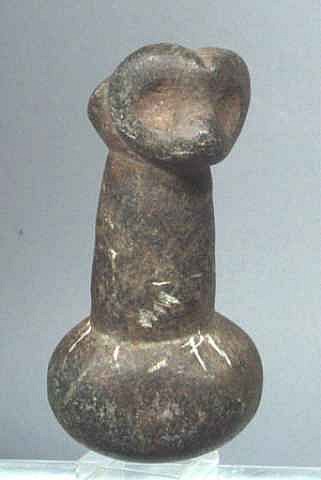


Dominican Republic, Taíno Carved Dark Stone Pestle with Owl Deity
Seen straight on is the face of an owl with large eyes and heart-shaped face. Seen from above is an abstract face that represents an animal with large eyes and a pudgy nose, possibly a dog. The round lens lends itself to crushing seeds.
Period: Dominican Republic, Taíno , c. AD 1000 - 1500
Media: Stone
Dimensions: Height: 6"
98429A

Dominican Republic, Taíno Carved Grey Stone Pestle with Crouching Figure
The front of the pestle displays a owl's head with ears. The ears are also the crouching legs as seen from the back. The lens of the pestle is tapered from wear.
Period: Dominican Republic, Taíno , c. AD 1000 - 1500
Media: Stone
Dimensions: Height: 4"
M4062
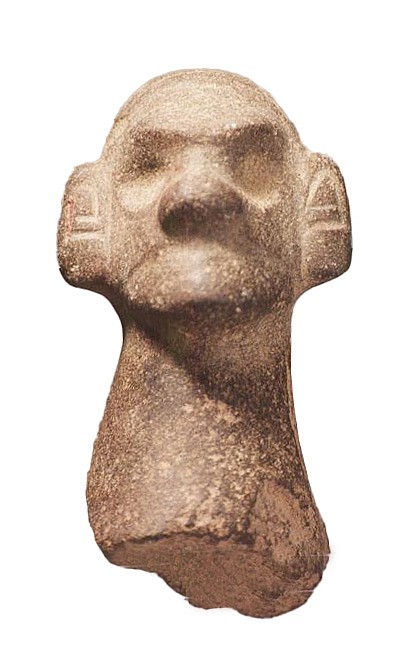
Dominican Republic, Taíno Carved Stone Pestle Handle Section with a Monkey Deity Head
This finely finished pestle handle has incised circles on the top and the back of the deity's head, which creates an abstract face.
Period: Dominican Republic, Taíno , c. AD 1000 - 1500
Media: Stone
Dimensions: Length: 4" x Diameter: 2"
98199
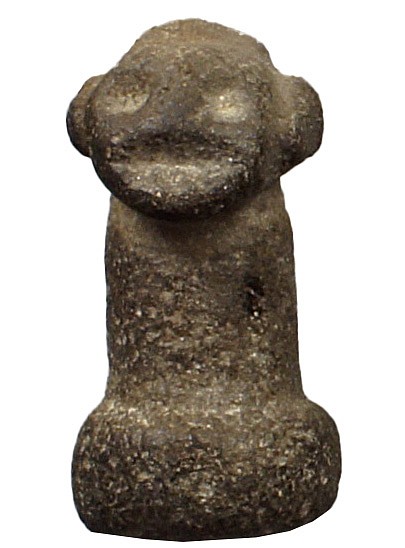
Dominican Republic, Taíno Small Pestle with Crouching Deity Turned into a Double Face
This classic Taíno estle can be read as either a face or a crouching figure both from the front and the back.
Period: Dominican Republic, Taíno , c. AD 1000 - 1500
Media: Stone
Dimensions: Height 3 1/2"
98146
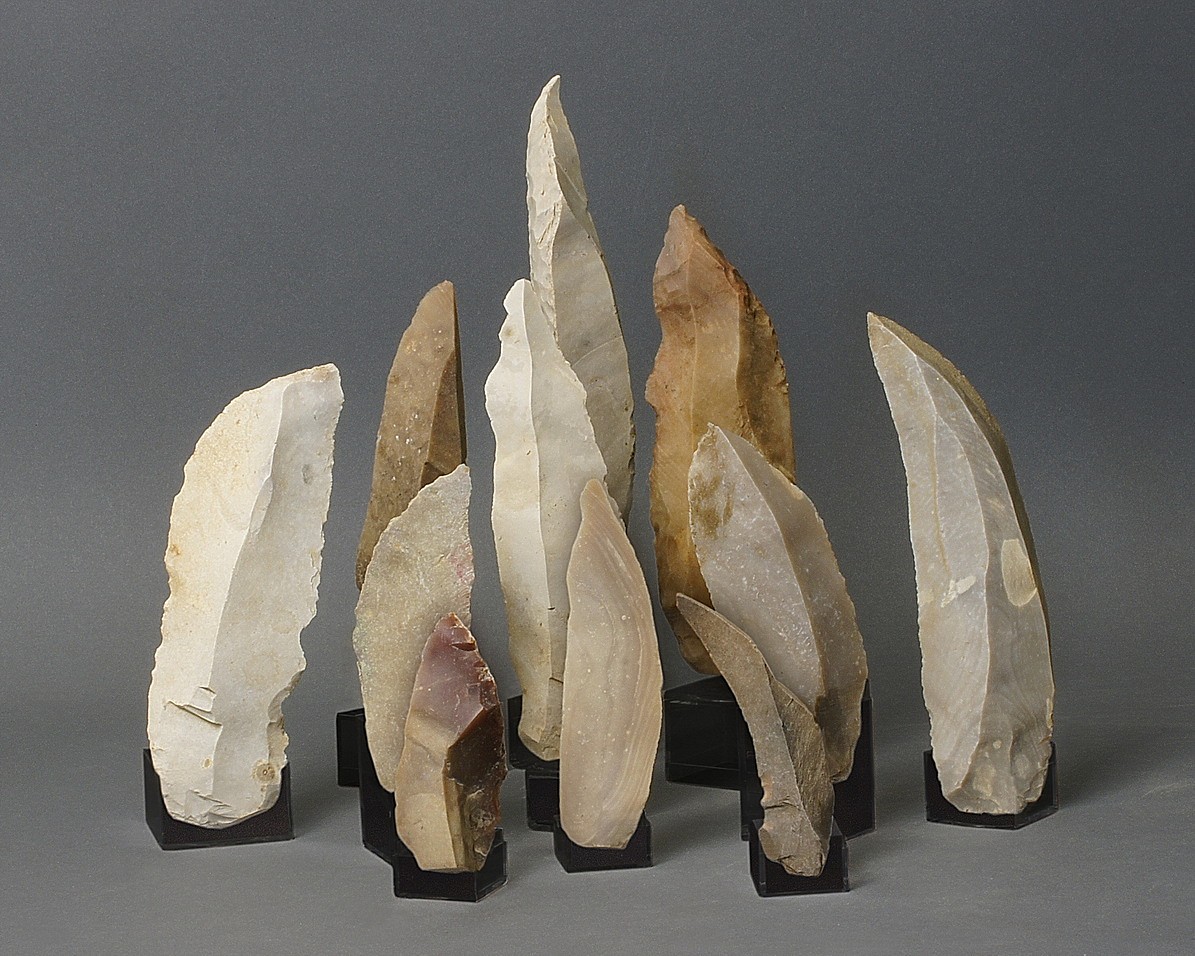
Dominican Republic, Neolithic Taíno Group of Eleven Xillex White Blades for Assorted Uses
This type of sharp flaked flint stone tool is categorized as Casmirian, and precedes the more complex Courian blades of stone, bone, and shell. These bifacial napped tools were fashioned into hide scrapers, circular knives, spoons, knife blades, or spear heads, and were probably used to kill and butcher animals.
Period: Greater Antilles, Sub-Courian perio, c. 2000 - 100 BC
Media: Stone
Dimensions: Longest: 10 1/2"; shortest: 5"
MM017X
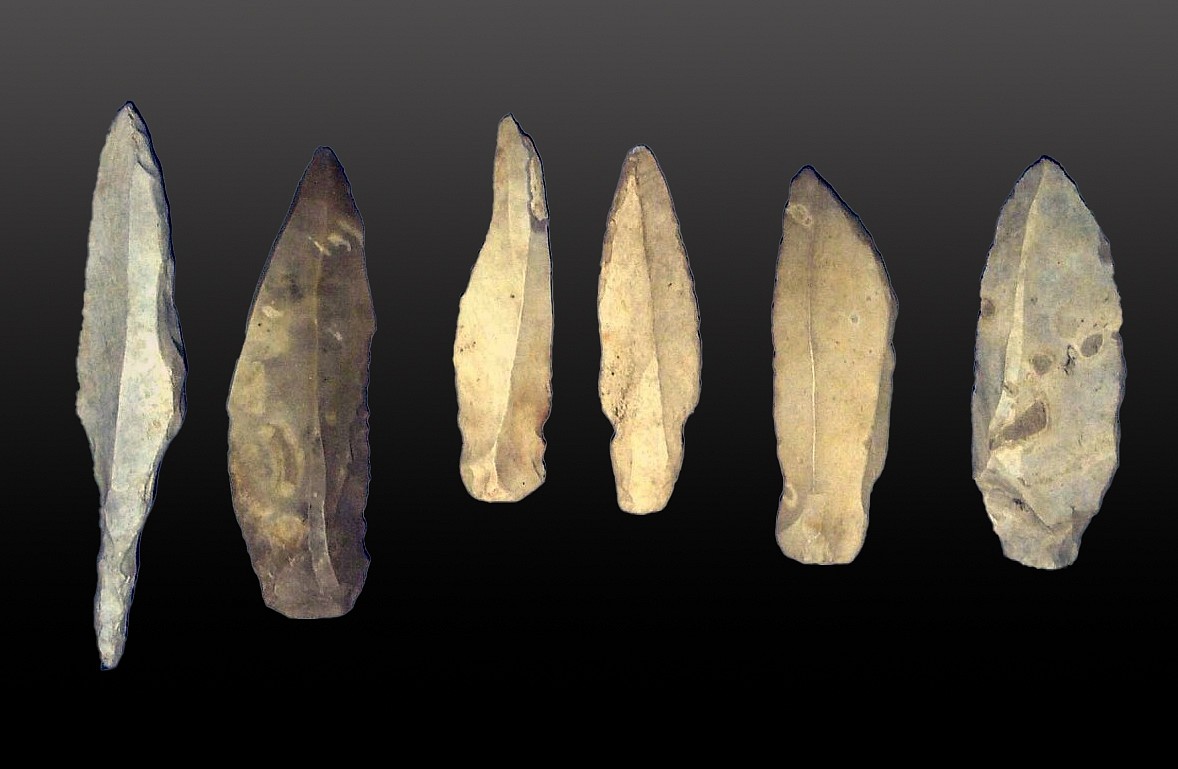
Dominican Republic, Group of 6 Neolithic Taíno Xillex Blades
This type of sharp flaked stone tool is categorized as Casmirian, and precedes the more complex Courian blades of stone, bone, and shell. These bifacial napped tools were fashioned into hide scrapers, circular knives, spoons, knife blades, or spear heads, and were probably used to kill and butcher animals.
Period: Dominican Republic, Taíno , Neolithic, c. 1000 - 400 BC
Media: Stone
Dimensions: Length: Longest: 10 1/2"; Shortest: 5"
MM017G

Dominican Republic, Pre-Taíno Neolithic Nipple Axe
This celt is was clearly incised as to depict swimming fish. The motif of the triangular design in the neck area reoccurs thousands of years later in Taíno art.
Period: Dominican Republic, Courian Subseries, c. 2000 BC - AD 250
Media: Stone
Dimensions: Height: 7 1/4" x Width: 4"
99004A
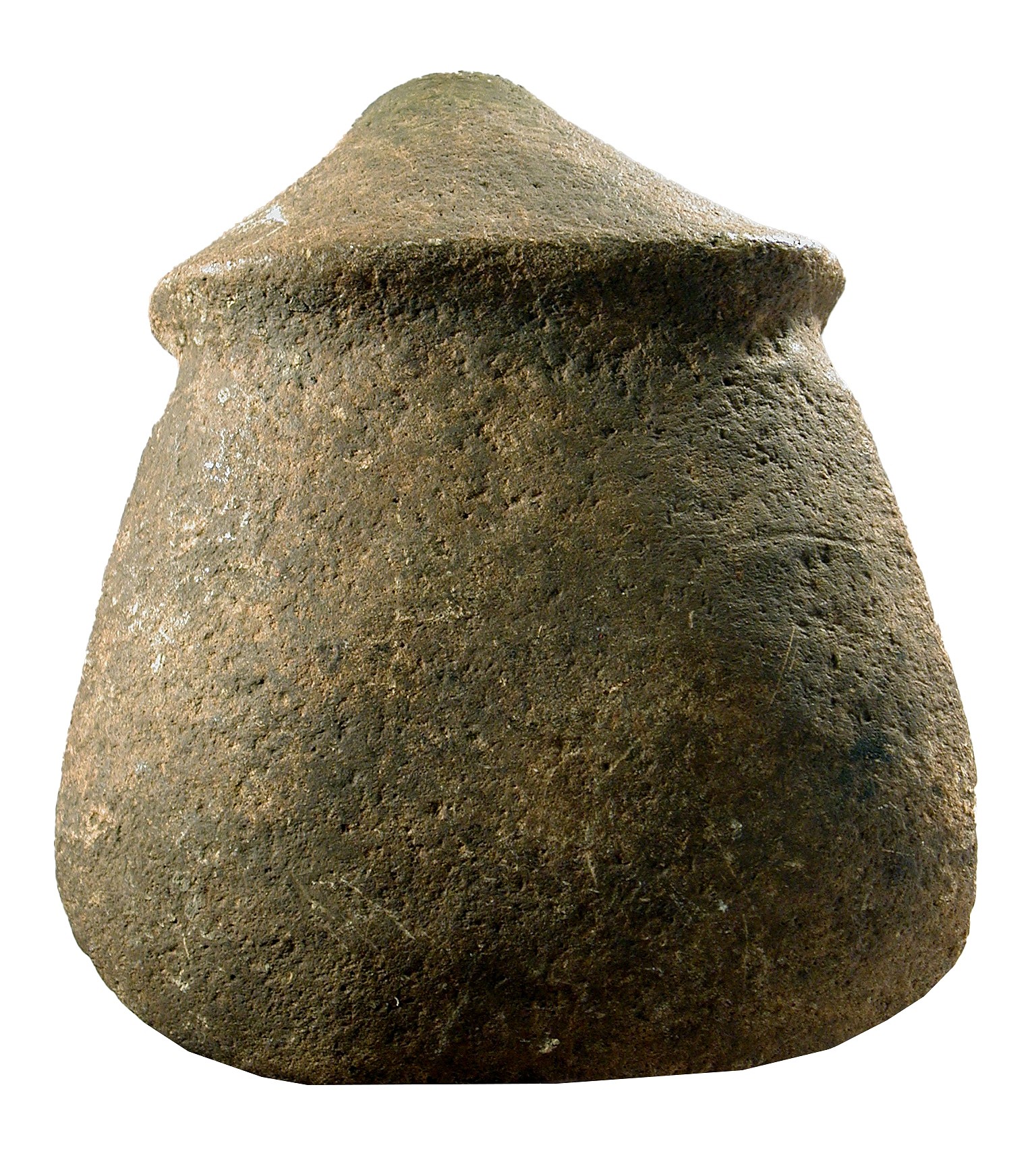
Dominican Republic, Sub-Courian Sandstone Nipple Axe Head
Axes of this type were fashioned from basalt and igneous rocks, and they are among the earliest dated tools found in the Caribbean. They were secured to wooden handles for use by pre-ceramic people who migrated into the region from South America, beginning about 6000 BC.
Period: Dominican Republic, Courian Subseries, c. 2000 BC - AD 250
Media: Stone
Dimensions: Height: 6" inches
98211B
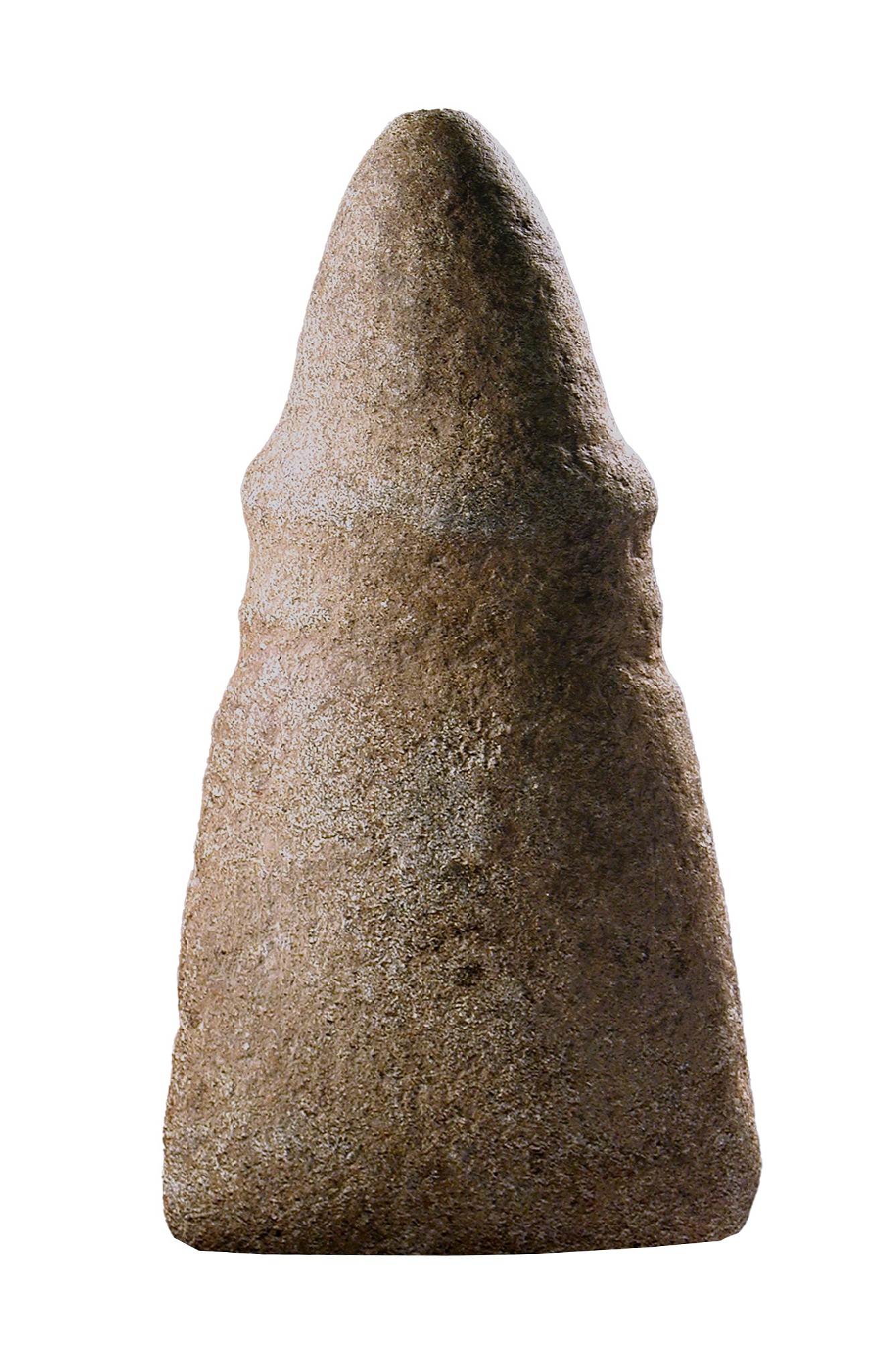
Dominican Republic, Taíno Triangular Double Ring Haft Axe Head
This seems to be one of the more common shapes for Taíno axes. The lack of any real wear on its surface indicates ceremonial use.
Period: Dominican Republic, Courian Subseries, c. 2000 BC - AD 250
Media: Stone
Dimensions: Height: 7 3/4"
98132
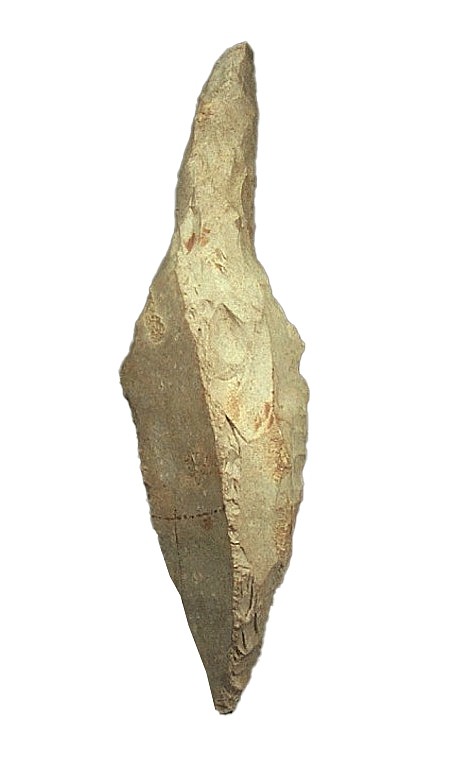
Dominican Republic, Neolithic Taíno Flaked Stone Dagger with Very Sharp Point
This type of flaked stone tool has been assigned to the Courian subseries and belongs to the same tradition of flaked-stone working in which the artisans collected fine grained rocks and struck them with hammerstones to chip off a succession of irregularly shaped flakes. These tools were probably used to kill and butcher animals.
Period: Dominican Republic, Courian Subseries, c. 2000 BC - AD 250
Media: Stone
Dimensions: Length: 9"
MM028

Dominican Republic, Neolithic Taíno Flaked Stone Knife with Worn Point
This Courian flaked stone dagger-type implement has a back that is smoothly flattened. It is characterized by a tradition of flaked-stone working in which the artisans collected fine grained rocks and struck them with hammerstones to chip off a succession of irregularly shaped flakes.
Period: Dominican Republic, Courian Subseries, c. 2000 BC - AD 250
Media: Stone
Dimensions: Length: 7 1/2"
MM029

Dominican Republic, Taíno Round Stone Axe Head with Groove in Center
This small round stone axe headwould likely have been affixed to an axe handle and used as a hammer or a weapon.
Period: Dominican Republic, Courian Subseries, c. 2000 BC - AD 250
Media: Stone
Dimensions: Height: 2 1/2"
99530
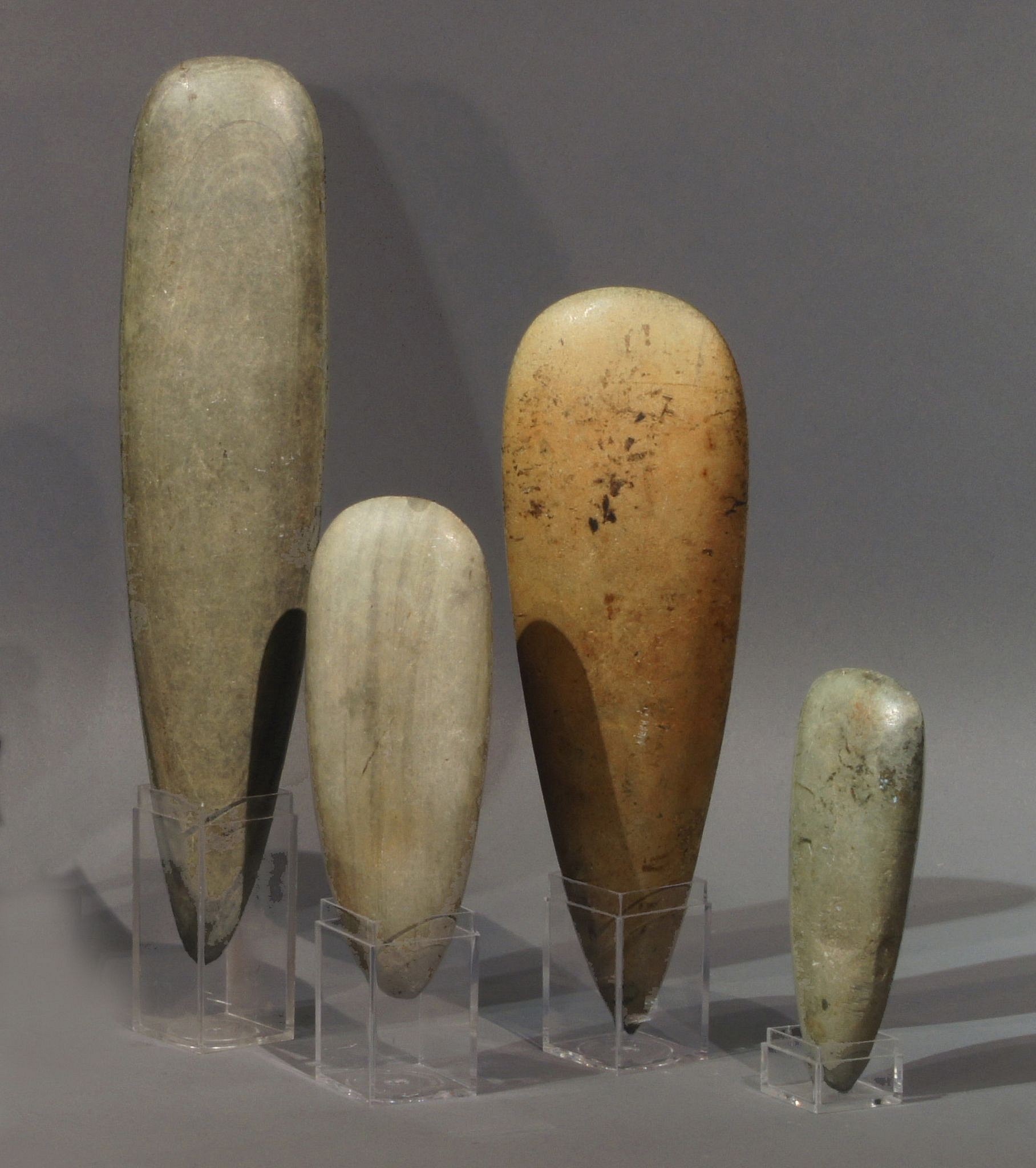
Dominican Republic, Group of Four Subcourian Ceremonial Petaloid Celts
These celts were selected for their lovely color and natural striations. They show no signs of wear, which indicates that they were used ceremonially and were likely cherished by their owners and passed down through multiple generations. Rene Herrera Fritot discussed and illustrated the configuration of celts in his 1964 book ESTUDIOS DE LAS HACHAS ANTILLANAS.
Period: Dominican Republic, NeolithicTaíno , Casimiroid, Courian Subseries, c. 2660 BC - AD 240
Media: Stone
Dimensions: Tallest: 9 1/4" - Shortest: 3"
MM324

Dominican Republic, Large Slender Grey-Green Stone Petaloid Celt
This large celt is in almost perfect condition with graceful proportions. Generally the larger celts have many flaws, while this one has none to the naked eye.
Period: Dominican Republic, Taíno , Early Classic Period, c. AD 600 - 1000
Media: Stone
Dimensions: Length 11 1/4"
mm0527

Dominican Republic, Large Petaloid Grey and Green Marbleized Celt
This large celt is made of finely polished, dark green and gray marbleized stone. The naturally beautiful coloration and calculated smoothness of this stone indicate that this celt was used for ceremonial purposes.
Period: Dominican Republic, Taíno , c. AD 1000 - 1500
Media: Stone
Dimensions: Length: 9" x Width: 3 1/4"
MM052A
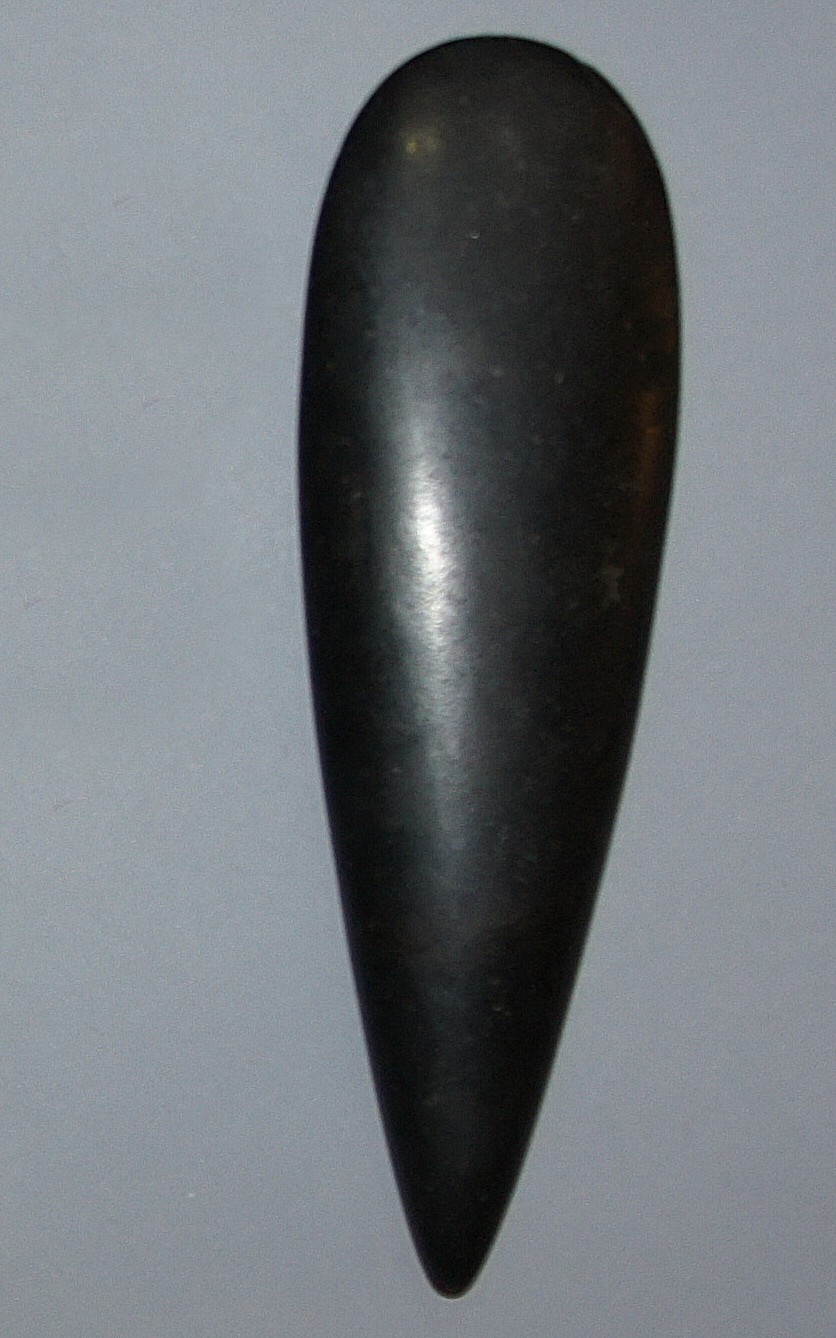


Dominican Republic, Taíno Large Black Petaloid Celt
The smoothly polished surface and finely tapered teardrop form of this petaloid stone celt indicates that it was intended as a ceremonial object. The term "petaloid" refers to the elongated, flower petal-like shape. Black stone celts are among the scarcest of stone celts because the stone was particularly hard and required greater skill to carve.
Period: Dominican Republic, Taíno , c. AD 1000 - 1500
Media: Stone
Dimensions: Length: 10" x Width: 3"
MM016
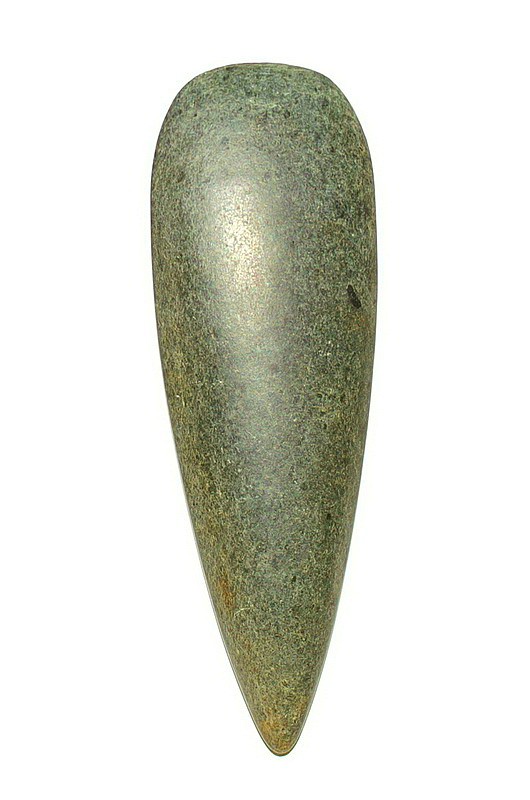
Dominican Republic, Taíno Large Petaloid Stone Celt with Gray, Blue, and Greenish Tones
Smoothly carved, stone, petaloid celt in grayish blue-green is impressively large and finely honed. Examples of petaloid stone celts are illustrated in "Twenty-fifth Annual Report of the BUREAU OF AMERICAN ETHNOLOGY" Washington, 1907, pl XII.
Period: Dominican Republic, Taíno , c. AD 1000 - 1500
Media: Stone
Dimensions: Length: 10 1/2", Width: 3 1/2"
MM048
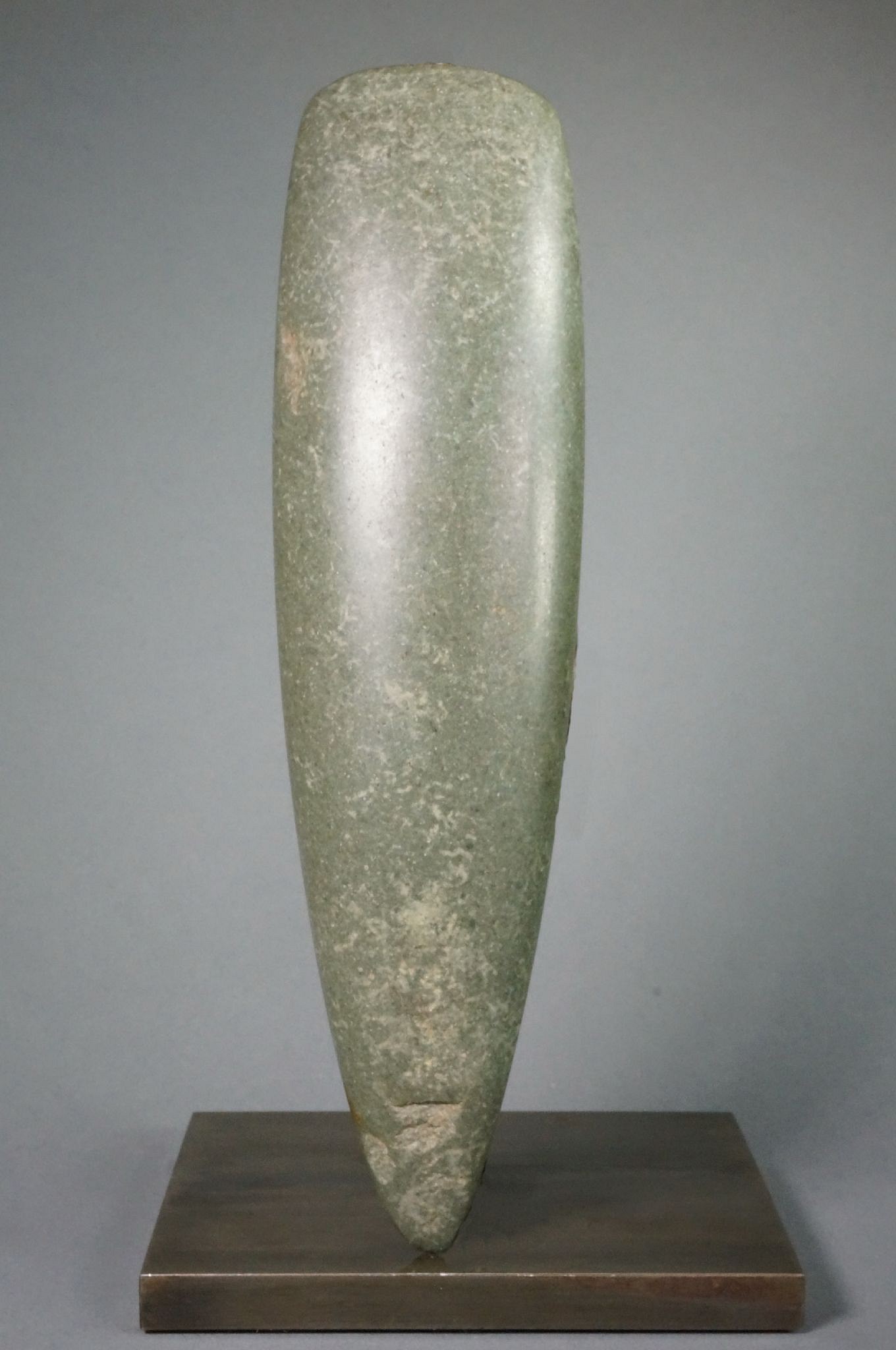


Dominican Republic, Taíno Greenstone Petaloid Celt
Petaloid celts of green and dark diorite stone were symbols of rank and never show signs of use as tools. They may have also been traded as currency or passed down to family. This celt has a notch at the tip that indicated use. Nice root marks.
Period: Dominican Republic, Archaic Period, c. 4000 - 300 BC
Media: Stone
Dimensions: Length: 8"
99270A
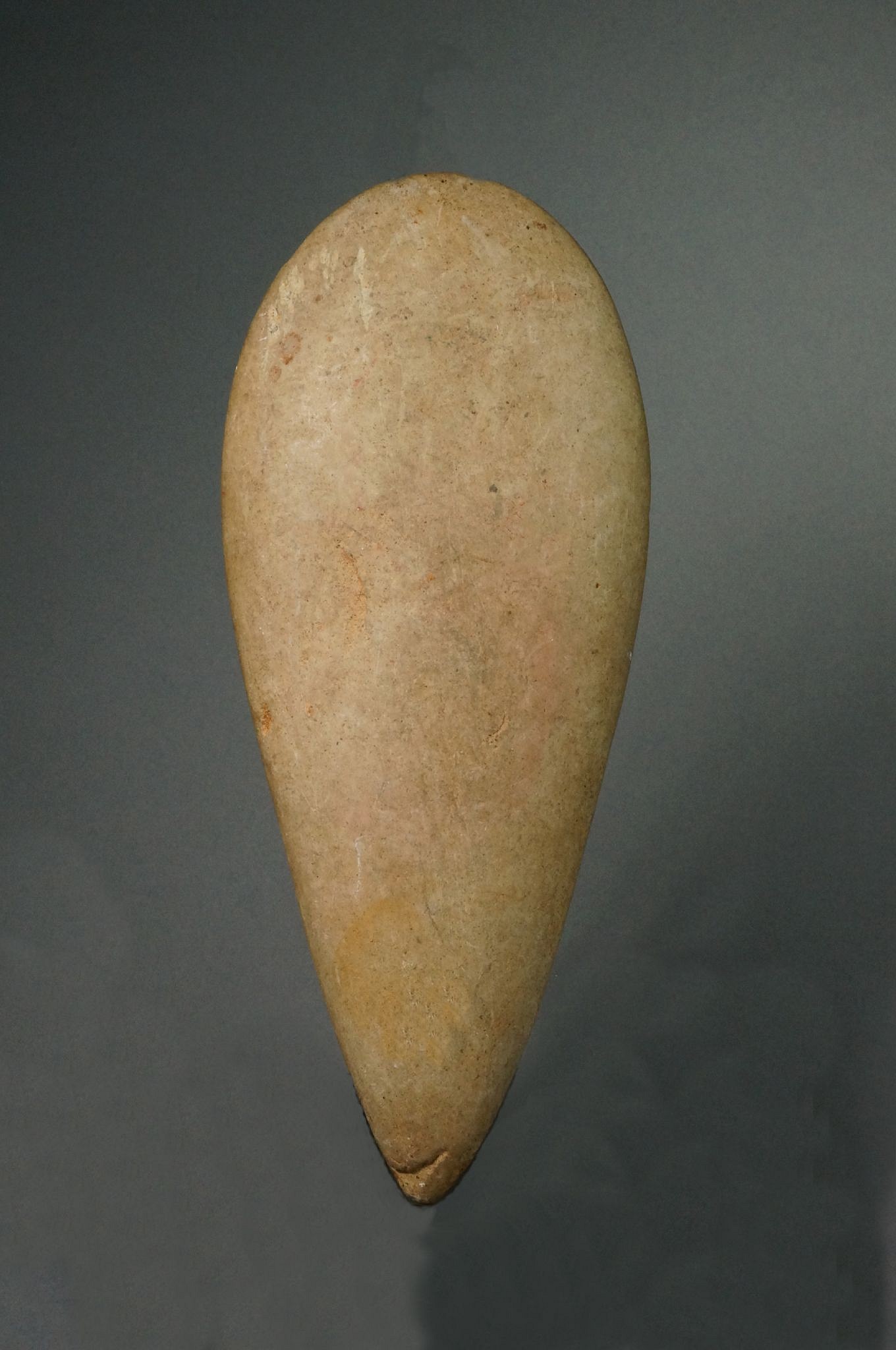
Dominican Republic, Taíno Beige Petaloid Stone Celt with Good Proportions
Petaloid celts carved from mottled tan stones rarely show signs of any use. These celts were probably symbols of prestige and were perhaps used as currency.
Period: Dominican Republic, Taíno , c. AD 1000 - 1500
Media: Stone
Dimensions: Length: 7" inches
MM045C
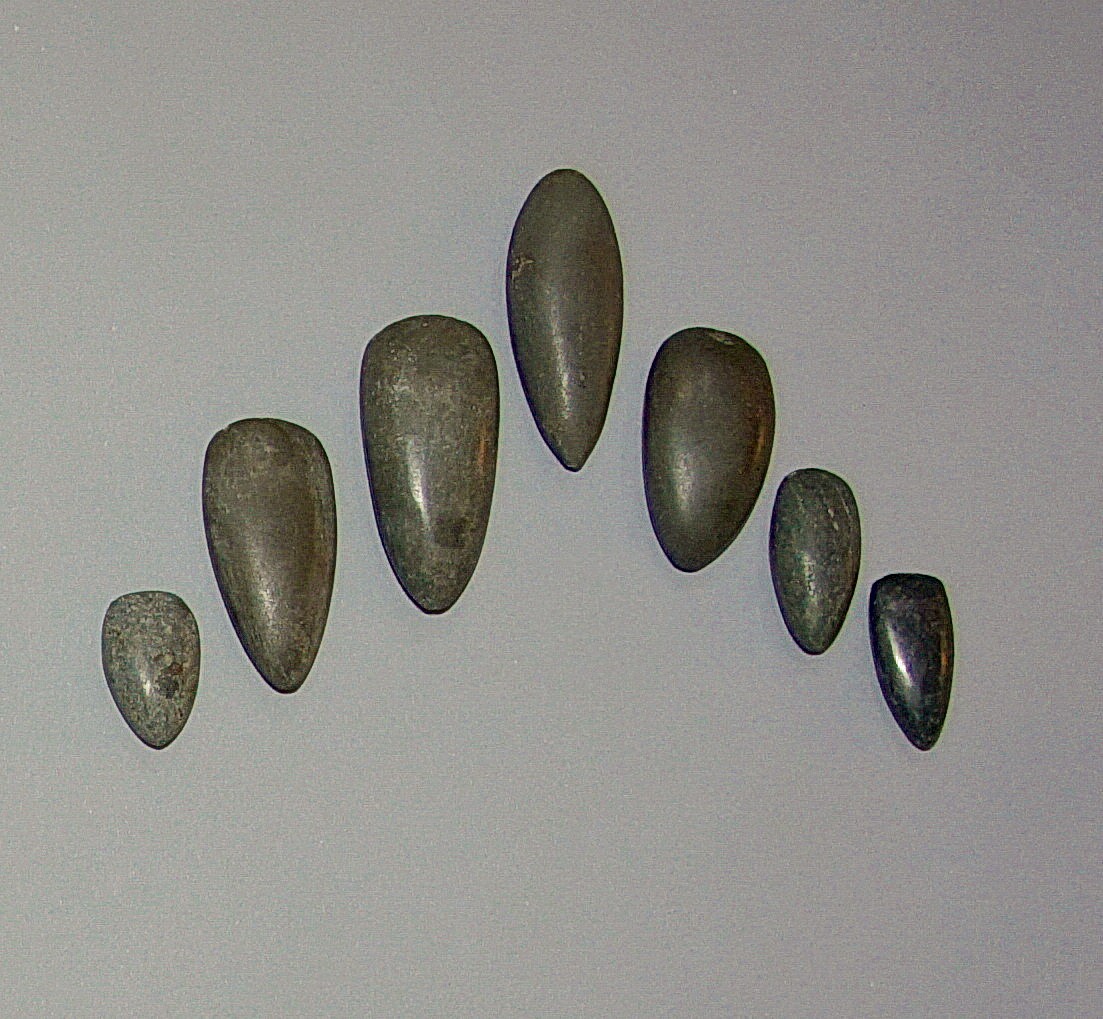
Dominican Republic, Seven Small Dark Greenstone Celts as Tools
Ranging in shape from oblong to petaloid, these stones were used as tools for fine work. The varied shapes allowed for fine work a variety of sizes of amulets.
Period: Dominican Republic, Taíno , Early Classic Period, c. AD 600 - 1000
Media: Stone
Dimensions: Length: 1 1/4" to 2 7/8"
$1,500
99454

Dominican Republic, Five Taíno Celt Tips Reconfigured into Tools
These five broken celts were reconfigured into small tools. They do not show signs of wear and were possibly used as hammers or for carving shells or other soft materials. These are very useful as study pieces, as they have the original polish, and “outer skin†thickness intact, and show rich root marks. It is possible that these may have been broken intentionally for ceremonial needs.
Period: Dominican Republic, Taíno , c. AD 1000 - 1500
Media: Stone
Dimensions: Length: Varies from 1" to 2 1/8"
99386




Dominican Republic, Three Pre-Taíno Stone Adzs of Different Colors
Each adz would have been lashed perpendicularly to a wooden shaft so that it would strike its target to make a wide cut. Adzs are rare in comparison to petaloid celts. The tips were lashed to the shaft, and the adzs shows signs of use.
Period: Dominican Republic, Casimiroid, c. 4000 BC - AD 400
Media: Stone
Dimensions: Top: Length 9"
Center: Length 7 1/4"
Bottom: Length 6 3/4"
n7009

Dominican Republic, Taíno Petaloid Green Stone Adz
The edge and tip of this adz are well preserved. The green stone has color variation due to intentional heating of the stone by the artisan who created it. The upper edge exhibits indications of repeated sharpening, resulting in a downward slant.
Period: Dominican Republic, Taíno , Early Classic Period, c. AD 600 - 1000
Media: Stone
Dimensions: Length: 8" x Width: 2 1/2"
98265

Dominican Republic, Pre-Taíno Large Polished Grey-Green Stone Adz
This stone appears to be a petaloid celt, but the underside is flat and has a pecked area. This flattened area was for attaching the stone to the top of a staff for swinging in an arc to chop along the horizontal edge.
Period: Dominican Republic, Taíno , Early Classic Period, c. AD 600 - 1000
Media: Stone
Dimensions: Length: 9 1/4" x Width at widest point: 3"
mm038A
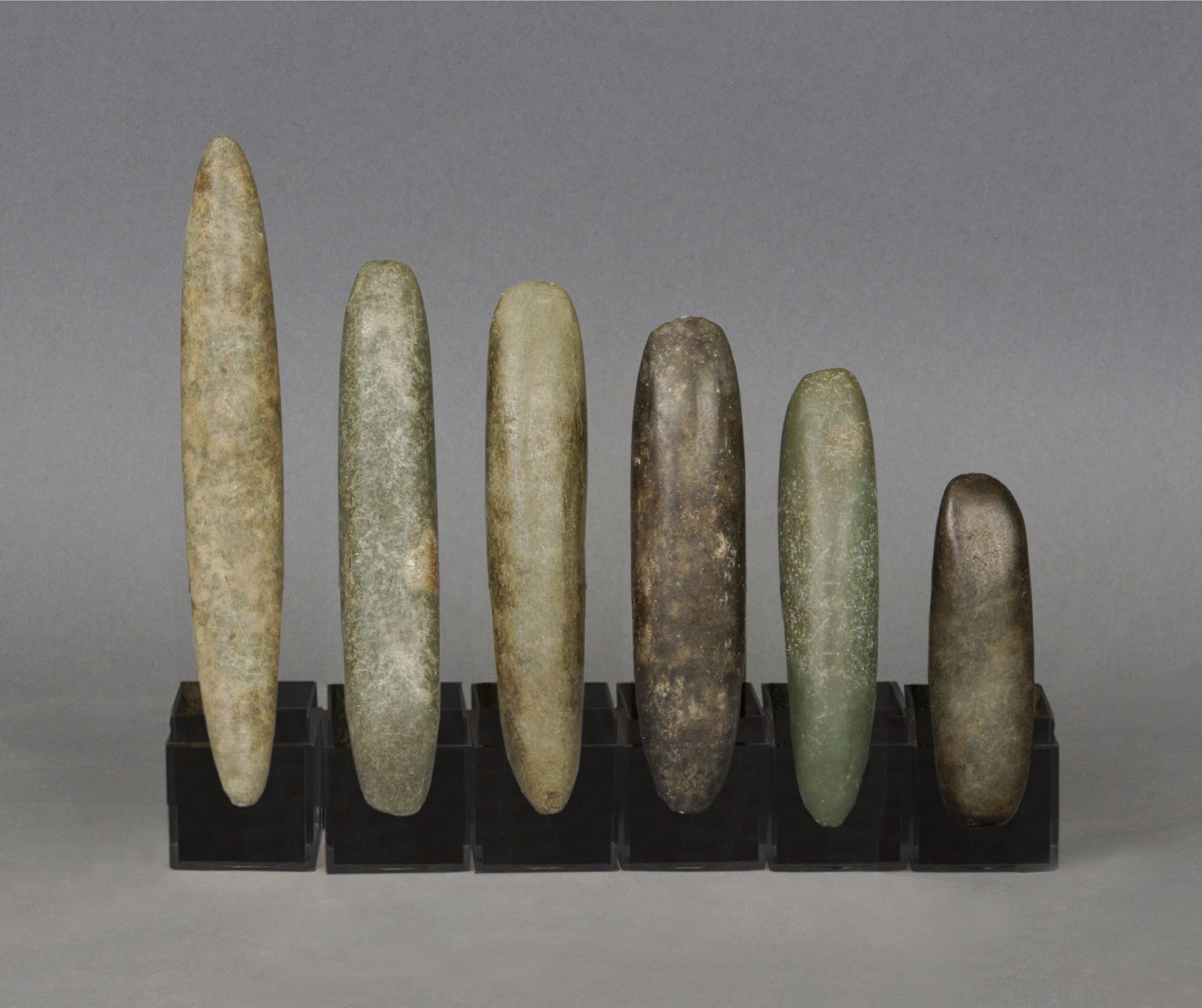
Dominican Republic, Six Pre-Taíno Gray-Green Stone Chisels
These chisels are nicely polished and do not show wear. They were most likley used for ceremonial purposes.
Period: Dominican Republic, Courian Subseries, c. 2000 BC - AD 250
Media: Stone
Dimensions: Length: 3" to 5 1/2"
98266
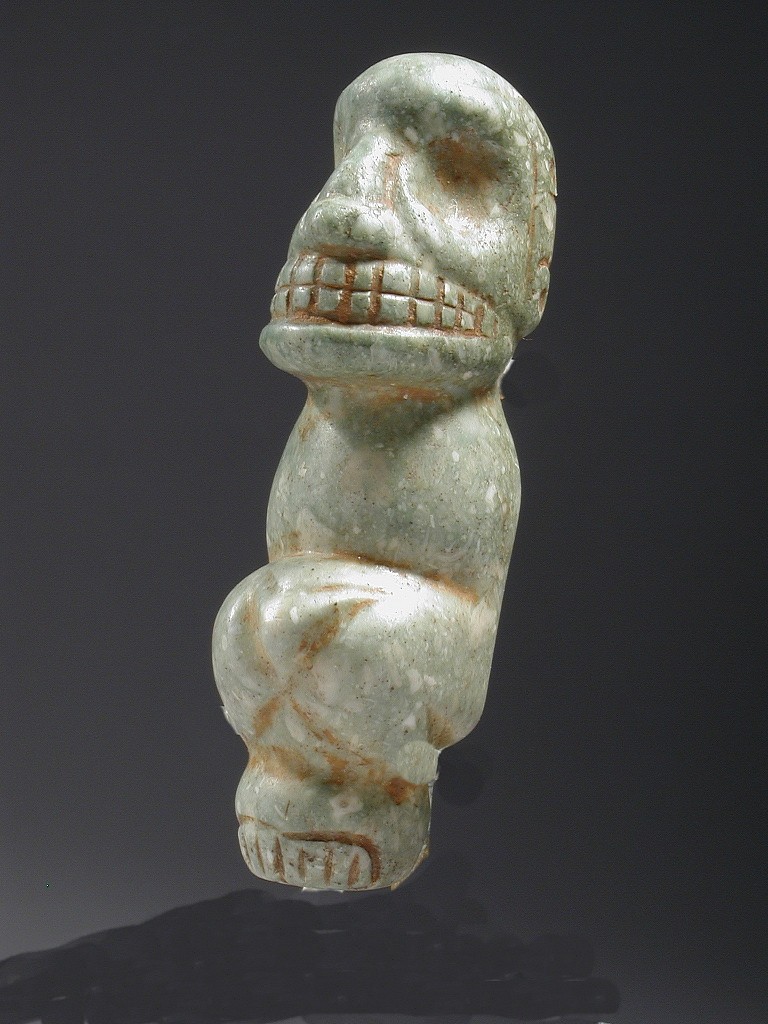
Dominican Republic, Taíno Green Stone Skeletal Figure Amulet in Crouching Position
Although small, this amulet probably had inlays of gold or shell in the eyes. It was carved from precious green stone - highly valued by the Taíno because it was the color of the Caribbean Sea, the source of life and the threshold to the otherworld. It was probably a center pendant to a necklace.
Period: Dominican Republic, Taíno , Early Classic Period, c. AD 600 - 1000
Media: Stone
Dimensions: Height 2"
MM245



Dominican Republic, Taíno White Shell Pendant of a Crouching Bat with Grimacing Mouth
Bats were considered messengers of the dead who visited the living during the night. This is a particularly large example of a bat that must have been crafted from a very large conch shell. It was probably a center pendant to a necklace.
Period: Dominican Republic, Taíno , c. AD 1000 - 1500
Media: Stone
Dimensions: Height 3 1/8"
94246
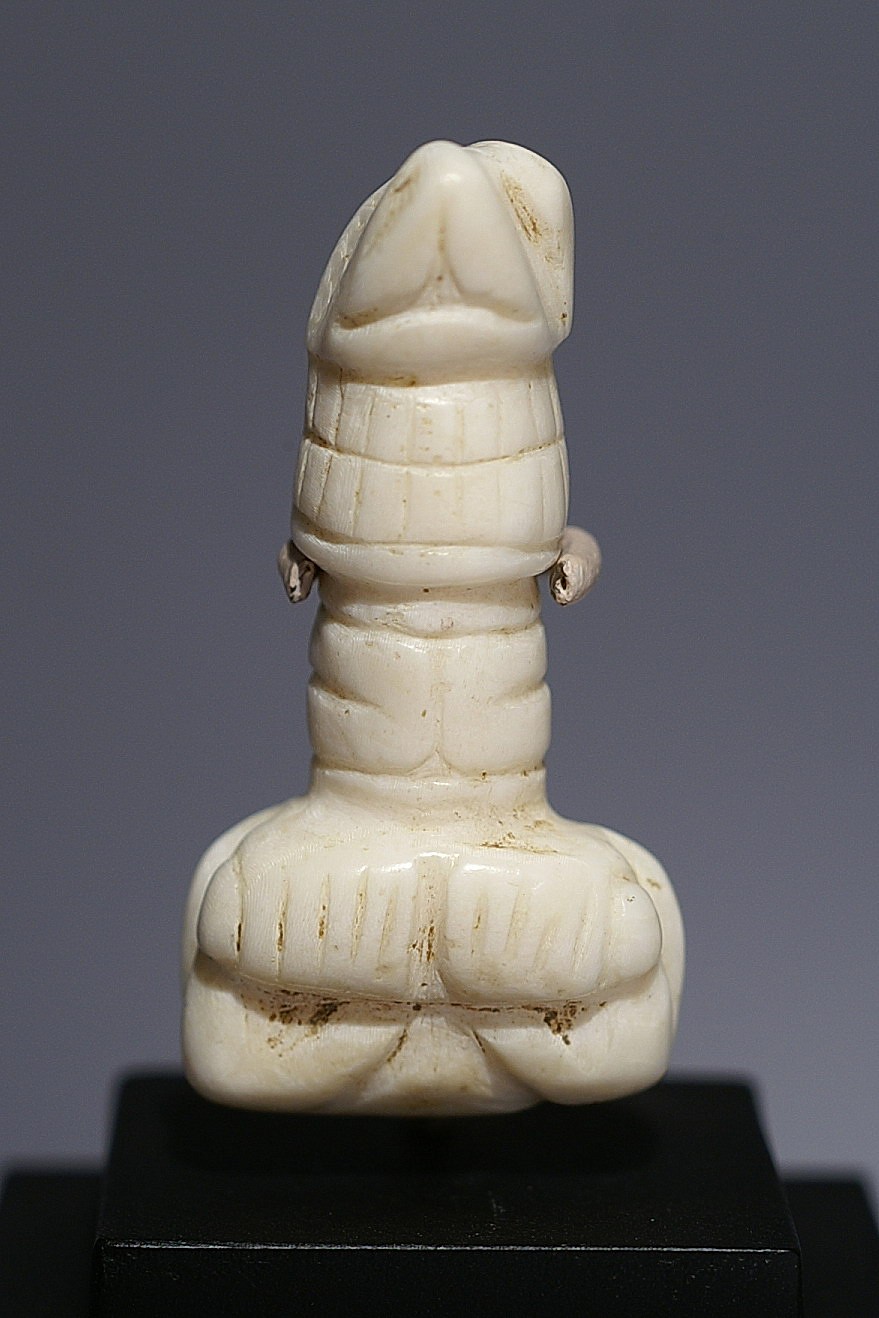
Dominican Republic, Taíno Shell Amulet of Long-necked Deity
This highly abstract and unusual carving is made from one piece of shell. This deity has a bat-like nose, large teeth in a wrap-around grin, a long neck, and arms folded over the chest. The legs contort in a forward curl terminating in prominently featured incised toes.
Period: Dominican Republic, Taíno , Early Classic Period, c. AD 600 - 1000
Media: Shell
Dimensions: Height: 1 3/8"
98424




Dominican Republic, Taíno Carved Greenstone Venus Amulet
This greenstone female figure is carved in low relief with arms crossed over her chest and a baby strapped in a bundle on her back. This amulet is decidedly rare for its maternal aspect and its naturally symbolic association to fertility. The stone is a rare form of green quartz.
Period: Dominican Republic, Ostionoid, c. AD 200 - 900
Media: Stone
Dimensions: Height: 2 1/4"
98140
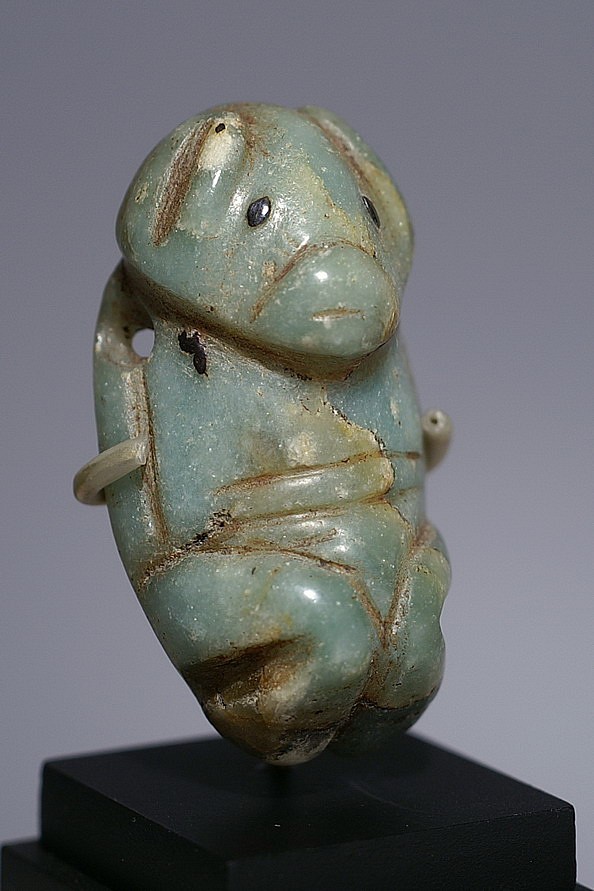


Dominican Republic, Mainland Green Stone Amulet of a Bat
It is extremely rare to find Taíno amulets made from jade or jade-like stone. The pointed ears, blunted muzzle, and the position of the extremities which resemble folded wings suggest that this is a bat idol. It's quite rare to see an amulet with inlaid stone eyes intact and perfectly set.
Period: Dominican Republic, Taíno , c. AD 1000 - 1500
Media: Stone
Dimensions: Height 1.5"
98220

Dominican Republic, Taíno Variegated Green Stone Frog Zemi
This lovely abstract zemi represents a frog. Many species of amphibians still inhabit the large islands of the Greater Antilles. The Taíno considered frogs symbols of fertility because the coqui frog mates in the spring at the beginning of the rainy season in the Caribbean.
Period: Dominican Republic, Taíno , c. AD 1000 - 1500
Media: Stone
Dimensions: Length: 1 7/8"
99327




Dominican Republic, Taíno Rare Stone Amulet of an Agouta
This amulet of a shrew is based on the species known as the Hispanolan solenodon. The solenodon is the only mammal that releases venom for protection and is identified by its elongated nose. This solenodon is only found in Hispaniola and directly descends from the Prehistoric Era. It is a very rare subject.
Period: Dominican Republic, Taíno , c. AD 1000 - 1500
Media: Stone
Dimensions: Length: 1 1/2"
99369
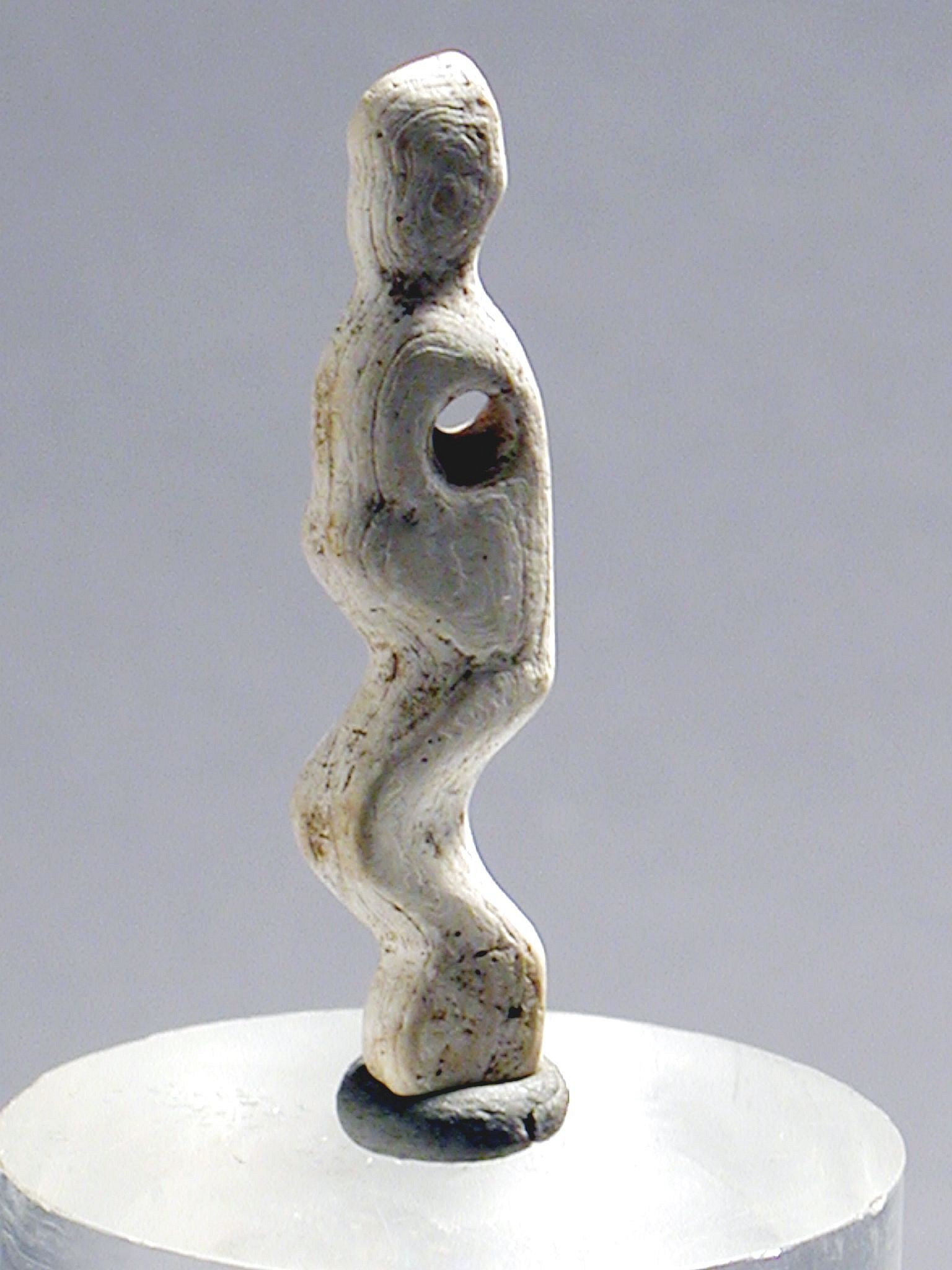
Dominican Republic, Taíno Shell Figurative Silhouette Amulet
This slender, delicate figure is a marvel of Taíno craftsmanship. This shell was worked as an abstract crouching figure with eyes, arms and legs softly modeled, and the suspension hole drilled through the back.
Period: Dominican Republic, Taíno , c. AD 1000 - 1500
Media: Basket
Dimensions: Height: 1 7/8"
99342





Dominican Republic, Taíno Carved Light Gray Stone Miniature Crouching Figure
This is a highly detailed figure for its small size. The hole runs vertically through the figure.
Period: Dominican Republic, Taíno , Early Classic Period, c. AD 600 - 1000
Media: Stone
Dimensions: Height: 3/4"
99309

Dominican Republic, Small Taíno Amulet of a Crouching Monkey in Blue-Gray Stone
In this lovely example, the craftsman selected a blue-grey stone not common in the area. The crouching figure is carved with nice details, with a simian face, large ears, and a phallus. This amulet is quite artistic.
Period: Dominican Republic, Taíno , Early Classic Period, c. AD 600 - 1000
Media: Stone
Dimensions: Height: 1"
99365
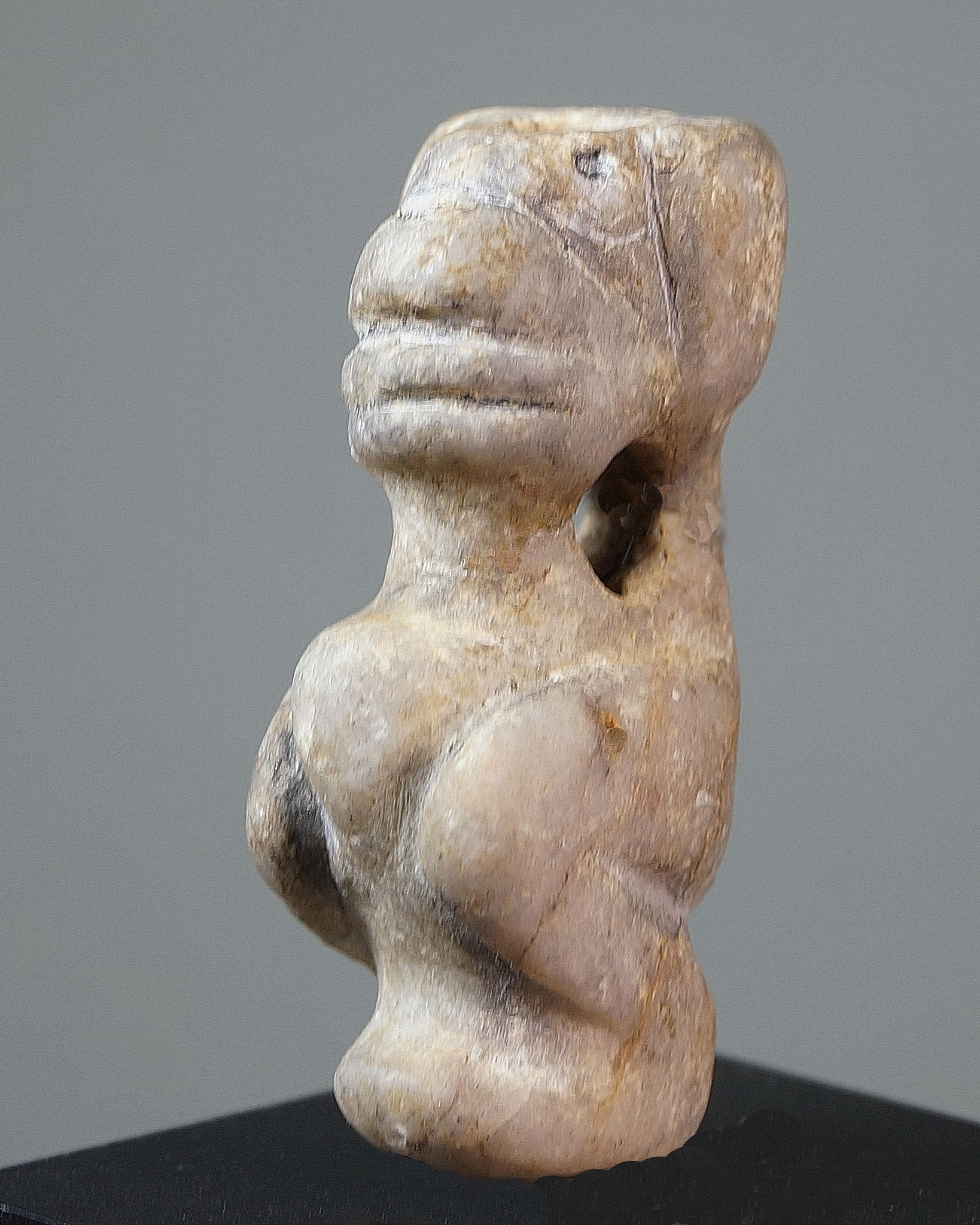
Dominican Republic, Taíno Gray-brown Stone Amulet of Crouching Dog Deity
Dogs were believed to escort the dead to the otherworld and to also watch over their spirits. They are often shown on amulets, and were worn as protective charms in memory of important ancestors.
Period: Dominican Republic, Taíno , c. AD 1000 - 1500
Media: Stone
99212

Dominican Republic, Taíno White Marble Amulet of Elongated Crouching Male Figure
This amulet has been carved into a smoothly elongated cigar-like form of a crouching male figure. The facial features are characteristically Taíno , including the broad nose and round eyes with indented pupils. It most likely represents an ancestral figure, probably a chief. It functions as both a tubular bead and an amulet, indicating that it was an important carving for the Taíno . The facial features are carefully detailed, and the arms, bent at the elbows, are folded uniformly over the belly of the figure where the hands flank a prominently incised navel, considered by the Taíno to be the spiritual center of the body and a conduit to the otherworld. When people died, they were said to have lost their navels. A similarly detailed amulet is illustrated in "Taíno : Pre-Columbian Art and Culture from the Caribbean" (1998: pl. 36).
Period: Dominican Republic, Taíno , c. AD 1000 - 1500
Media: Stone
Dimensions: Height: 2 1/4"
99211



Dominican Republic, Taíno Shell Amulet of Elongated Crouching Figure with Large Phallus
Although highly abstract, this slender talisman represents the dog-like deity that watched over the spirits of the dead.
Period: Dominican Republic, Taíno , c. AD 1000 - 1500
Media: Shell
Dimensions: Height: 1 3/8"
99277




Dominican Republic, Taíno Carved white Stone Amulet of a Crouching Skeletal Figure
It is hard to determine whether skeletal amulets represent ancestors or celebrants in cohoba ceremonies. Ancestor worship was the focus of Taíno religion, in addition to a great many animistic spirits that controlled the natural forces.
Period: Dominican Republic, Taíno , c. AD 1000 - 1500
Media: Stone
Dimensions: Height: 1"
99338



Dominican Republic, Taíno Gray-white Stone Crouching Hybrid Dog-Bat Amulet with Bulging Eyes
This small carved stone amulet holds the curious distinction of raised and rounded bulging eyes, in contrast to most types which have concave depressions in place of the eyes. The pointed ears signify a bat, but the crouching position indicates a dog figure.
Period: Dominican Republic, Taíno , c. AD 1000 - 1500
Media: Stone
Dimensions: Height: 1 1/8"
MM102

Dominican Republic, Taíno Mottled Stone Amulet of a Crouching Figure with a Wide Mouth
The amulet is also made of a speckled stone from St. Martin. In this case, the abstract crouching figure was very subtly carved out of a white and black stone. The vertical holes also are the eyes.
Period: Dominican Republic, Taíno , c. AD 1000 - 1500
Media: Stone
Dimensions: Height: 1 1/2"
99341

Dominican Republic, Taíno Stone Re-Carved Amulet Crouching Figure
Although quite abstract, this bead was carved with a figure in the crouching position characteristic of Taíno art. It is an unusual example with a jaw extending into the back paws.
Period: Dominican Republic, Taíno , c. AD 1000 - 1500
Media: Stone
Dimensions: Height: 1 1/4"
99346

Dominican Republic, Taíno Mottled Amulet of a Crouching Figure
The Taíno likely made these ornaments from this uniqe speckled stone from St. Martin. The patterning intentionally creates visual ambiguity, representing dualism and otherworld spirits.
Period: Dominican Republic, Taíno , c. AD 1000 - 1500
Media: Stone
Dimensions: Height: 13/8"
99340
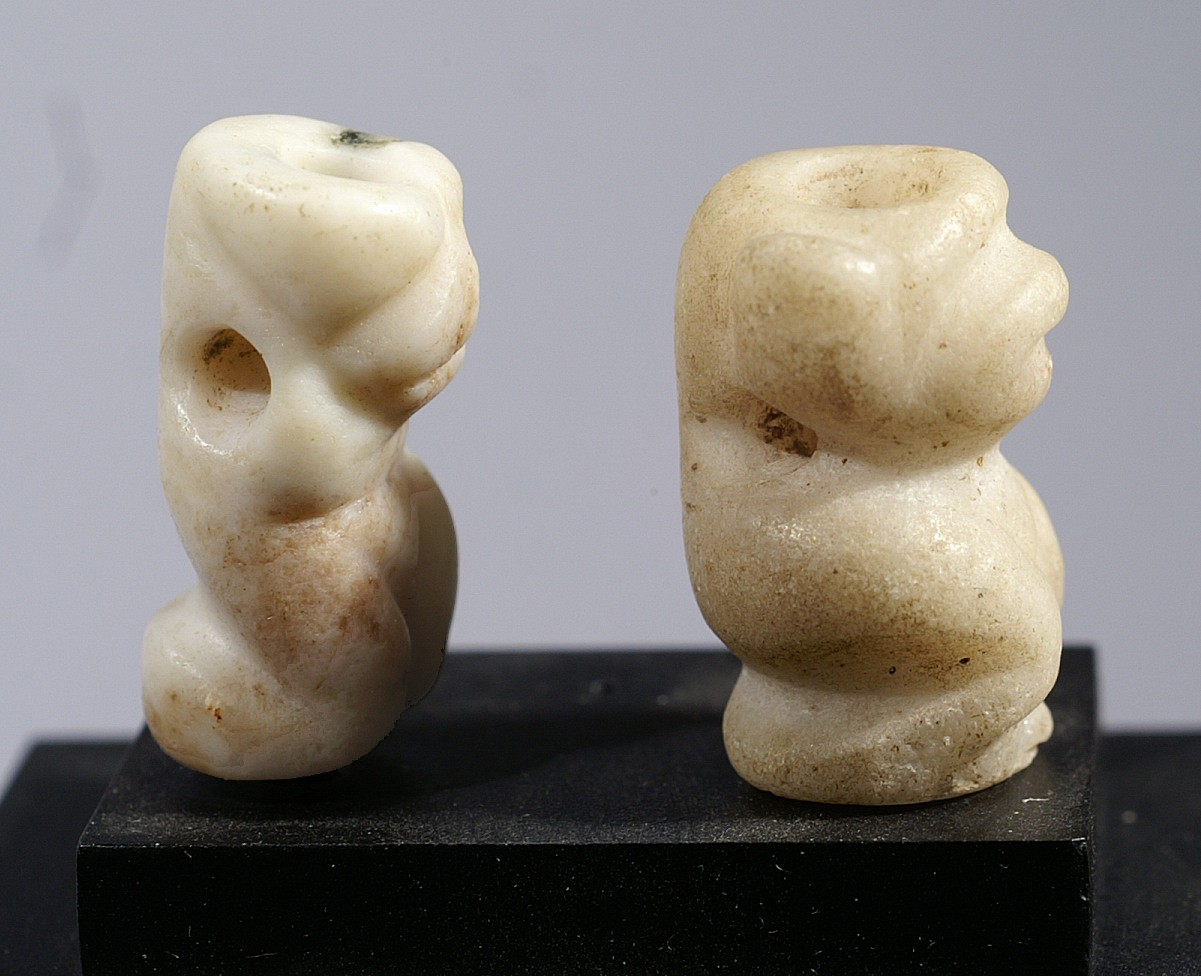



Dominican Republic, Taíno Miniature Amulets of 2 Crouching Dog Figures
Dogs were believed to escort the dead to the otherworld and to also watch over their spirits. They are often shown on amulets and were worn as protective charms in memory of important ancestors. When a chief died, some of his amulets were buried with him, but the majority were given as gifts to secure the allegiance of lords to the successive chief.
Period: Dominican Republic, Taíno , c. AD 1000 - 1500
Media: Stone
Dimensions: Height: 6/8" each
99373

Dominican Republic, Taíno Group of Small Dog-like Deities in Various Types of Stone
Dogs were believed to escort the dead to the otherworld and to also watch over their spirits. They are often shown on amulets, and talismans such as these were protective charms in memory of important ancestors.
Period: Dominican Republic, Taíno , c. AD 1000 - 1500
Media: Stone
Dimensions: Green: 7/8"; b/w: 5/8"; b/tan: 1 1/4"
99278



Dominican Republic, Taíno Amulet of a Abstracted Stone Crouching Figure
This strange figure is extremely abstract with only a straight line for a mouth and pronounced crouching legs. It has both vertical and horizonal drill holes. There is drilled horizontal suspension hole accross from the mouth.
Period: Dominican Republic, Taíno , c. AD 1000 - 1500
Media: Stone
Dimensions: Height: 7/8"
99321

Dominican Republic, 10 Tiny Carved Stone Stylized Crouching Figurative Amulets
These miniature amulets are microcosms of the original larger amulets; they are near-perfect replicas. Shamans would have given a small amulet to a suffering person to swallow in order to ward off evil spirits. These protective amulets were also worn on necklaces.
Period: Dominican Republic, c. AD 1000 - 1500
Media: Stone
Dimensions: Height: 1/2" to 1"
99529

Dominican Republic, Seven Broken Figurative Amulets of Different Materials
These broken amulets are historically significant because the broken points reveal the method of carving and drilling. They all seem to have been broken at the horizontal suspension hole. The amulets were not discarded; they were found in tombs and were valued even as fragments. Several of the pieces still have traces of red pigment.
Period: Dominican Republic, Taíno , c. AD 1000 - 1500
Media: Stone
Dimensions: Lengths vary from 1/2" to 1"
99390



Dominican Republic, Taíno Stone Miniature Amulet with Janus Head
Double-faced Janus skeleton figures share the same body, carved as a phallic shape. Images of skeletal faces with erect phalluses are characteristic of Taíno art and seem to symbolize the dualism and paired opposition of life and death.
Period: Dominican Republic, Taíno , c. AD 1000 - 1500
Media: Stone
Dimensions: Height: 1"
99224C

Dominican Republic, Taíno White Stone Large-Headed Amulet with Stylized Headdress
This amulet has an enormous head, a stylized headdress or hairdo, and simplified facial features. The seemingly legless, disproportionately small body has two drill holes which function both for suspension and to distinguish the arms which curl inwardly. When viewed from the back the shape of the buttocks is revealed, indicating that this is a crouching figure.
Period: Dominican Republic, Taíno , c. AD 1000 - 1500
Media: Stone
Dimensions: Height: 1"
99226
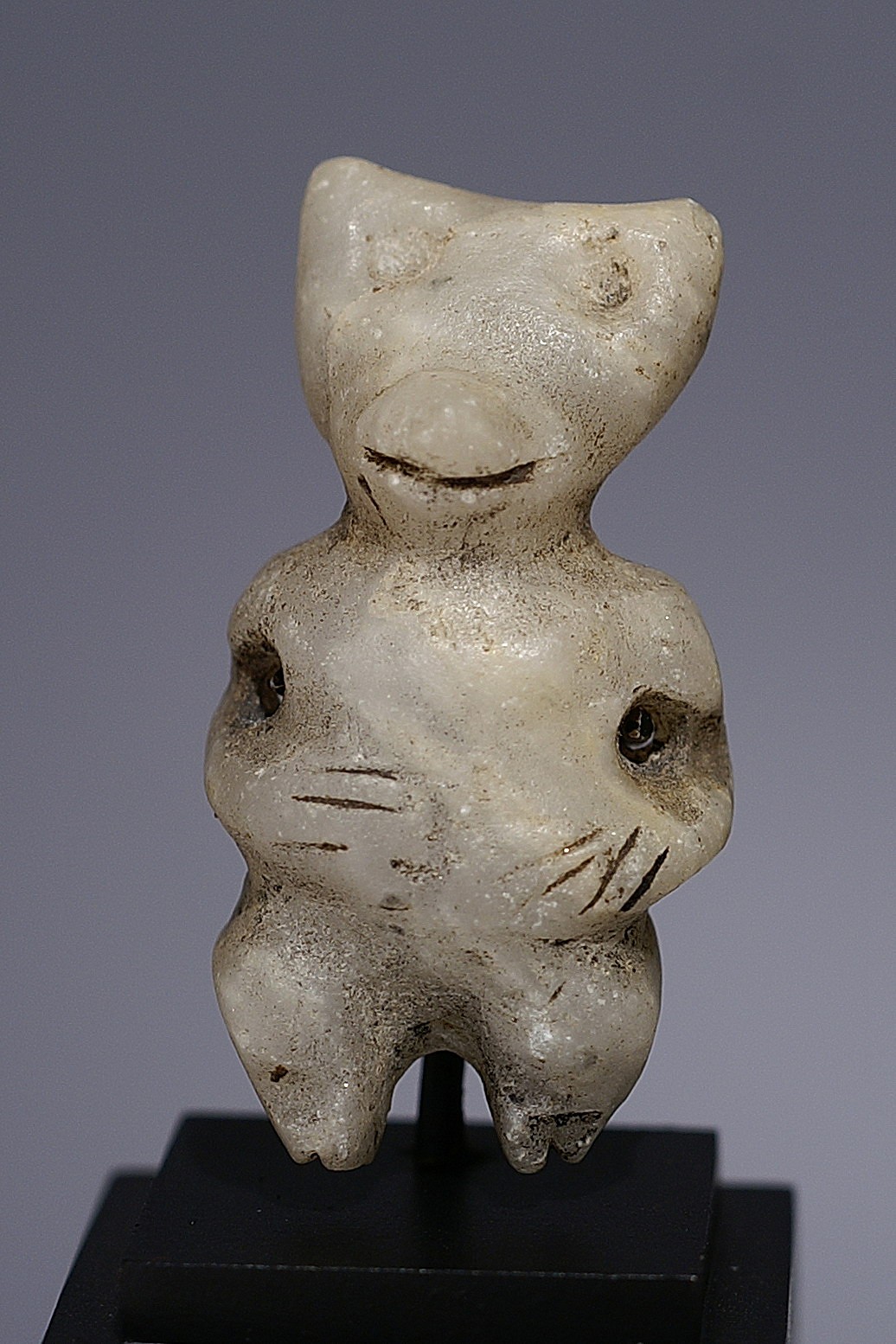
Dominican Republic, Taíno Stone Dog Pendant
Dogs were believed to escort the dead to the otherworld. They were worn as protective charms in memory of important ancestors.
Period: Dominican Republic, Taíno , c. AD 1000 - 1500
Media: Stone
Dimensions: Height: 1.5"
98392
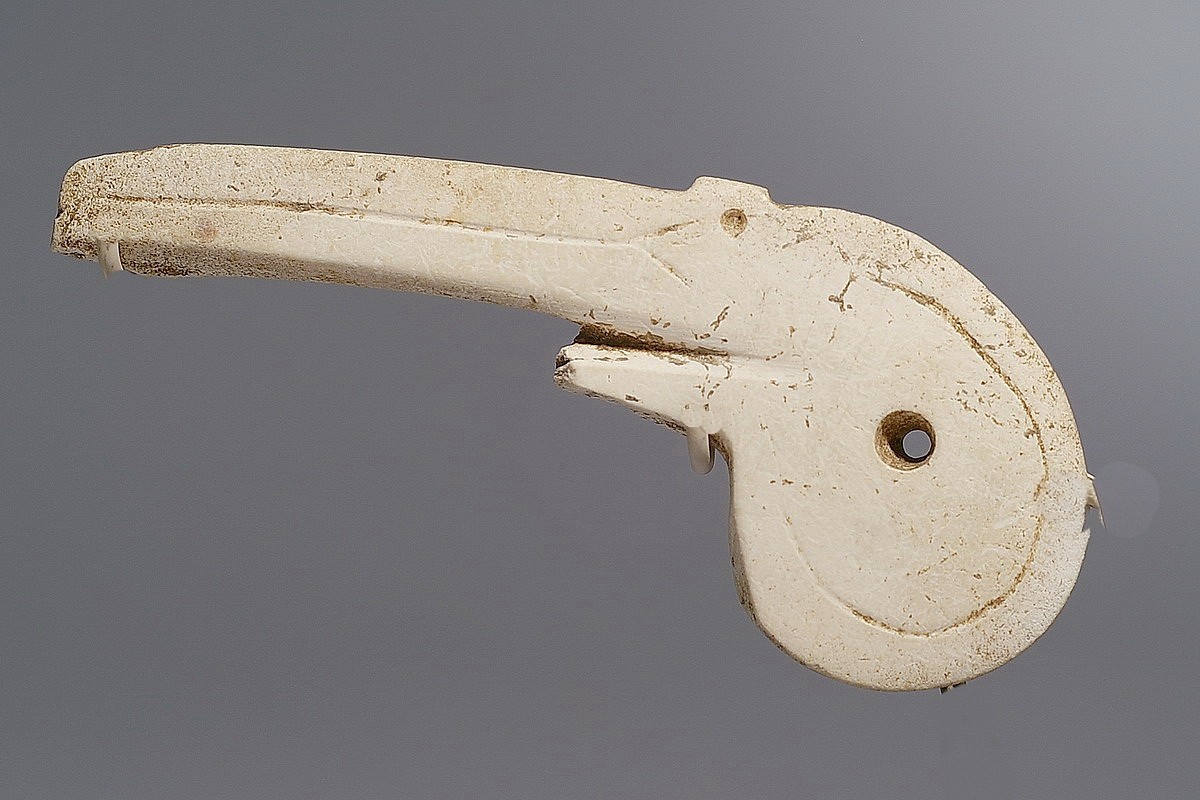
Dominican Republic, Taíno Shell Amulet in the Form of a Pelican Head
This shell amulet is incised as a pelican head in profile, with the suspension hole in the center of the head naturally forming the eye. The shell used to create this amulet must have originally been quite in to provide a flat surface with a curve to form the pelican’s beak.
Period: Dominican Republic, Taíno , c. AD 1000 - 1500
Media: Shell
Dimensions: Length: 3 3/4"
99221

Dominican Republic, Taíno Stone Birds' Head Pendant
Birds are common motifs in Taíno art and were surely consumed as food by the Taíno in addition to being valued for their plumage. These pendants were worn by shamans.
Period: Dominican Republic, Taíno , c. AD 1000 - 1500
Media: Other
Dimensions: Height: 1 1/4"
98224
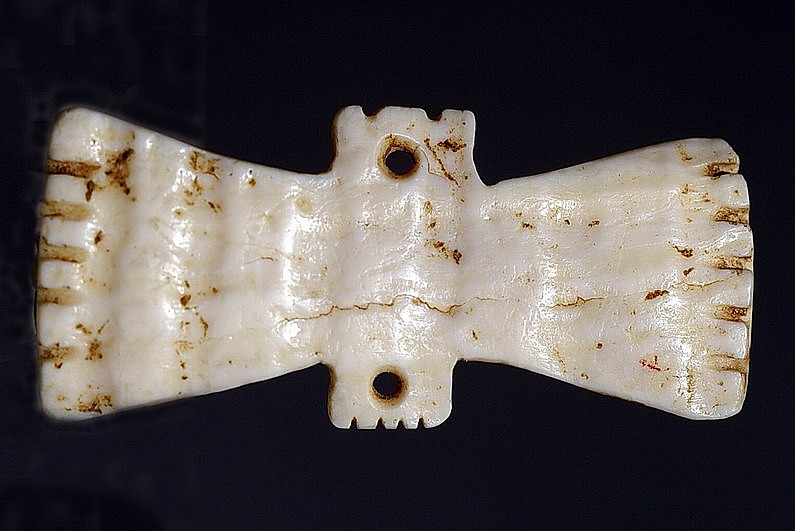
Dominican Republic, Taíno Shell Ornament in the Form of a Double Bat
The circular mouth openings in each bat head suggest that this ornament was sewn onto a garment or headband. Bats were considered to be messengers of the dead from the otherworld, and clothing appliqués such as this represented the spirit of a revered ancestor.
Period: Dominican Republic, Taíno , c. AD 1000 - 1500
Media: Shell
Dimensions: Length: 1 1/2"
99335



Dominican Republic, Taíno Miniature Stone Duck Amulet
The duck is a common motif in Taíno art, and ducks were surely consumed as food. This miniature bead is particularly charming for its small size, with modeled wings and beak. There is a suspension hole through the neck. The stone is a type of quartz with a warm honey color.
Period: Dominican Republic, Taíno , c. AD 1000 - 1500
Media: Stone
Dimensions: Height: 1/2"
99336

Dominican Republic, Taíno Quartz Amulet of a Rare Antillean Nighthawk
The Antillean Nighthawk is a rare nocturnal bird that once inhabited the Greater Antilles in greater numbers and is now endangered. Bird feathers were valued for their ornamental qualities. This miniature example was selected for the purity of the quartz stone.
Period: Dominican Republic, Taíno , c. AD 1000 - 1500
Media: Stone
Dimensions: Length: 1/2"
99366


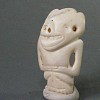
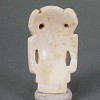

Dominican Republic, Taíno Carved Shell Amulet of a Figure with a Bat Face
This bat deity amulet features a stylized human figure with bat-like features, such as large ears and a pug nose. There are two suspension holes below each ear. This amulet was likely originally the central bead on a larger beaded necklace.
Period: Dominican Republic, Taíno , c. AD 1000 - 1500
Media: Shell
Dimensions: Height: 1 1/2"
98149

Dominican Republic, Taíno White Shell Amulet in the Form of a Toucan
This stylized bird form including the large eyes, beak, and plumage was favored by the Taíno . The hole at the bottom of the amulet is an unusual design and indicates that the amulet may have been placed on the forehead. The shell is especially white.
Period: Dominican Republic, Taíno , c. AD 1000 - 1500
Media: Shell
Dimensions: Height: 1 1/2" x Width: 1/2"
MM182

Dominican Republic, Taíno Stone Amulet of an Owl
A re-carved bead from a larger broken amulet, in the form of what appears to be an abstract owl.
Period: Dominican Republic, Taíno , Early Classic Period, c. AD 600 - 1000
Media: Stone
Dimensions: Length: 1 1/4"
99330




Dominican Republic, Taíno Stone Seated Dog-like Deity Figure
This amulet is an abstracted crouching variation on the theme of the Taíno dog deity.
Period: Dominican Republic, Taíno , c. AD 1000 - 1500
Media: Stone
Dimensions: Height: 7/8"
99322



Dominican Republic, Taíno Tan Stone Amulet with a Chubby Dog Crouching Figure
Dogs were believed to escort the dead to the otherworld. They are often shown on amulets, and were worn as protective charms in memory of important ancestors.
Period: Dominican Republic, Taíno , c. AD 1000 - 1500
Media: Stone
Dimensions: Height: 1 1/8"
MM104

Dominican Republic, Three Taíno Carved Shell Abstract Frogs
These delicate miniature appliqués belonged to a larger set that once covered the cape of a chieftain. The Taíno conquered their neighbors on the Turks and Caicos Islands in the Bahamas to obtain the best shells in the region.
Period: Dominican Republic, Taíno , c. AD 1000 - 1500
Media: Shell
Dimensions: Height: 5/16" each
99310

Dominican Republic, Three Taíno Carved Shell Abstract Frogs
These delicate miniature appliqués belonged to a larger set that once covered the tunic or cape of a chieftain.
Period: Dominican Republic, Taíno , c. AD 1000 - 1500
Media: Shell
Dimensions: Height: 5/8" each
99311



Dominican Republic, Six Taíno Miniature Shell Abstract Frog Ornaments
These extremely delicate miniature appliqués likely belonged to a larger set that would have covered the cape of a chieftain, or they may have been elements to a necklace or bracelet. The Taíno conquered their neighbors on the Turks and Caicos Islands in the Bahamas to obtain the best shells in the region, for the production of jewelry. At least one archaeological site there has been identified as a craft village.
Period: Dominican Republic, Taíno , c. AD 1000 - 1500
Media: Shell
Dimensions: Height Range: 3/8" to 7/8"
99357



Dominican Republic, Six Taíno Miniature Shell Highly Abstract Frog Ornaments
Frog-shaped amulets were often worn as protective charms in memory of important ancestors. These examples have amulet suspension holes as well as vertical drill holes, suggesting that each frog was made in the same abstract linear format in descending size. The smallest frog in this group is one of the smallest known pieces of its kind.
Period: Dominican Republic, Taíno , c. AD 1000 - 1500
Media: Stone
Dimensions: Height: 1/4" to 1 1/4"
99359

Dominican Republic, Taíno Abstracted Dolphin Amulet
This amulet represents a dolphin, and was carved from a manatee bone. The exaggerated eyes and teeth are carved in typical Taíno fashion. This may have been the central amulet of a necklace with surrounding shell beads.
Period: Dominican Republic, Taíno , c. AD 1000 - 1500
Media: Bone
Dimensions: Length: 3"
96096

Dominican Republic, Taíno Mottled Green Stone Amulet in the Form of a Crustacean
The Taíno ate a lot of marine life, especially species in the shallow water close to the shoreline, including turtles, crustaceans and shells. In this case, the green stone echoed the color of the Caribbean from where the crayfish came. Crustaceans were rarely seen in Taíno art as amulets.
Period: Dominican Republic, Taíno , c. AD 1000 - 1500
Media: Stone
Dimensions: Length: 1"
99362

Dominican Republic, Taíno Miniature Applique
This is a rare portrayal of the skull of a cacique (tribal chieftain) seated on a ceremonial duho. A duho is a carved wooden seat used by Taíno caciques for spiritual medicine rituals. The lower part of the duho depicts two animal heads.
Period: Dominican Republic, Taíno , c. AD 1000 - 1500
Media: Shell
Dimensions: Length: 1/2"
98134

Dominican Republic, Taíno Speckled Stone Amulet of a Chief Sitting on a Duho Stool
This is a rare portrayal of a cacique seated on his ceremonial duho. Duhos were seats that only chiefs were allowed to use. The speckled quartz stone matrix had obvious appeal to the Taíno craftsman.
Period: Dominican Republic, Taíno , c. AD 1000 - 1500
Media: Stone
Dimensions: Length: 2"
M4072
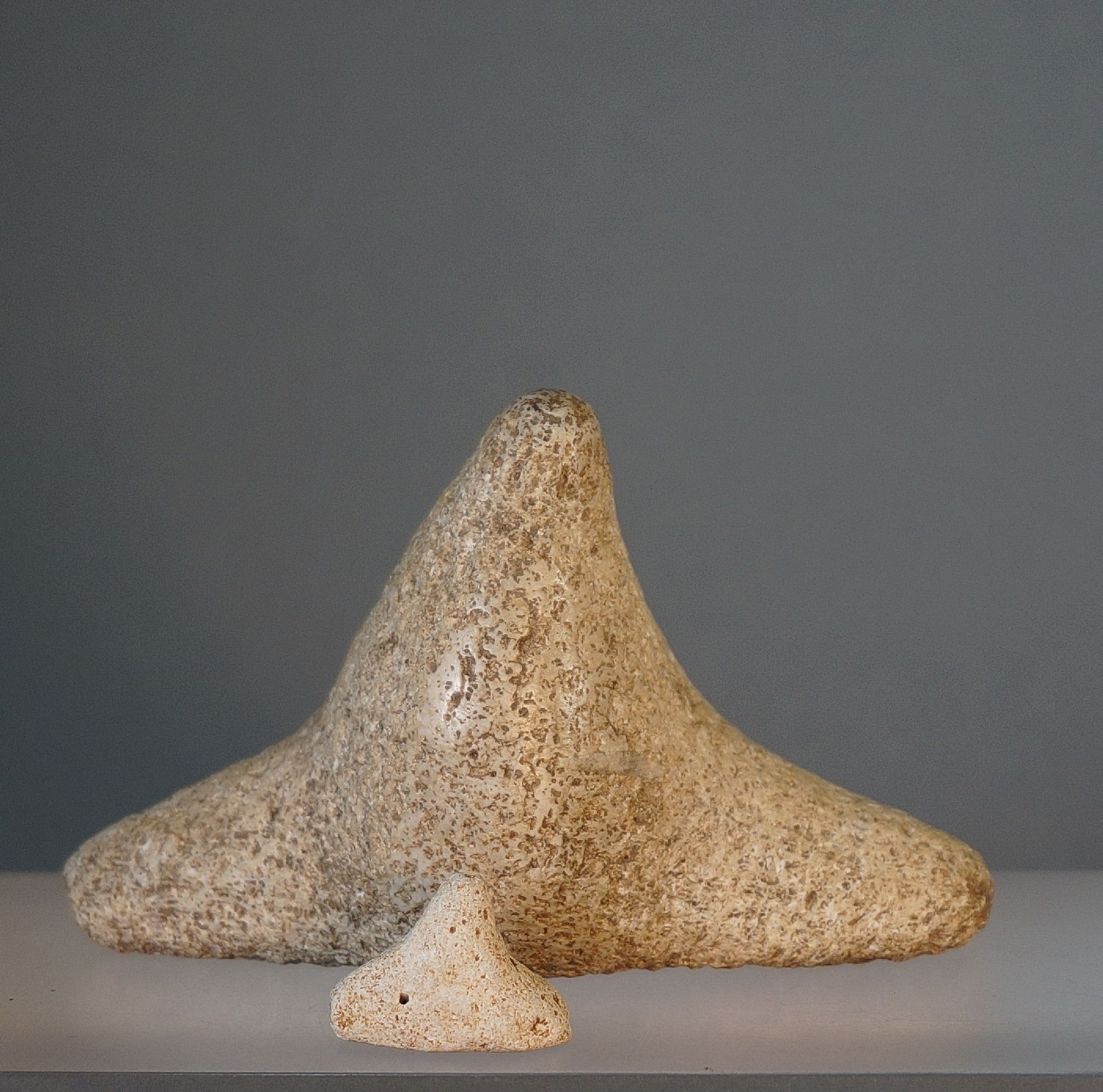



Dominican Republic, Taíno Coral Large MiniatureThree-Pointer
Coral three-pointers were made as early as 400 BC. Over time, the three-pointer’s form evolved to a longer profile. This example is large for its type and is well modeled with a polished surface. The smaller three-pointer shows the relative extremes in size.
Period: Dominican Republic, Taíno , c. AD 1000 - 1500
Media: Stone
Dimensions: Height Range: .5" - 2.5"
99347

Dominican Republic, Taíno Set of Three Stone Zemi Three-Pointers
The set consists of three Taíno stone zemi three-pointers. One is marble, the other two are coral. Similar coral and marble zemis are pictured in L'Arte Taíno , page 187.
Period: Cuba, Classic Taíno , c. AD 1000 - 1500
Media: Stone
Dimensions: Range from 1 3/4" wide & 1" high to 2 3/4" wide to 1 3/4" high.
99144B



Dominican Republic, Two Taíno Miniature Three-Pointers in Early Sculptural Stages
One of these three-pointers is sandstone with two indentations, and the other is stone with a face in the front and legs in the back. These stones are in the early stages of carving, revealing the design process
Period: Dominican Republic, Taíno , c. AD 1000 - 1500
Media: Stone
Dimensions: Height: 1"
99223B

Dominican Republic, Three Taíno Coral Miniature Three-Pointers
Small coral three-pointers were made as early as 400 BC, and were brought into the Caribbean by the predecessors of the Taíno . It's possible that these examples belong to this early migration period during AD 400 to 800.
Period: Dominican Republic, Taíno , c. AD 1000 - 1500
Media: Shell
Dimensions: Height Range: 1/2 to 1"
99448

Dominican Republic, Six Early Phase Taíno Coral Miniature Three-Pointers of the Early Phase
Small coral three-pointers were made as early as 400 BC, and were brought into the Caribbean by the predecessors of the Taíno . It's possible that these examples belong to this early migration period during AD 400 to 800.
Period: Dominican Republic, Taíno , Early Classic Period, c. AD 600 - 1000
Media: Shell
Dimensions: Height Range: 1/2 to 1"
99447

Dominican Republic, Two Taíno Marble Miniature Three-pointers
These were well carved from hard marble, which would have made the task more difficult due to their small size.
Period: Dominican Republic, Taíno , c. AD 1000 - 1500
Media: Stone
Dimensions: Height: 1/2" and 5/8"
99372
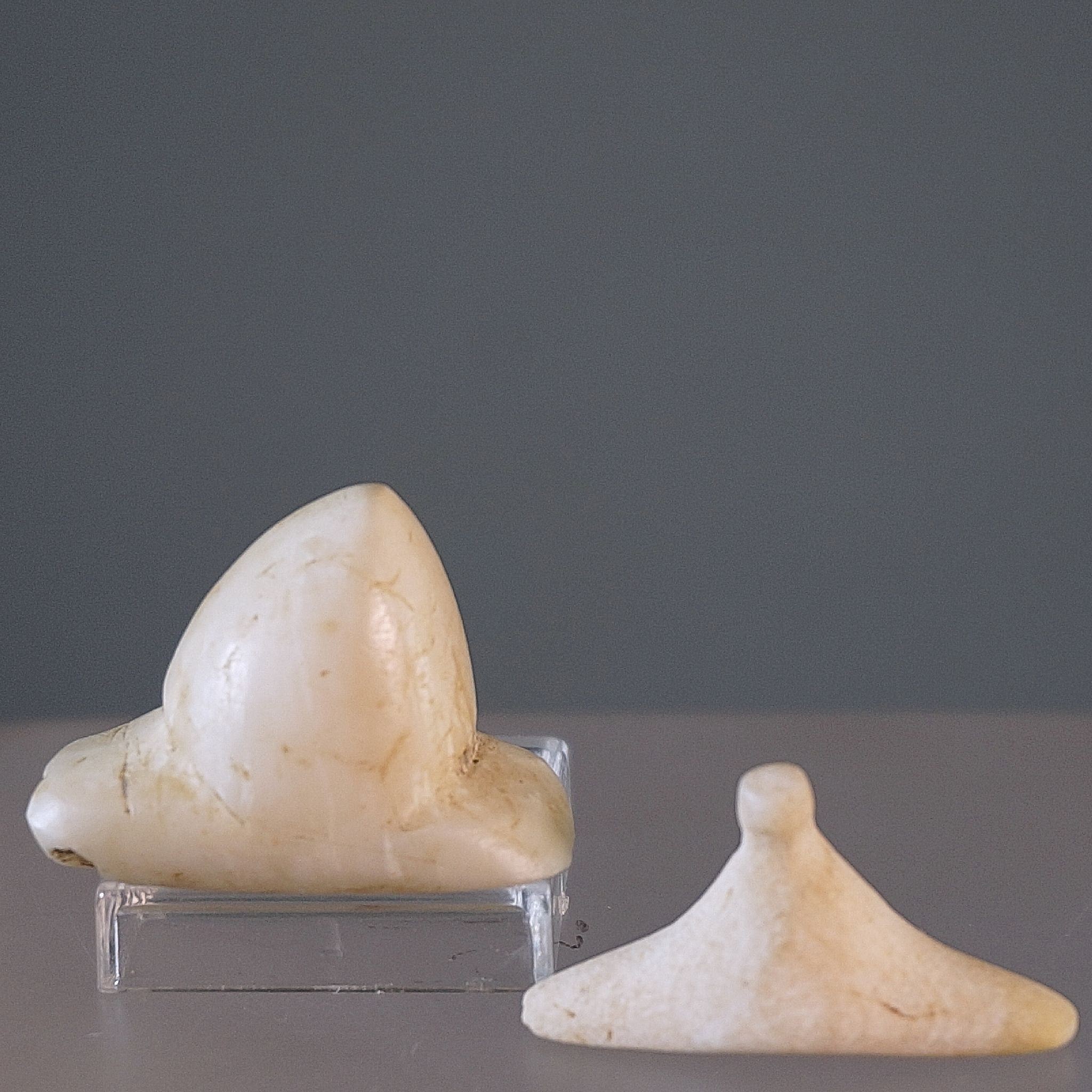
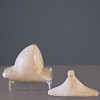

Dominican Republic, Two Taíno Hard Shell Miniature Three-Pointers of Unusual Shape
These unusual shaped three-pointers, used as personal totems, were made of carefully selected seashells such as welks. The unusual shape may be from provincial manufacture.
Period: Dominican Republic, Taíno , c. AD 1000 - 1500
Media: Stone
Dimensions: Height: 1/2" to 3/4"
99350
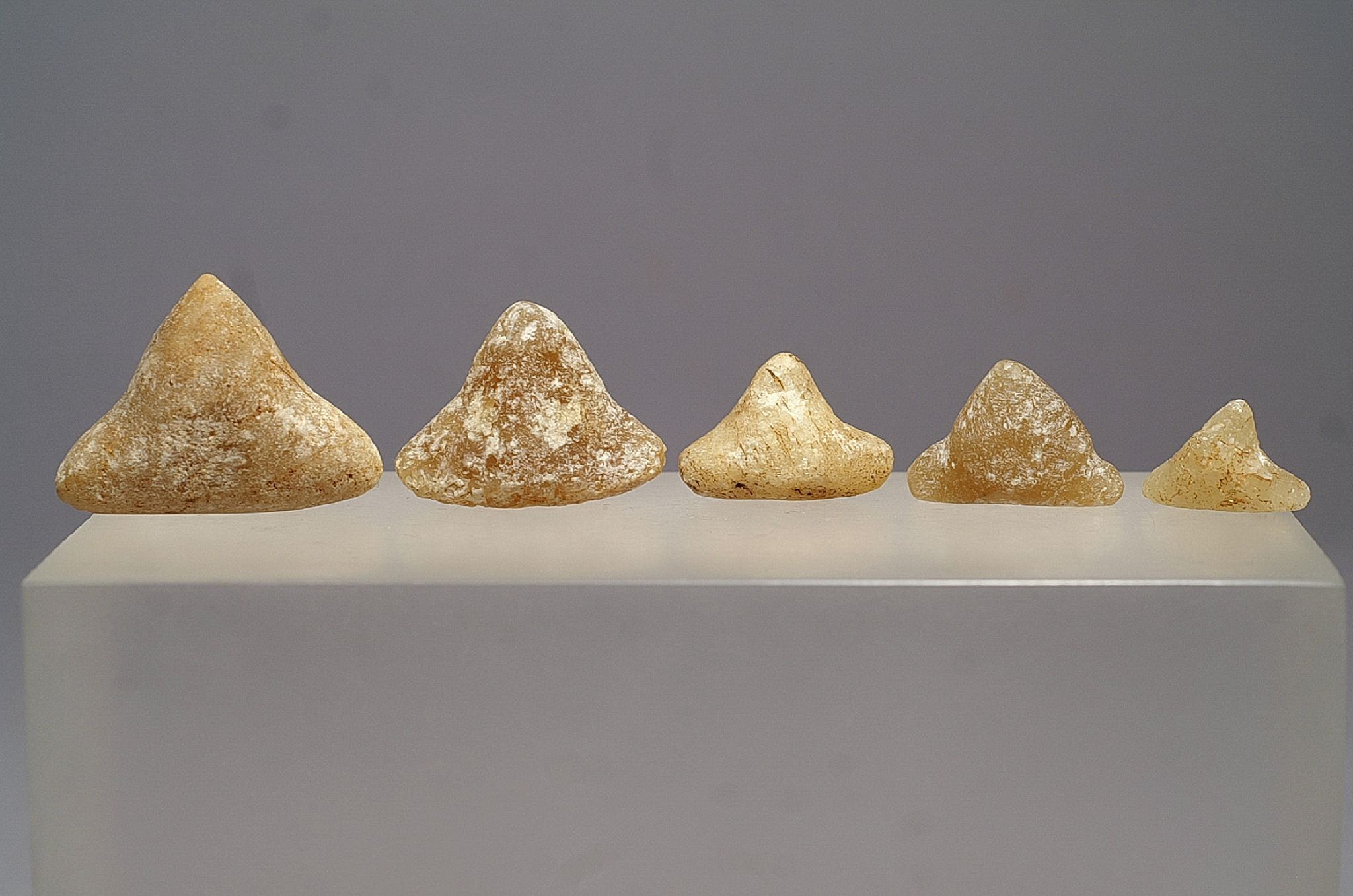


Dominican Republic, Five Taíno Miniature Quartz Three-Pointers
Quartz and rock crystal were prized for their power as sacred stones that enabled shamans to see into the otherworld of spirits and ancestors. This group of three-pointers is from the earlier Taíno period.
Period: Dominican Republic, Taíno , Early Classic Period, c. AD 600 - 1000
Media: Stone
Dimensions: Height Range: 1/2" to 1 1/4"
99348




Dominican Republic, Taíno Pecked Stone Head Talisman
This small stone was carefully polished and then pecked all over the back and around the sides of the face and mouth. It is not an amulet, but probably functioned as a protective talisman.
Period: Dominican Republic, Taíno , c. AD 1000 - 1500
Media: Stone
Dimensions: Height 1 1/8"
MM244a



Dominican Republic, Taíno Carved Shell Skull with Deep Socket Eyes and Ear Ornaments
This is a head broken off from a carved figure. It was broken at its weakest point, at the drill hole beneath the chin.
Period: Dominican Republic, c. AD 1000 - 1500
Media: Shell
Dimensions: Height: 5/8"
99157
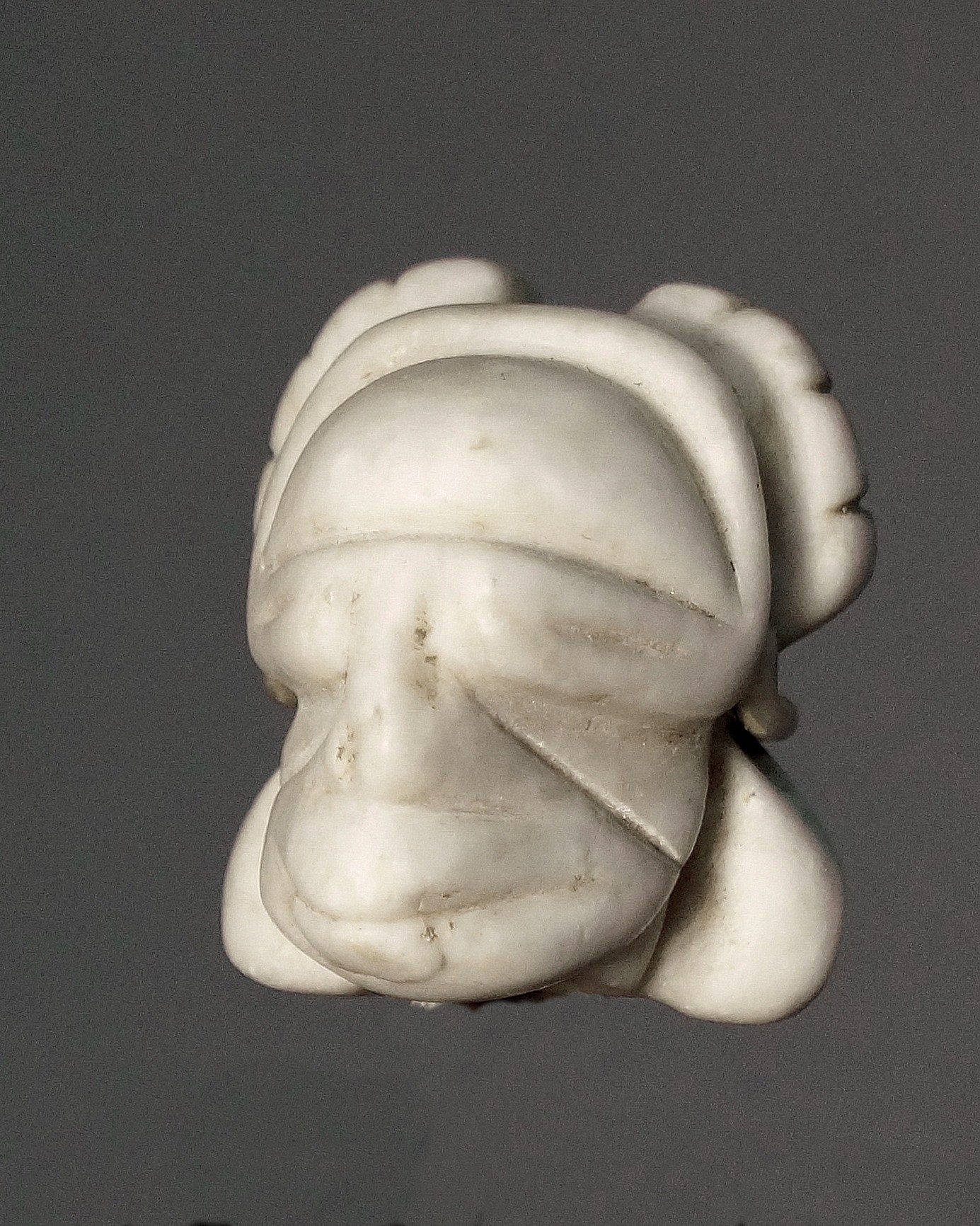


Dominican Republic, Taíno Carved White Marble Amulet of a Deity Head with Closed Eyes
This head was once a part of a larger figurine. Broken in ancient times just below the chin, the stone was re-carved and used as an amulet.
Period: Dominican Republic, Taíno , c. AD 1000 - 1500
Media: Stone
Dimensions: Height: 1 3/8"
98425



Dominican Republic, Taíno Stone Skull Head Fragment with Earrings and Skull Cap
This fragment from a figurine represents the portrait of a deceased chief, complete with earrings and the rounded caps worn by caciques and cultural heroes from the spirit world.
Period: Dominican Republic, Taíno , Early Classic Period, c. AD 600 - 1000
Media: Stone
Dimensions: Height: 1"
99337
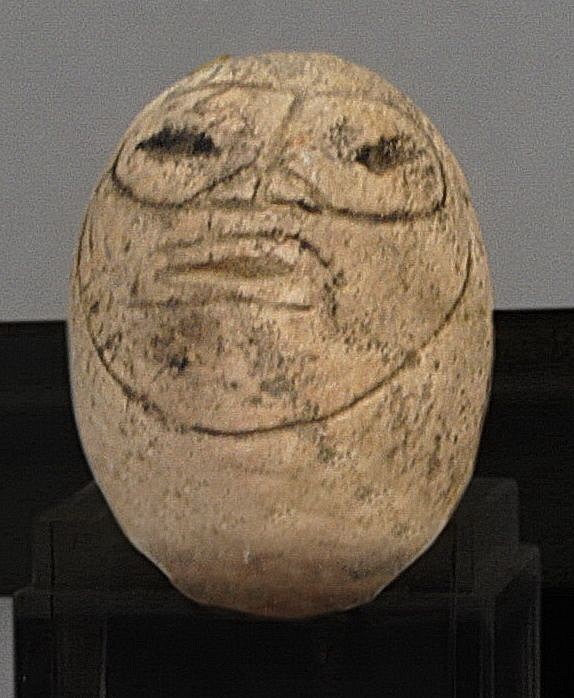


Dominican Republic, Small Tan Stone Ball with Incised Face
The face has eyes encircled with a mask. This stone could have been used as a talisman.
Period: Dominican Republic, Saladoid Culture, Pre-Taíno , c. 400 BC - AD 600
Media: Stone
Dimensions: Height: 1 1/8"
99365B

Dominican Republic, Taíno Stone Amulet with Central Drill Hole
This wonderfully abstract amulet, whose rounded shape is echoed by the large circular drill hole, portrays a chief with his cap indicating high status.
Period: Dominican Republic, Taíno , c. AD 1000 - 1500
Media: Stone
Dimensions: Height: 1 1/4"
99319

Dominican Republic, Taíno Stone Jutia Fragment
The rat-like creature known to the Taíno as the jutia was a highly sought after food source. The jutia has distinctive facial features, notably large eyes and a short, flat muzzle. Jutia occasionally appear as amulets and other art forms. Consumption of jutia took place on such a large scale that it is now almost an extinct species in the Caribbean.
Period: Dominican Republic, Taíno , c. AD 1000 - 1500
Media: Stone
Dimensions: Length: 1"
99323

Dominican Republic, Taíno White Shell Three-Pointer with Unusual Face
The face is made around the shape of the shell and was carved as a three-pointer. This one is unusual in that the mouth with its carved teeth is open and has a small hole. The grimacing face surely represents a spirit from the otherworld.
Period: Dominican Republic, Taíno , c. AD 1000 - 1500
Media: Shell
Dimensions: Height: 1 1/4"
98222



Dominican Republic, Taíno Necklace Composed of Operla Snail Shells
These cone snail (gastropoda Conidae) shells were by the ancient Taíno as beads and would have been worn on necklaces by people of high wealth and status. The beads are ancient, but this necklace is modern assembled, with a design that resembles an ancient necklace.
Period: Dominican Republic, Taíno , c. AD 1000 - 1500
Media: Shell
Dimensions: Length: 21"
99376



Dominican Republic, Taíno Pez Espada Necklace
This necklace is comprised of approximately 50 ancient carved bonefish spines. Each spine is drilled at the base and strung so that all of the elements can hang with the same orientation outwards. This necklace was re-strung with modern string.
Period: Dominican Republic, Taíno , c. AD 1000 - 1500
Media: Bone
Dimensions: Length: 20"
Approximate size of each bone: 2 1/2"
99225B



Dominican Republic, Taíno Stone and Shell Necklace
This necklace has an assortment of stone and shell beads put together to give the viewer a sense of what ancient Taíno necklaces would have looked like as worn by chiefs. Only chiefs were allowed to wear necklaces of stone beads, which are featured in the creation story as documented by Columbus' missionary, Fra Ramón Pané.
Period: Dominican Republic, Taíno , c. AD 1000 - 1500
Media: Shell
Dimensions: Length: 28"
99375

Dominican Republic, Taíno Necklace of 40 Stylized Shell Key-Shaped Beads
This beautiful necklace features abstract key-shaped beads carved from very hard shell. The "keys" feature delicate craftsmanship with many small details which would have required great skill and effort to create. The necklace likely belonged to a cacique and may have been used as part of a healing ritual.
Period: Dominican Republic, Taíno , c. AD 1000 - 1500
Media: Shell
Dimensions: Keys vary in length, with an average of 1 1/2".
Total length of necklace: 9".
99770

Dominican Republic, Taíno Necklace with a Variety of Carved Discoidal Shell and Stone Beads
The shell and stone beads in this necklace are varied in size, material, and color, including several rare miniature turquoise beads. There are several carved shell beads known as llaves, or key-shaped forms. All the stones were drilled and polished. The Taíno artists were known for their miniature stone works, including beads, amulets, axes, and even miniature three-pointers (zemis).
Period: Dominican Republic, Taíno , c. AD 1000 - 1500
Media: Stone
Dimensions: Necklace Length: 26" Beads range in diameter: 1/10" to 1/2"
99391




Dominican Republic, Section of a Taíno Shell Necklace with Original Ancient Stringing
This woven section illustrates that the Taíno were talented weavers. Each Operla shell was individually notched and strung and knotted on each length of double-stranded, three-ply cotton cord. The band is tightly woven, with nine two-ply cord wefts.
Period: Dominican Republic, Taíno , c. AD 1000 - 1500
Media: Shell
Dimensions: Length of Weave: 1 3/4"
Shells vary in length from 1/2" to 3/4"
99385

Dominican Republic, 5 Taíno Graduated Carved Cone Snail Shells
Each of these graduated beads were carved from the cone snail shells (gastropoda Conidae), a species common to the Dominican Republic They were each carved with a slit for stringing and cut or sliced at both ends. The smallest beads were the hardest to work with out breaking.
Period: Dominican Republic, Taíno , c. AD 1000 - 1500
Media: Shell
Dimensions: H: 1/3" to 1/2"
99384
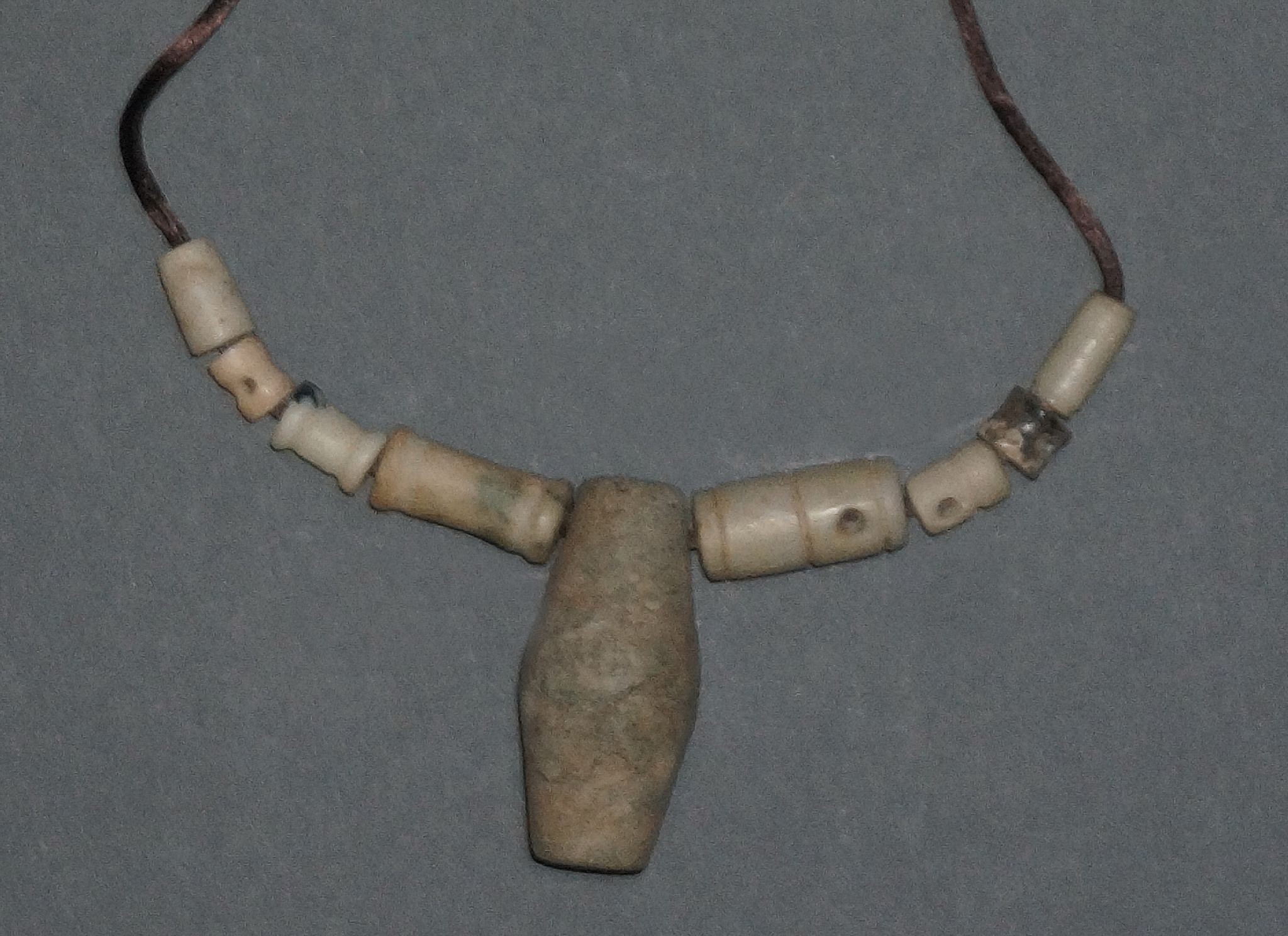
Dominican Republic, Taíno Necklace with Nine Carved Stone Beads in Varying Sizes
Necklace of nine Taíno carved stone cylindrical beads in a variety of sizes. It took great skill to drill long holes and sometimes even greater skill for small stones, as they often break in the drilling process.
Period: Dominican Republic, Taíno , c. AD 1000 - 1500
Media: Stone
Dimensions: Lenght: 1/4" to 2"
99379

Dominican Republic, Three Long Taíno Stone Beads
These unusually large and heavy stone shaped beads would have required great skill to be able to drill. These beads represent a variety of types of shapes, from slender to ribbed and tapered. Such large beads would have been reserved for high status individuals.
Period: Dominican Republic, Taíno , c. AD 1000 - 1500
Media: Stone
Dimensions: Length: 2" to 3.5"
99378

Dominican Republic, Set of Six Taíno Cylindrical Stone Beads
These beads are examples of the delicate craftsmanship that the Taíno employed even for the simplest of ornaments. Cylindrical beads were carefully shaped and drilled. It took great effort to drill longitudinally, especially if the bead was slender or long. The beads range in shape from cylindrical, to tapered, to plain discs (discoidal).
Period: Dominican Republic, c. AD 1000 - 1500
Media: Stone
Dimensions: Height: 1/4" to 2"
99377

Dominican Republic, Taíno Shell Square Dress Appliqué
This miniature shell appliqué belonged to a larger set that once covered the tunic of a chief. It's hard to imagine the time and care required to make such an ornament.
Period: Dominican Republic, Taíno , c. AD 1000 - 1500
Media: Shell
Dimensions: Height: 5/8 x Width: 6/8"
99370

Dominican Republic, 5 Taíno Canine Teeth Pendants
This rare, small group of matching canine teeth probably came from wild dogs and were drilled with suspension holes. In the Caribbean, the dog substituted for the mainland jaguar and was a primary predator, indicating fierceness and strength. These teeth were carved, sometimes with faces, perhaps representing deities. They would have been worn either as a single pendant or strung together in a group as a necklace.
Period: Dominican Republic, Taíno , c. AD 1000 - 1500
Media: Bone
Dimensions: Length Range: 1 to 1 1/2"
99355

Dominican Republic, Taíno Stone Belt Clasp
This stylized ornament is chipped on the right side, but originally had two matching ends. Taíno belt clasps are quite rare, as only a very few are known.
Period: Dominican Republic, Taíno , c. AD 1000 - 1500
Media: Stone
Dimensions: Length: 2"
99331

Dominican Republic, TaiÂno Group of 38 Shell Discs
These shell discs, used as a widespread form of currency, were typically made from the best queen conch shells (Stombus gigas), which lives in sea grass beds just off the shore. The discs were carefully string sawed from the pointed tips of the shells and then the hole was enlarged with a hard tool of crystal.
Period: Dominican Republic, Taíno , c. AD 1000 - 1500
Media: Shell
Dimensions: Diameter: average 3 to 5 mm
99374
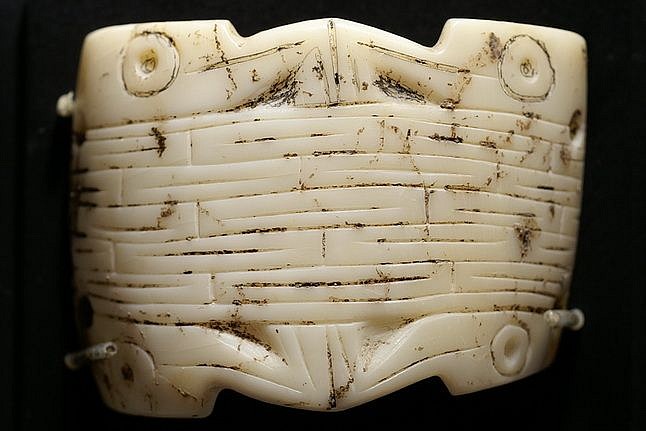


Dominican Republic, Taíno Shell Bracelet with Incised Opposing Birds
This bracelet is made from a large hard shell and incised with opposing birds' heads on the top and on the bottom, separated by rows of horizontal lines.
Period: Dominican Republic, Taíno , c. AD 1000 - 1500
Media: Shell
Dimensions: Width: 1 1/2" x Length: 2 1/4"
98235





Dominican Republic, Four Taíno Shell Bracelets with Abstract Frog Imagery
Frogs are considered symbols of fertility in Taíno religion. The central circle design represents the navel, or axis mundi, that pierced the center of the earth and was a conduit that led to the spirits and ancestors of the otherworld.
Period: Dominican Republic, Taíno , c. AD 1000 - 1500
Media: Shell
Dimensions: Length Range: 1 1/4 to 2 1/4"
99333

Dominican Republic, Six Taíno Bone and Shell Bracelet Elements
These ornaments have two drilled holes at either end. They were used as either bracelet elements or necklace clasps. It is hard to find shell ornaments with such good patina still intact.
Period: Dominican Republic, Taíno , c. AD 1000 - 1500
Media: Other
Dimensions: From left: 1 1/4, 1 3/4", 2.5", 1.5", 1 1/4", 1"
98372B



Dominican Republic, 9 Taíno Shell, Bone and Clay Ear Ornaments
These earspools are typical of the types worn by the Taíno and their predecessors from the Amazon Basin of South America. They are still worn today by contemporary tribes in the Amazon.
Period: Dominican Republic, Taíno , c. AD 1000 - 1500
Media: Shell
Dimensions: Height: 1 to 2 1/4"
99351
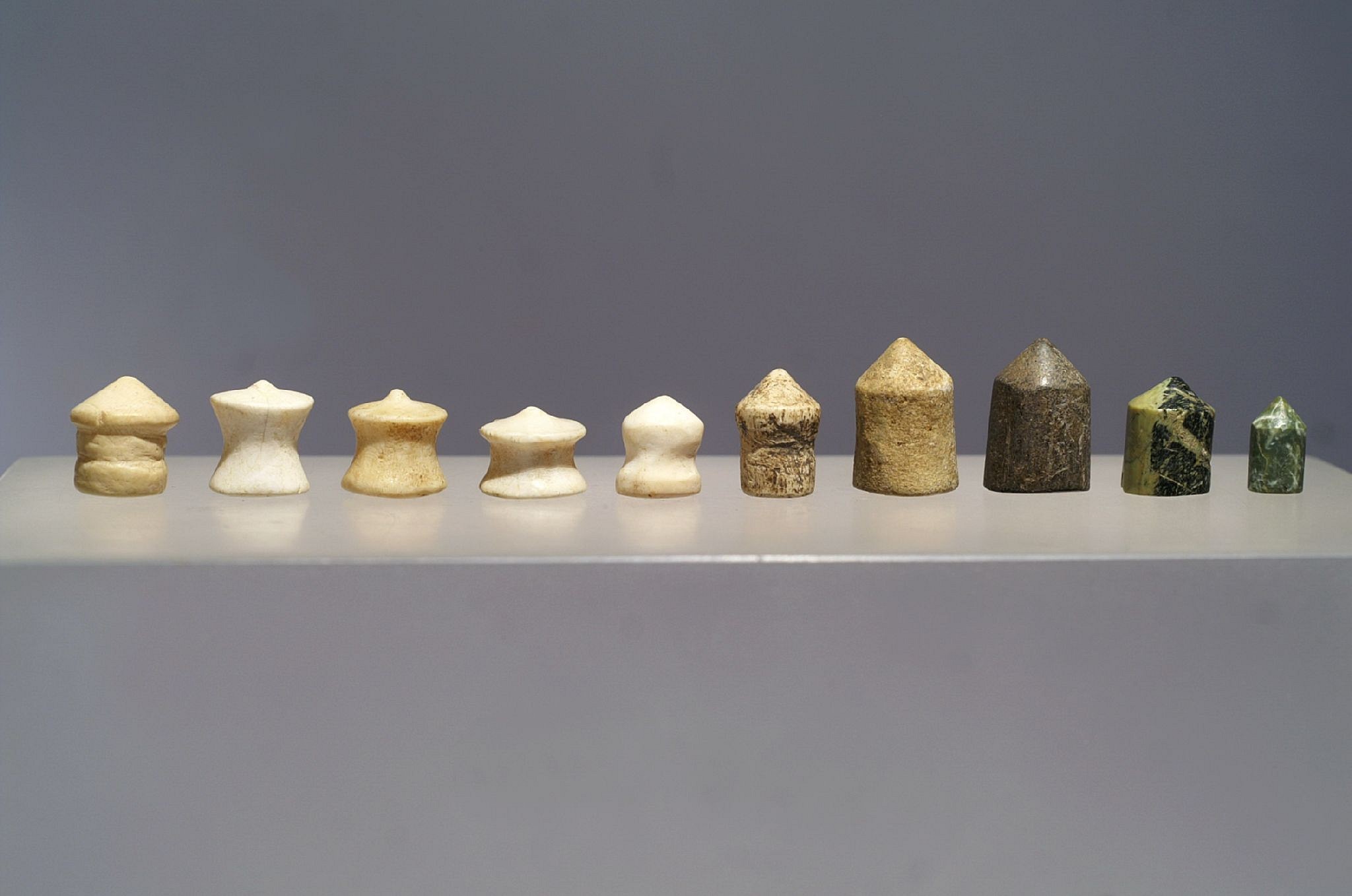



Dominican Republic, Ten Taíno Stone Lip Labrets
Conically shaped labrets are unique to the Taíno . These labrets were made from a wide variety of stones including agate, marble, and serpentine. Labrets were usually reserved for facial décor for people of status.
Period: Dominican Republic, Taíno , c. AD 1000 - 1500
Media: Stone
Dimensions: Height Range: 1/4 to 1/2"
99352







Dominican Republic, Taíno Large Ceramic Vessel with Winged Bats
This large feasting bowl would have been used when the Taíno held large festivals in the plazas of their communities, during which singing, dancing and ball games could last for days. Part social and part ritual, shamans and chiefs would go into trances to communicate with spirits and ancestors during these festivals. The bat is a common motif in Taíno art, and symbolized spirits and ancestors in the otherworld. This type of vessel is found in the Dominican Republic and is considered a good size.
Period: Dominican Republic, Taíno , c. AD 1000 - 1500
Media: Ceramic
Dimensions: Height: 5" x Diameter: 11" inches
99524
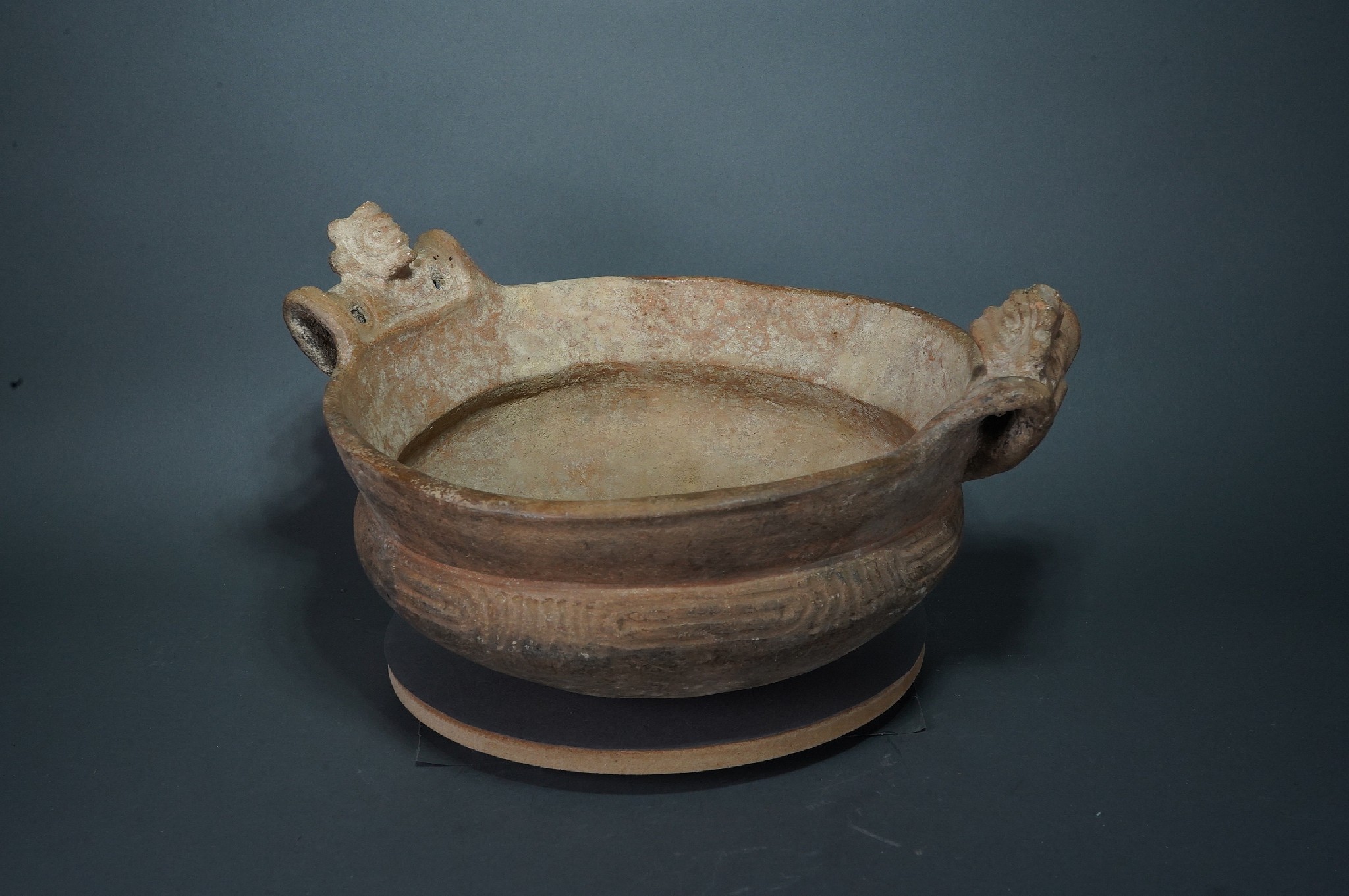








Dominican Republic, Pre-Taíno (Igneri) Ceramic Bowl with Bat Shaped Handles
The Igneri were Arawak-Ostoinoid people who inhabited the Greater Antillies from the third through tenth centuries. Their ceramics can be identified by the bat shaped handles, broadly incised designs and tiered bases. The Ostionoid Igneri inhabited the zone around Altos de Chavon, and similar vessels are discussed and illustrated in Commemorative Catalog, 1992: 15 and 47.
Period: Dominican Republic, Ostionoid, c. AD 200 - 900
Media: Ceramic
Dimensions: Height: 5" x Width 8"
99160






Dominican Republic, Taíno Ceramic Bowl with Geometric Incised and Opposed Linear Tab Handles
The Igneri were Arawak-Ostoinoid people who inhabited the Greater Antillies from the Third through Tenth centuries. Their ceramics can be identified by the bat-shaped handles, broadly incised designs, and tiered bases. The Ostionoid Igneri inhabited the zone around Altos de Chavon, and similar vessels are discussed and illustrated in an Altos de Chavon commemorative catalog published in 1992.
Period: Dominican Republic, Taíno , c. AD 1000 - 1500
Media: Ceramic
Dimensions: Height: 7" x Width: 12"
99227






Dominican Republic, Taíno Ceramic Libation Bowl
This small bowl has a rim of which dips on two sides and was used to drink during ceremonies. The bowl has nice proportions and can be comfortably held in two hands. Has well defined roo
Period: Dominican Republic, Taíno , c. AD 1000 - 1500
Media: Ceramic
Dimensions: Height: 2 1/4" x Width: 4 3/4"
99151
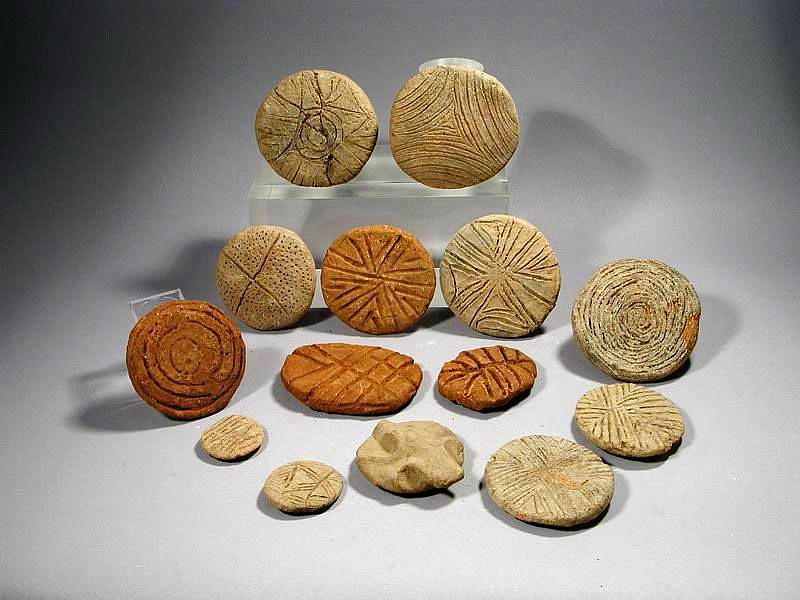
Dominican Republic, Taíno Group of 14 Round Ceramic Seals or Stamps
This eclectic group of ceramic seals of is decorated with various geometric designs, one with zoomorphic motif (frog or bat) on the grip. The Taíno dipped these stamps in pigments made from crushed bija and jagua seeds and then imprinted them on their own skins for ceremonial events. Similar examples are illustrated in "Altos de Chavon", p. 28.
Period: Dominican Republic, Taíno , c. AD 1000 - 1500
Media: Ceramic
Dimensions: Largest diameter: 3"
smallest diameter: 1 1/4"
99155

Dominican Republic, Taíno Ceramic Top to a Jar Depicting a Bat's Head
Large jars were often made with narrow spouts and decorated with effigies. This is one of those spouts and is unusual as depicts a bat which is very rare in Taíno art.
Period: Dominican Republic, Taíno , c. AD 1000 - 1500
Media: Ceramic
Dimensions: Diameter 3" x Height 4"
M4055
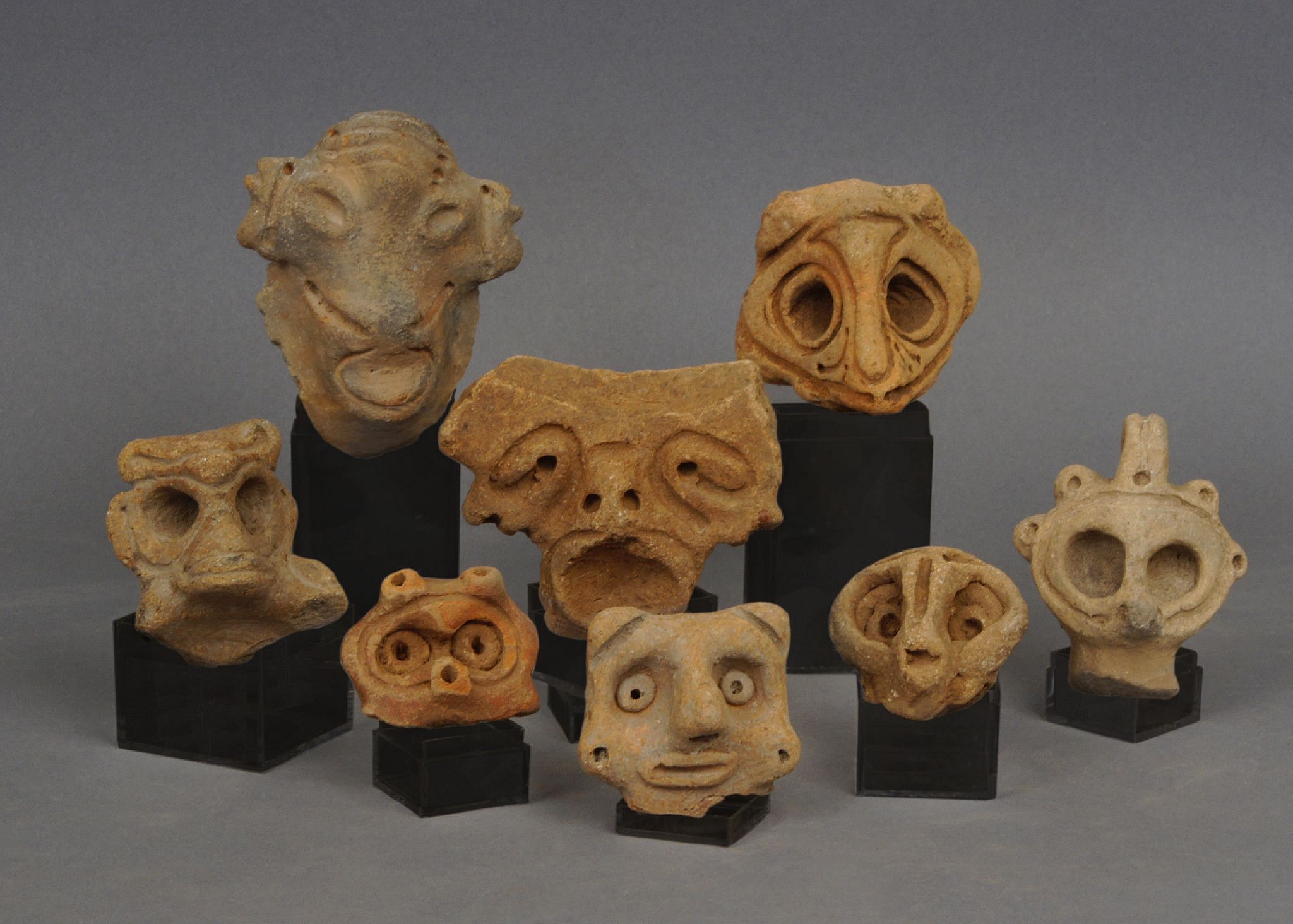
Dominican Republic, Set of 8 Taíno Ceramic Anthropomorphic Faces
These heads were used as adornos (decorative handles) on ceramic plates and bowls.
Period: Dominican Republic, Taíno , c. AD 1000 - 1500
Media: Ceramic
Dimensions: Approximately. 1-3" in height.
99450
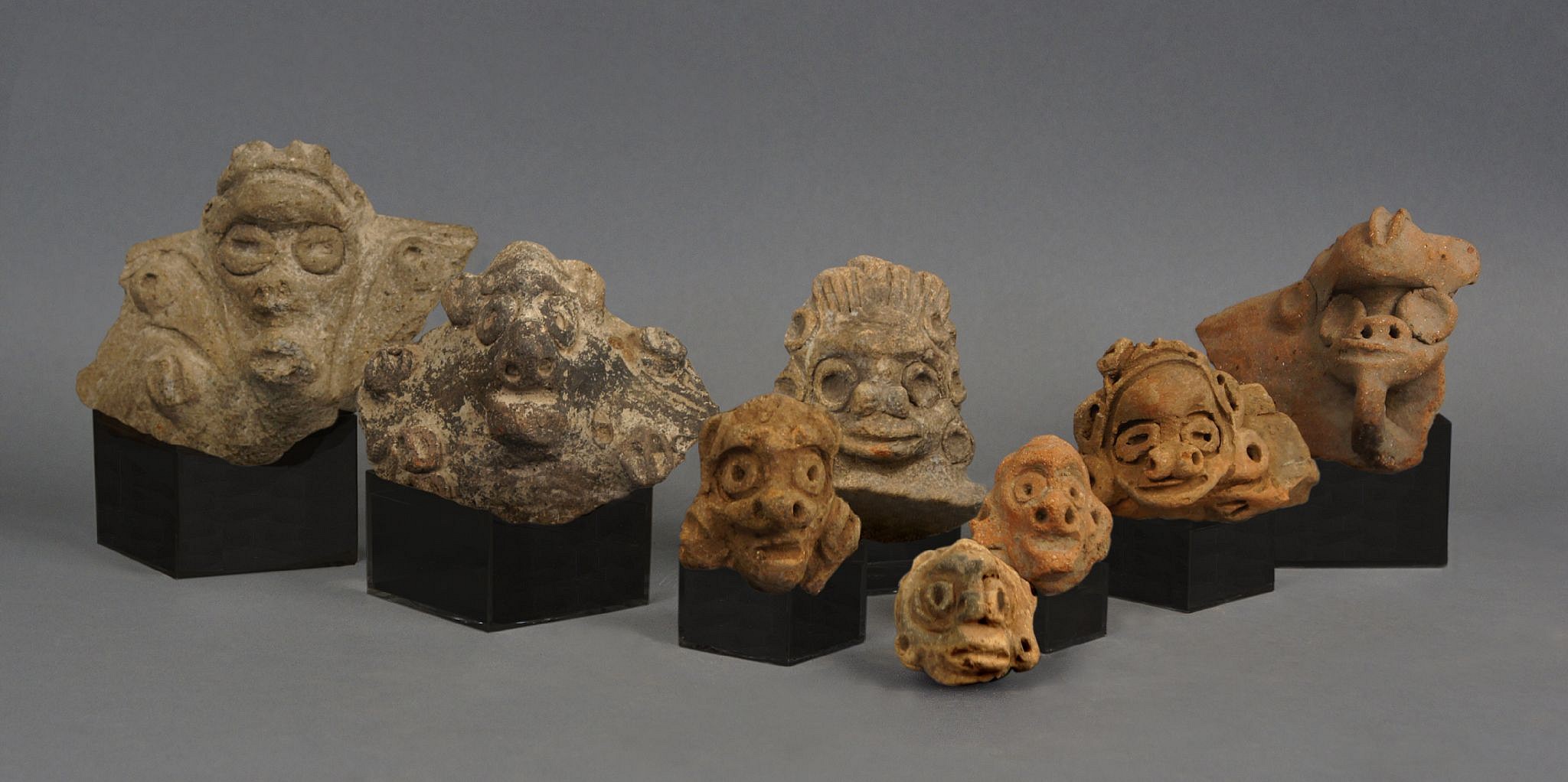
Dominican Republic, Set of 8 Taíno Ceramic Animal Faces
These anthropomorphic animal heads were used as adornos (decorative handles) on ceramic plates and bowls.
Period: Dominican Republic, c. AD 1000 - 1500
Media: Ceramic
Dimensions: Approx. 1-3 in.
99452
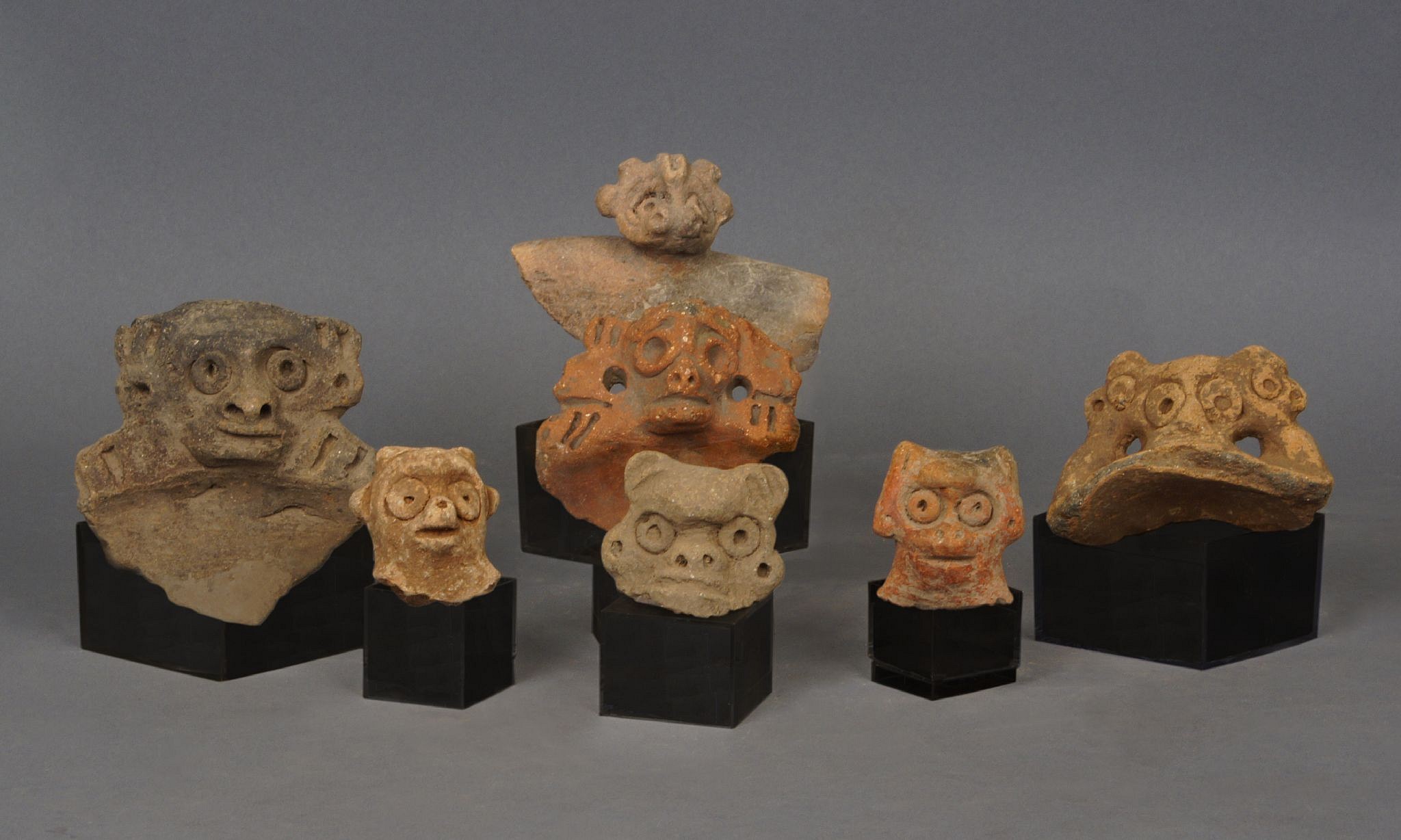
Dominican Republic, Set of 7 Taíno Ceramic Animal Faces
Period: Dominican Republic, c. AD 1000 - 1500
Media: Ceramic
Dimensions: Approx. 1-2 1/2"
99451

Dominican Republic, Set of 7 Taíno Ceramic Animal Faces
Each of these faces were adornos that broke off from vessels. Adornos were almost like handles and placed on each end of the bowl or dish. Most adornos were simple or with some insizing,
Period: Dominican Republic, Taíno , c. AD 1000 - 1500
Media: Ceramic
Dimensions: Height: 1" to 2"
99543






Dominican Republic, Taíno Bone Drilling and Incising Marker
The hollow bone tube has marks and different size drill holes used to determine the size of a drill bit. The cross hatch indicated the thickness of a scribe tool.
Period: Dominican Republic, Taíno , Early Classic Period, c. AD 600 - 1000
Media: Bone
Dimensions: Length: 1 3/8"
98501

Dominican Republic, 3 Taíno Stylized Shell Carving Tools
These three beautiful stylized shell carvings were used as tools for burnishing and incising clay objects.
Period: Dominican Republic, Courian Subseries, c. 2000 BC - AD 250
Media: Shell
Dimensions: Length: 2 in, 1.5 in, and 1.5 in.
99660

Dominican Republic, Taíno Shell Eye Inlay with Circular Motifs
Circular shell ornaments of this type were used as inlays for the eyes of zemi statues. The interior "void" pupil area was usually filled with gold or black shell.
Period: Dominican Republic, Taíno , c. AD 1000 - 1500
Media: Shell
Dimensions: Diameter: 1 1/4"
99216

Dominican Republic, Two Taíno Carved Shell Discs that Could be Eyes for a Idol
The shell with the central hole could have had a center pupil in a different material, and may have been part of a larger sculpture. The other shell has its pupil indicated by small drill holes around the center hole.
Period: Dominican Republic, Taíno , c. AD 1000 - 1500
Media: Shell
Dimensions: Diameter: 1 5/8"
99312



Dominican Republic, 5 Taíno Shell Disc Ornaments
These discs were of unknown use and vary in size and thickness. These could have been eyes or inlays for larger idols.
Period: Dominican Republic, Taíno , c. AD 1000 - 1500
Media: Stone
Dimensions: Diameter Range: 3/8" to 1 "
99358

Dominican Republic, 8 Taíno Carved Shell Beads in Varying States of Completion
These different shells reveal the carving process of the ancient Taíno craftspeople. These shell beads would likely have been intended for teeth or eyes, or for necklace elements.
Period: Dominican Republic, Taíno , c. AD 1000 - 1500
Media: Shell
Dimensions: Height: 1/2"
99382
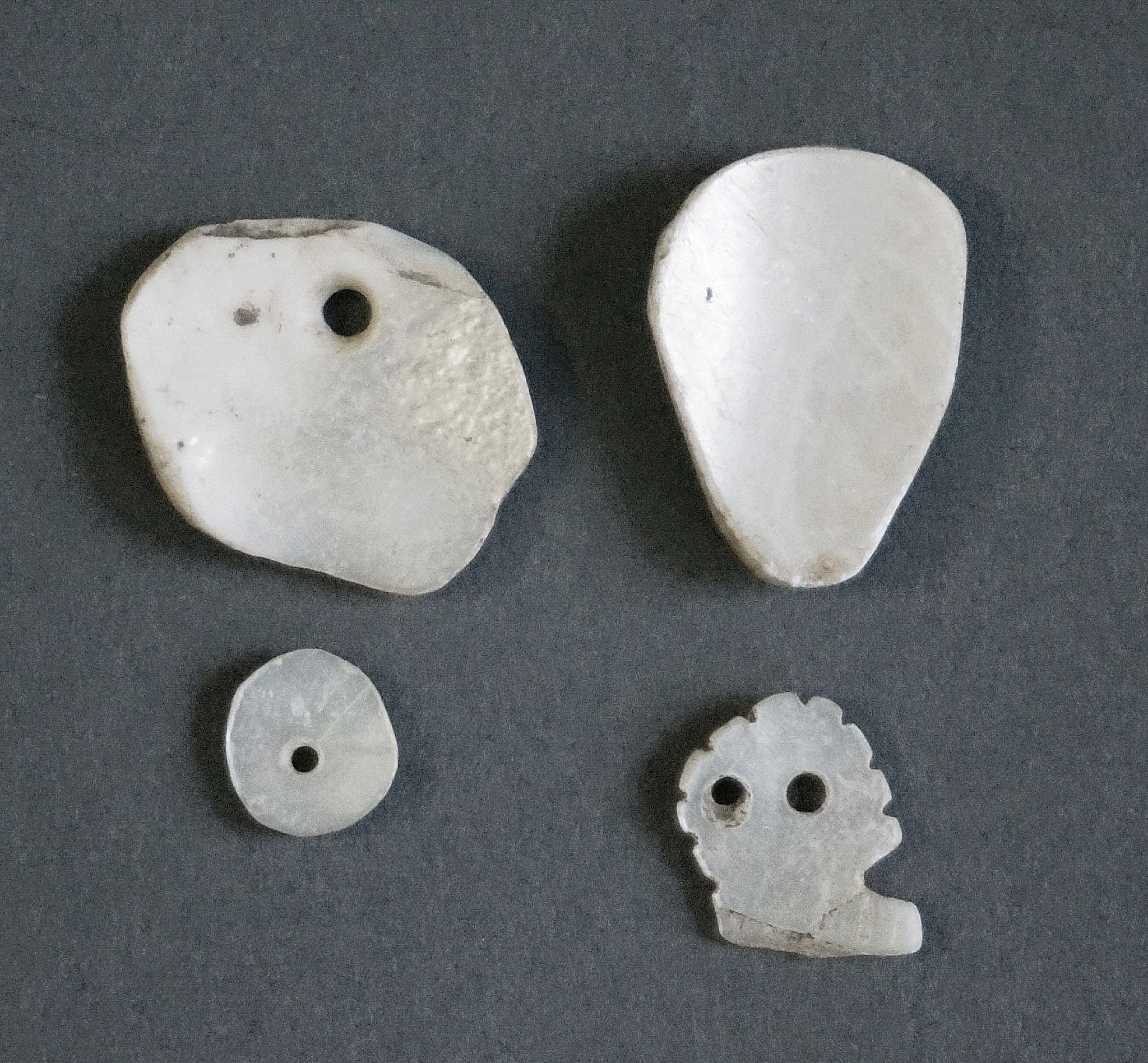
Dominican Republic, Four Taíno Carved Mother of Pearl Beads
These four delicately carved beads are made from a pearlescent species of ocean shell, likely a clam or mollusk. The shells are thin and tend to break if drilled or carved. It is quite rare to find them intact.
Period: Dominican Republic, Taíno , c. AD 1000 - 1500
Media: Shell
Dimensions: Length: 1/4" to 7/8"
99389

Dominican Republic, Taíno Shell Necklace Section on the Original Hemp Cord
There are 22 matching square-shaped shell beads each with a drilled hole in the center. The individual beads are almost identical in size and shape and were originally part of a longer choker style necklace. Each bead is elaborately attached both to each other and to the braid. There are 8 paired cords of string making up the choker and 4 paired cords run through the bead hole, using a complicated technique of bead stringing without the use of knots. The cord and the beads are from an original necklace. It’s quite rare to find the original hemp cord intact.
Period: Dominican Republic, Taíno , Early Classic Period, c. AD 600 - 1000
Media: Shell
Dimensions: Length of section: 2" Size of bead: 5/16"
99380
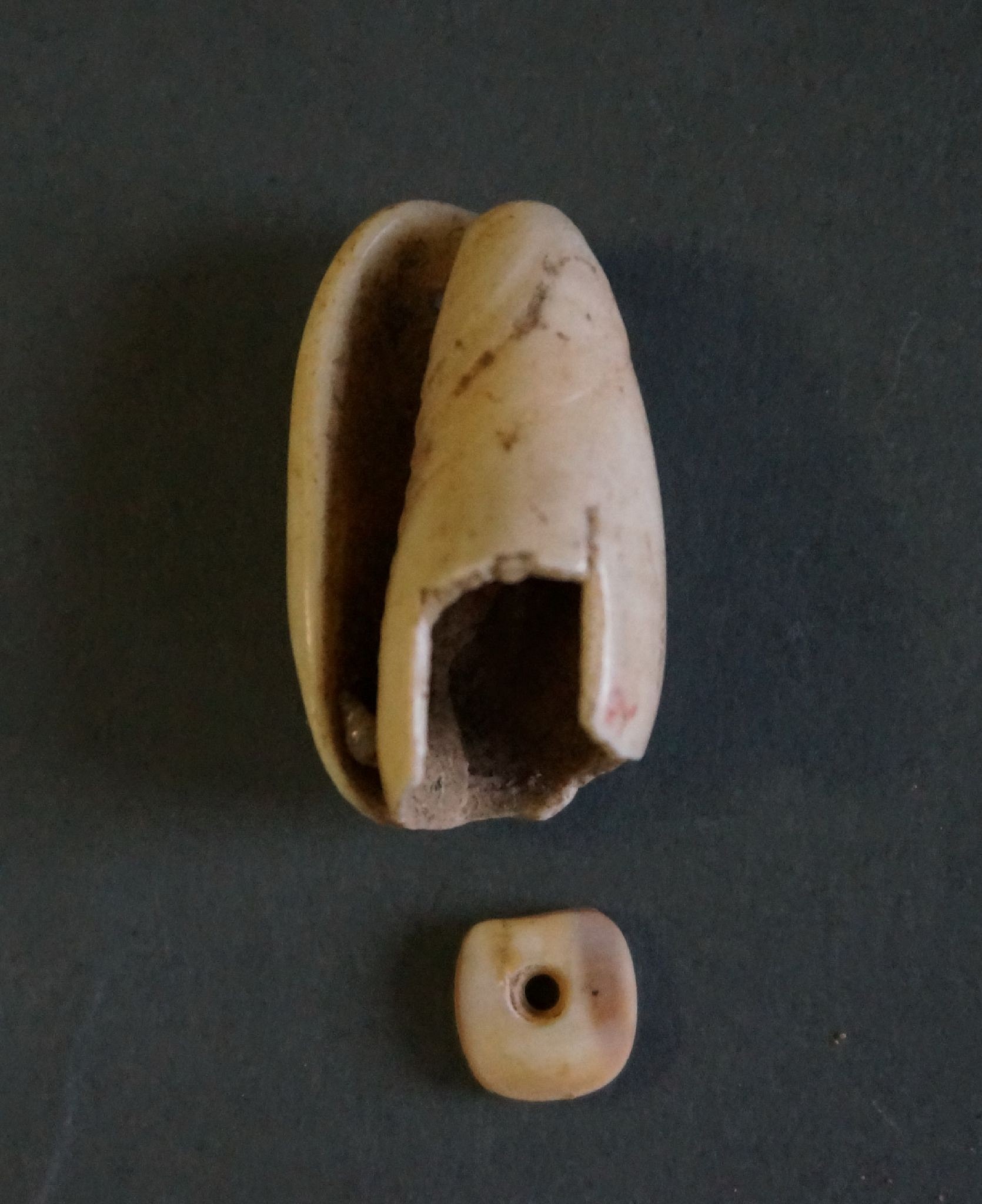
Dominican Republic, Taíno Carved Shell with Matching Bead
These snail shells were in abundance and made both individual cut beads as well as utilizing the entire shell as a single necklace element. They appear to be crafted from the same shell.
Period: Dominican Republic, Taíno , c. AD 1000 - 1500
Media: Shell
Dimensions: Height: 1/2"
99381
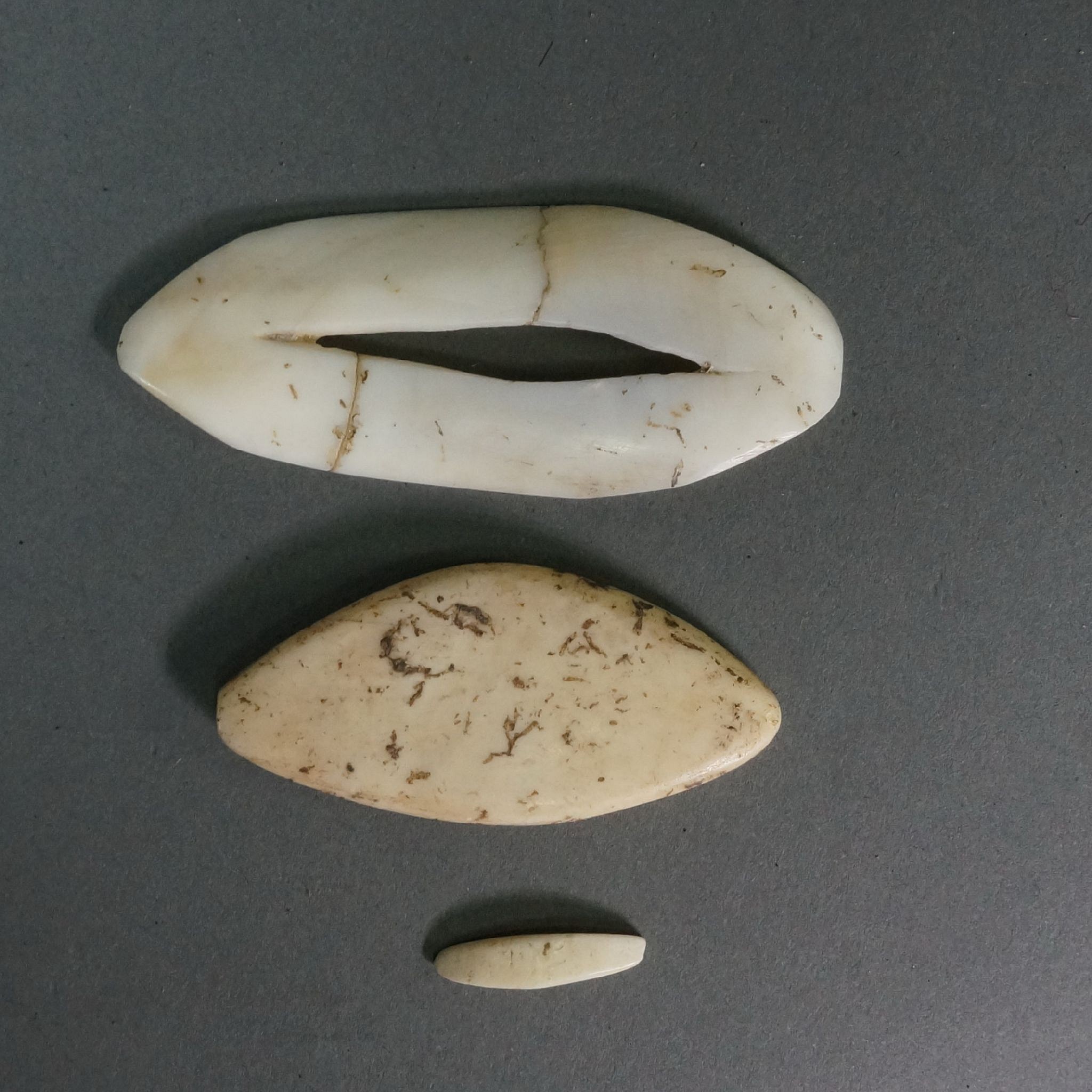
Dominican Republic, Set of 3 Taíno Ovoid Shell Mouth Elements
These three carved shells demonstrate the differing degrees of complexity in fabricating miniature stone mouths, with the largest being a completed open mouth and the other two as incomplete mouths. These mouth elements would likely have been inlaid into a larger wood or stone carved idol or deity figure
Period: Dominican Republic, Taíno , c. AD 1000 - 1500
Media: Shell
Dimensions: Width: 3/4" to 2 5/8"
99525

Dominican Republic, Taíno Shell Teeth Inlay
This type of inlay represents a set of teeth that were set into the mouth cavities of zemi spirit images. In this case, the large size of the inlay suggests that it was placed in the mouth of a wooden figure or statue. The size and the thickness indicate that it must have been carved from a very large bivalve.
Period: Dominican Republic, Taíno , c. AD 1000 - 1500
Media: Shell
Dimensions: Length: 2 1/2"
99334



Dominican Republic, 2 Sets of Taíno Carved Oblong Shaped Teeth
The oblong shaped sets of teeth were to be inserted into wood carvings with deep profiles like serpents or crocodiles. The larger set is tapered at the back to fit into a deep mouth.
Period: Dominican Republic, c. AD 1000 - 1500
Media: Shell
Dimensions: Length: 3/8" to 1 1/2"
99528
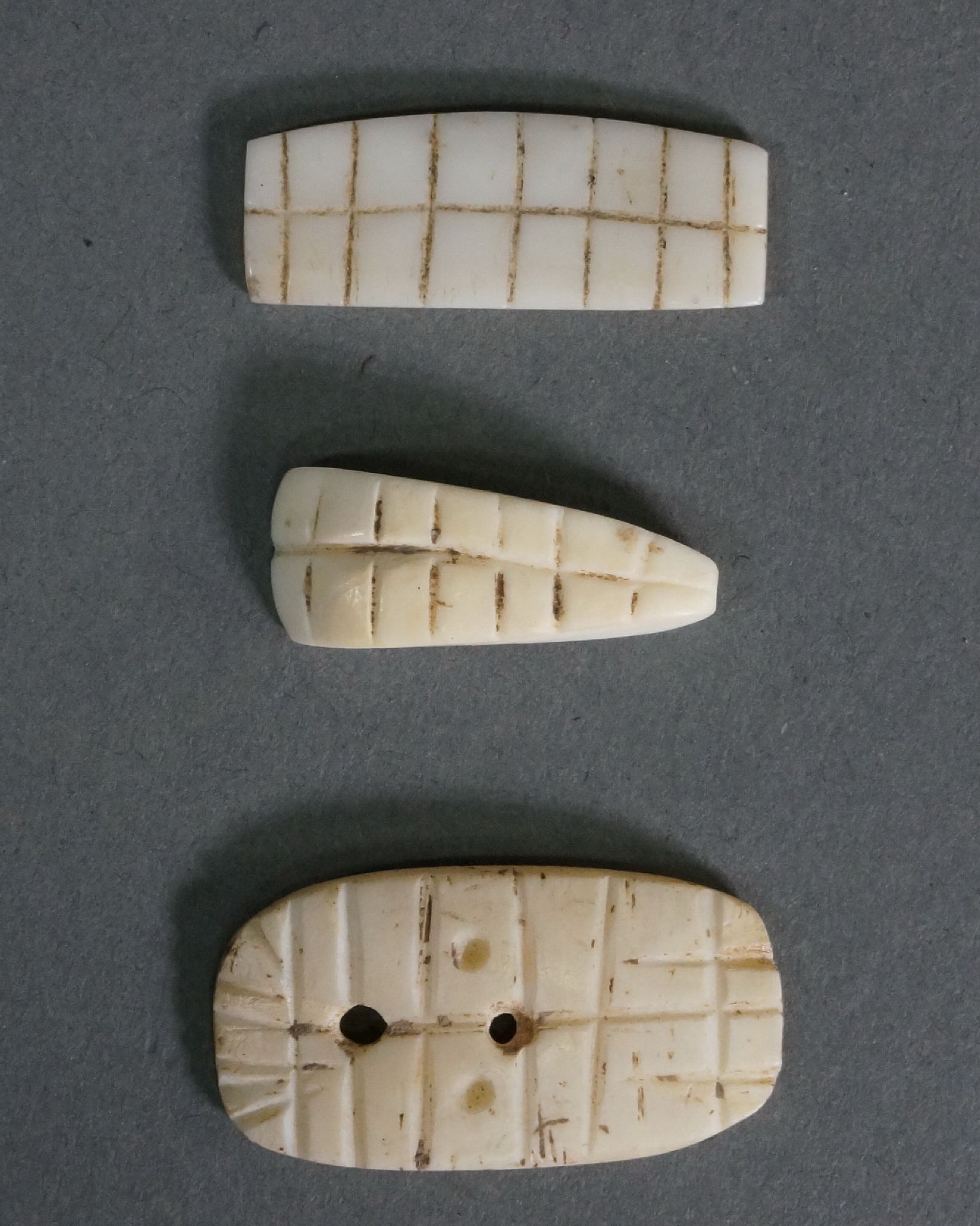


Dominican Republic, 3 Sets of Taíno Carved Shell Teeth
These teeth show the variety of different shaped teeth. The teeth were string saw cut. Shell teeth were set into figurative amulets or wood carvings or strung on a necklace.
Period: Dominican Republic, c. AD 1000 - 1500
Media: Shell
Dimensions: Width: 3/4" to 1 1/4"
99526







